November 1
A slight digression. For those of you who have wondered what I think is the greatest invention ever made by man, I want to put your anxiety to rest. It’s the shower. I mean, the wheel was good, too, I suppose, but the shower was shear genius. I was reminded of that this morning, showering at the Imperial.
Moving on, now, with the day, we breakfasted at the hotel and then met the real reason we came to Delhi, Punam Ghandi. Punam (she correctly predicted that we’d never forget her name if we thought of “shayna Punam”) is the fabulous guide we fell in love with on our first trip to India, thirteen years ago, and saw again when we went to the South of India. She’s a great conversationalist on any topic, exceedingly honest and extremely knowledgeable, to boot. She’s become more of a friend than a guide, and we just wanted to hang out with her.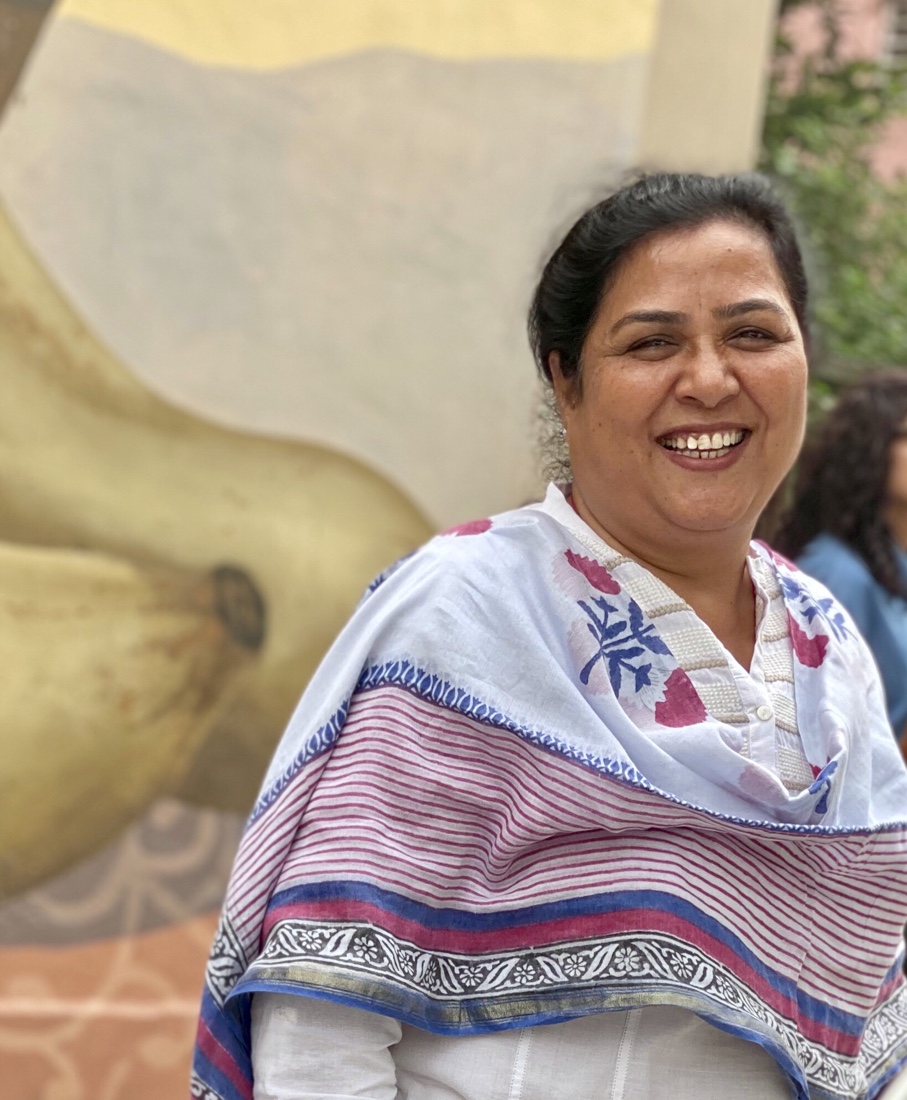
And that’s what we did. Carol still has a pretty bad cough and was not anxious to spend time outside, because of the poor air quality (and the heat did not seem attractive, either). Especially being the last day of our trip we wanted to take it easy. When we told her we’d enjoy seeing some art, she suggested that we see if Rohit Kaicker was around and, if so, go over to his gallery, located in his home, to see his fabulous collection and listen to his expertise about the art he collects.
Rohit was home, so we went over to his gallery and spent an hour and a half looking at and talking with him about his outstanding collection, which he says is a hobby that he picked up from his father. Clearly, this is much more than what we would consider a hobby, as he has rooms full of exquisite work.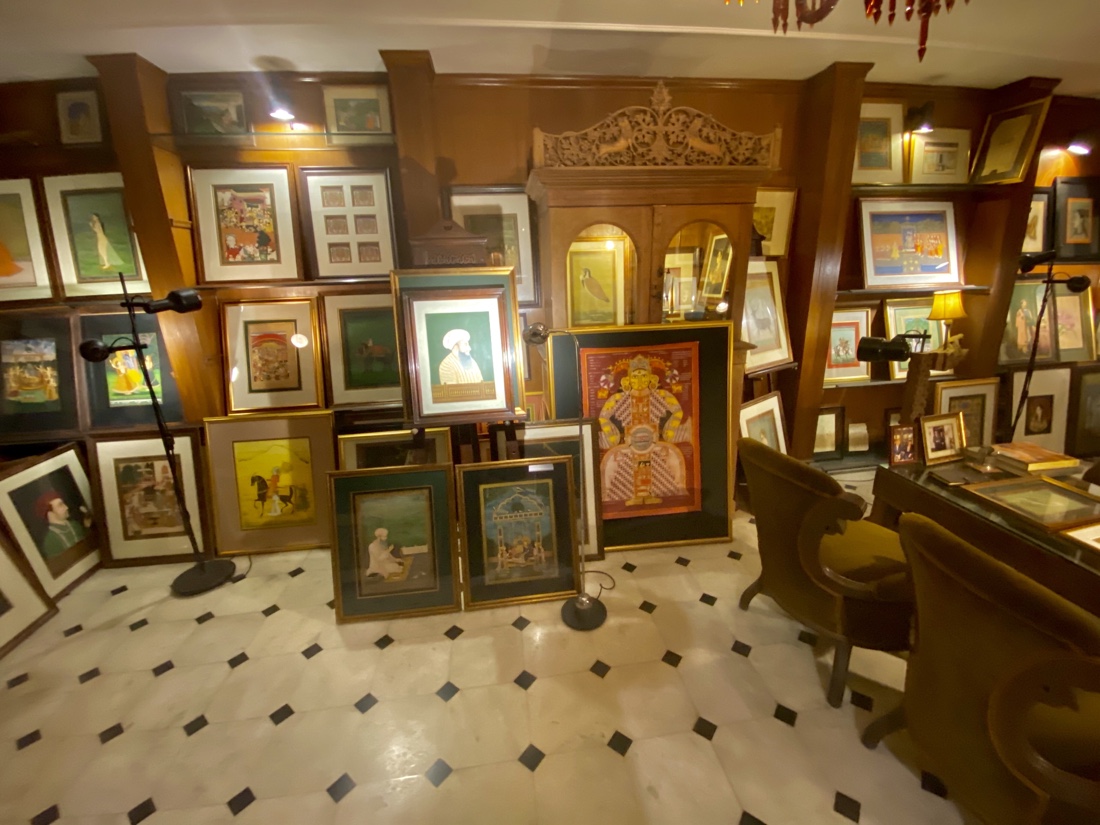
You may recall that Carol and I were both blown away by the miniatures we saw in the palace museum at Jodhpur. That was the kind of work Rohit collects, a good deal of which is of a quality comparable to the museum work. We were able to examine the minute squirrel tail brush work on these pieces with a magnifying glass to appreciate the detailed work. We wound up buying an outstanding piece (more than twice the price of some very nice other pieces he showed us) and I look forward getting it home, framed and hung. It will make a great addition to our eclectic collection. We can be confident of its quality, not only because Rohit told us so (Punam had said about Robit before we went to see him that he was “too honest”), but because when we walked through his home, one of the pieces hung in his private collection was part of the same series as the one we purchased,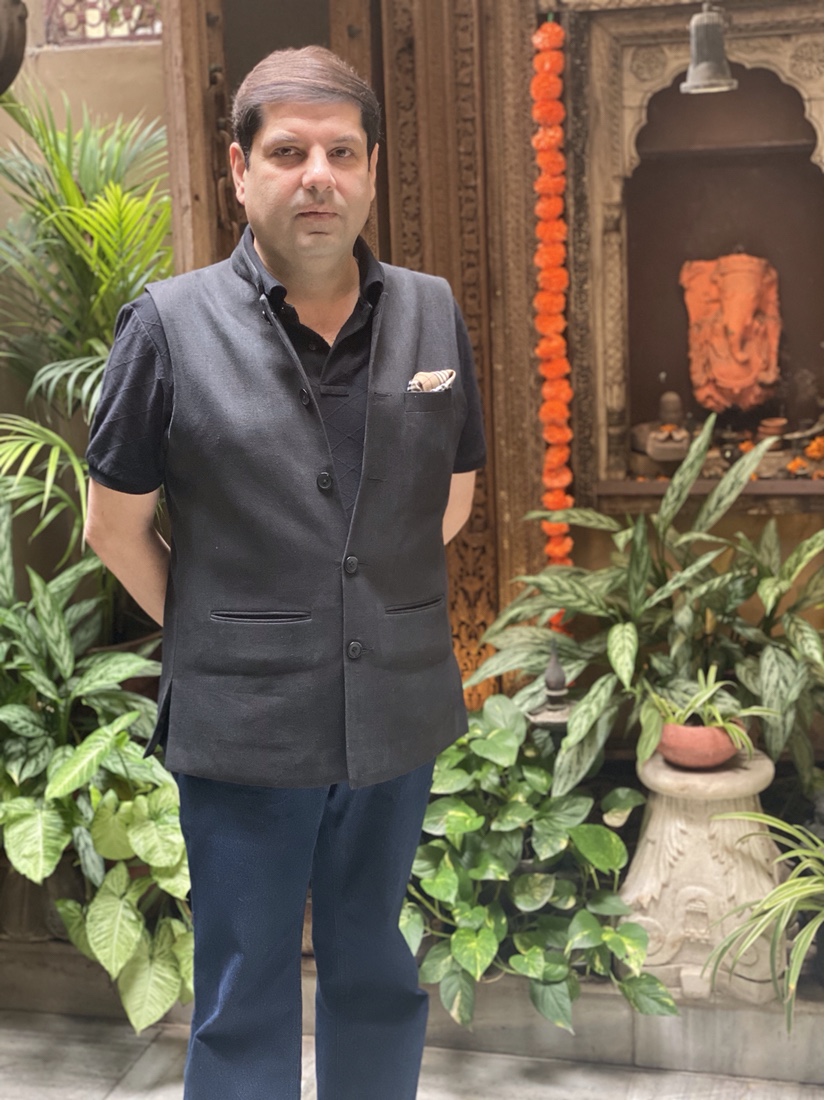
From Rohit’s house we drove to the National Modern Art Museum and walked through the collection. While there were some pieces we liked, for the most part we were not impressed. We drove by an area in which rather amusing paintings had been done on buildings that were not of the quality of the graffiti art I’d seen in Joburg in April, but fun to see.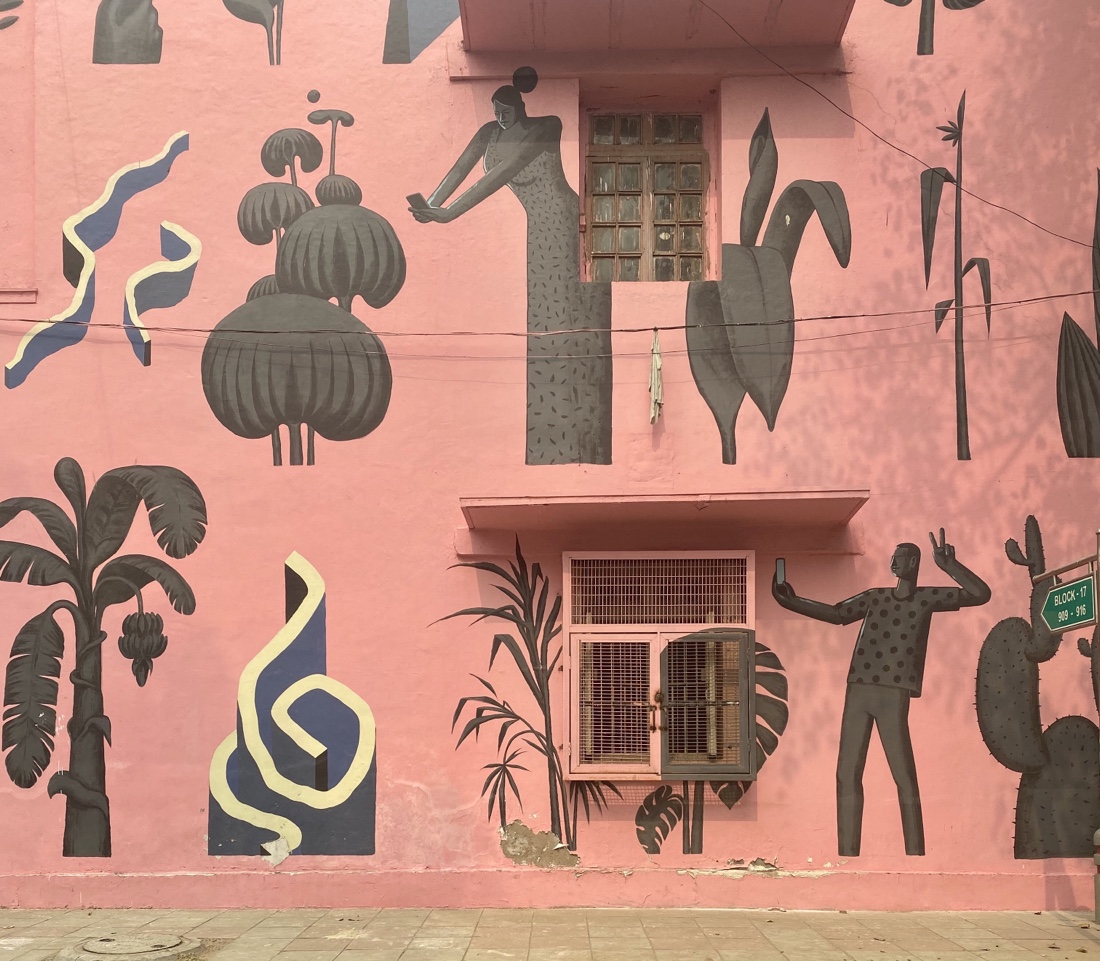 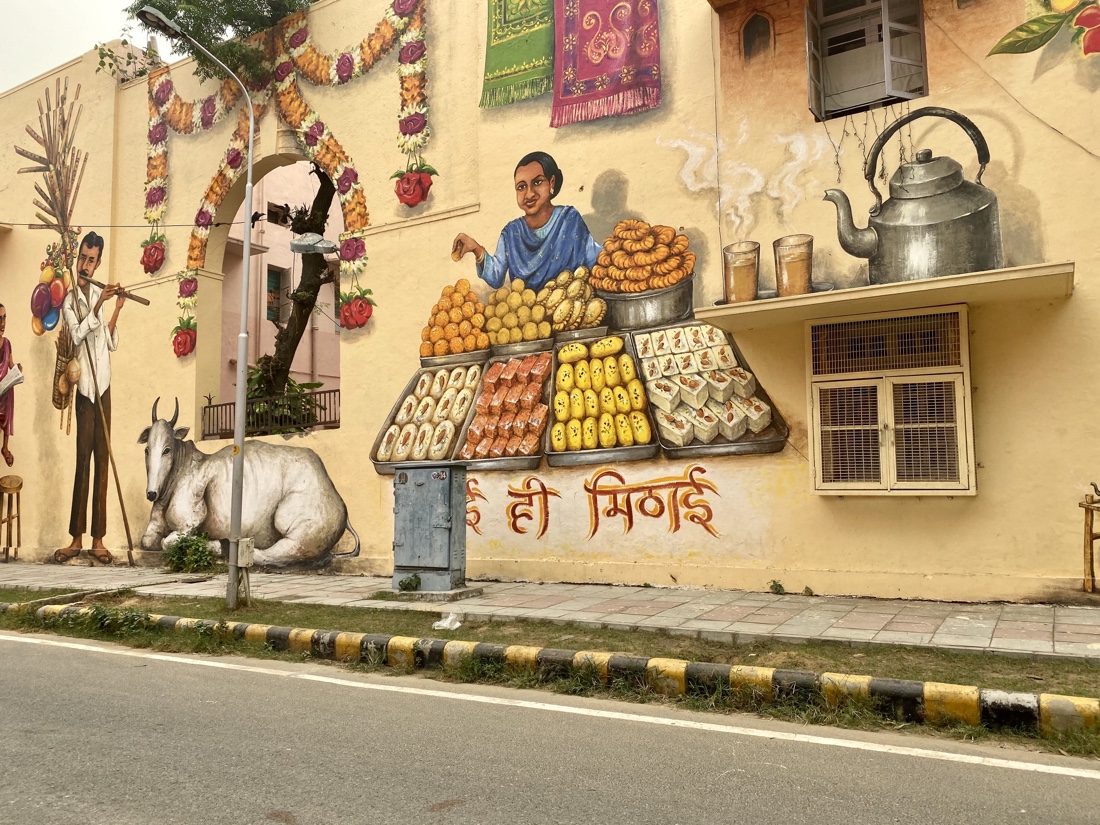 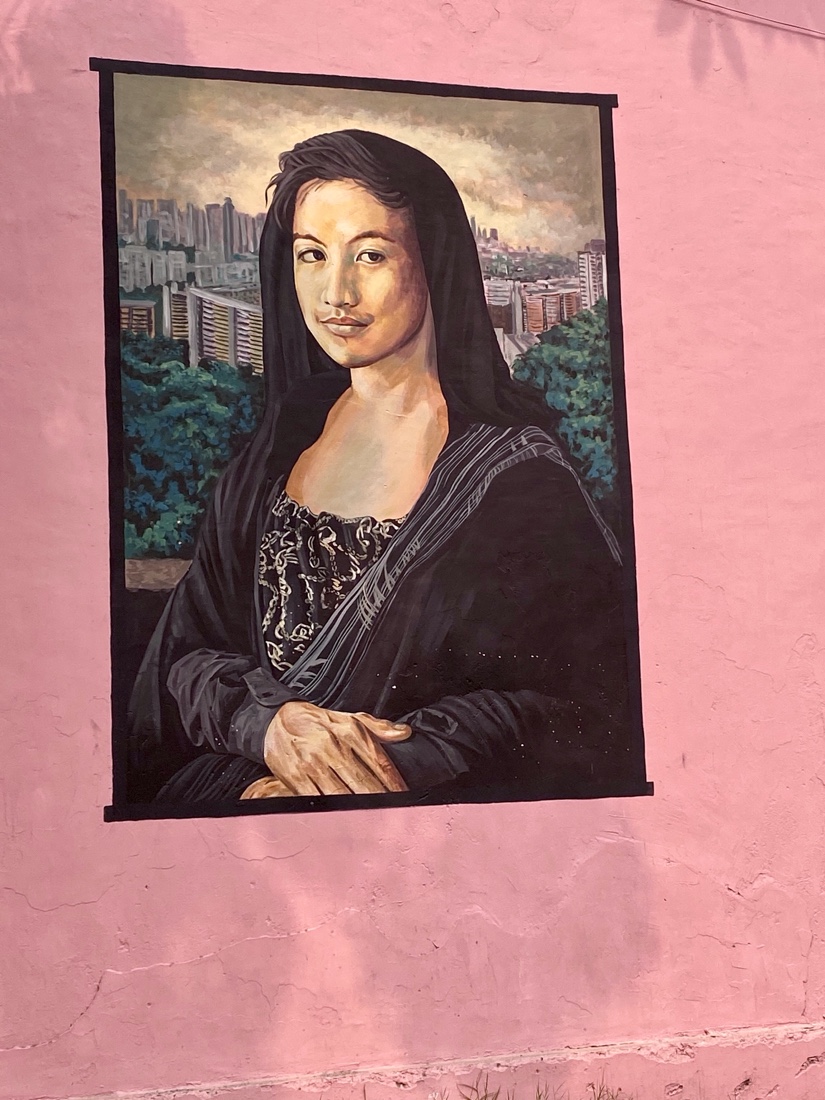
We then went to lunch with Punam at Basil and Thyme, a small and unpretentious restaurant with excellent food. From there we went to another area to do some last-minute, small shopping, which was only partially successful. As it was already almost 4PM, we decided to declare victory and head back to the hotel, where we napped, had dinner, packed and prepared for the midnight pick-up for our 3:20AM departure for home, via London.
I’m posting this from the Business Class Lounge in London. Final post will be a reflection on the trip. If you’re still with us, you might as well stick around and find out whether we had a good time.
October 31
Ladies and gentlemen, boys and girls, how many of you know the story of Bullet Baba? Okay, then, listen up.
On Dec 2, 1991, a young man named Om Banna was riding his motorcycle on the road 33 miles from Jodhpur when he lost control, hit a tree and was killed. The bike was taken to the police station, but the next morning, it appeared mysteriously again at the accident site. It was taken back to the police station several times, chained and fuel removed, but each time it reappeared at the accident site. To commemorate this miracle, a temple was built at the accident site and each day hundreds of people come to pray, bring offerings, touch the bike which is housed there and take photos of strange people like us with their phones. This, it is thought, will assure the devotees of safe passage in their journeys. Here was the scene today.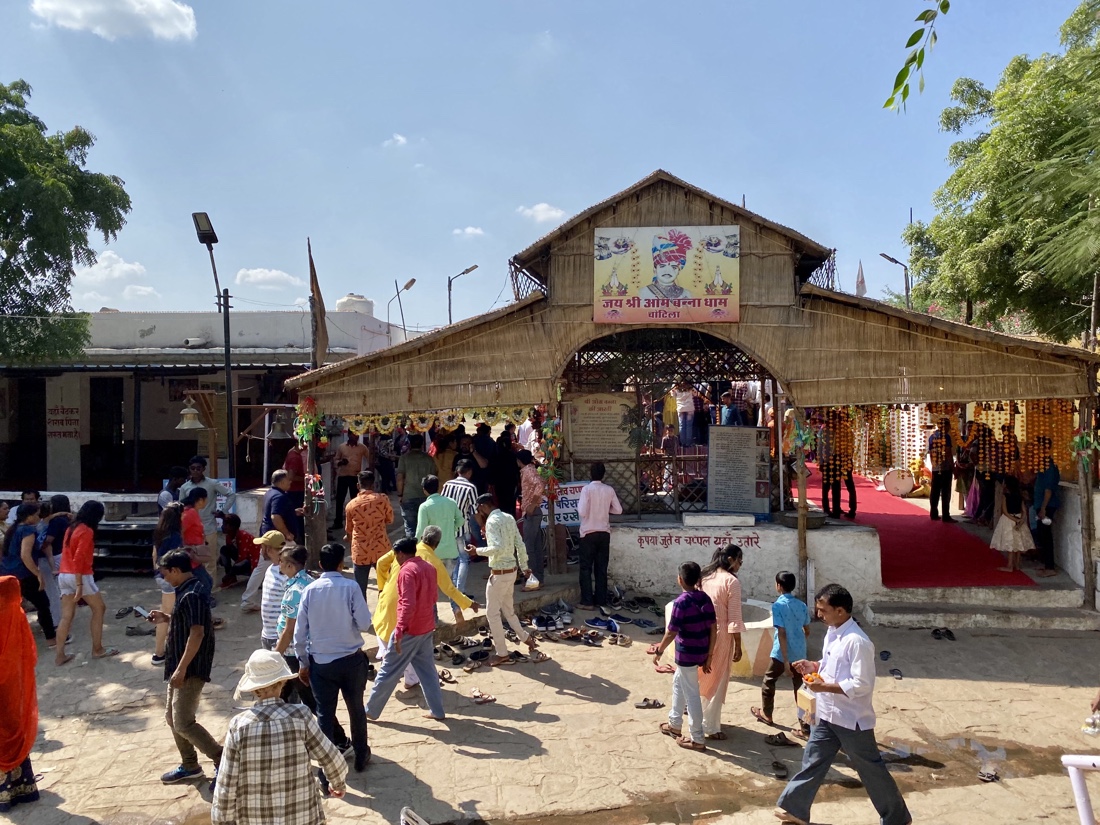 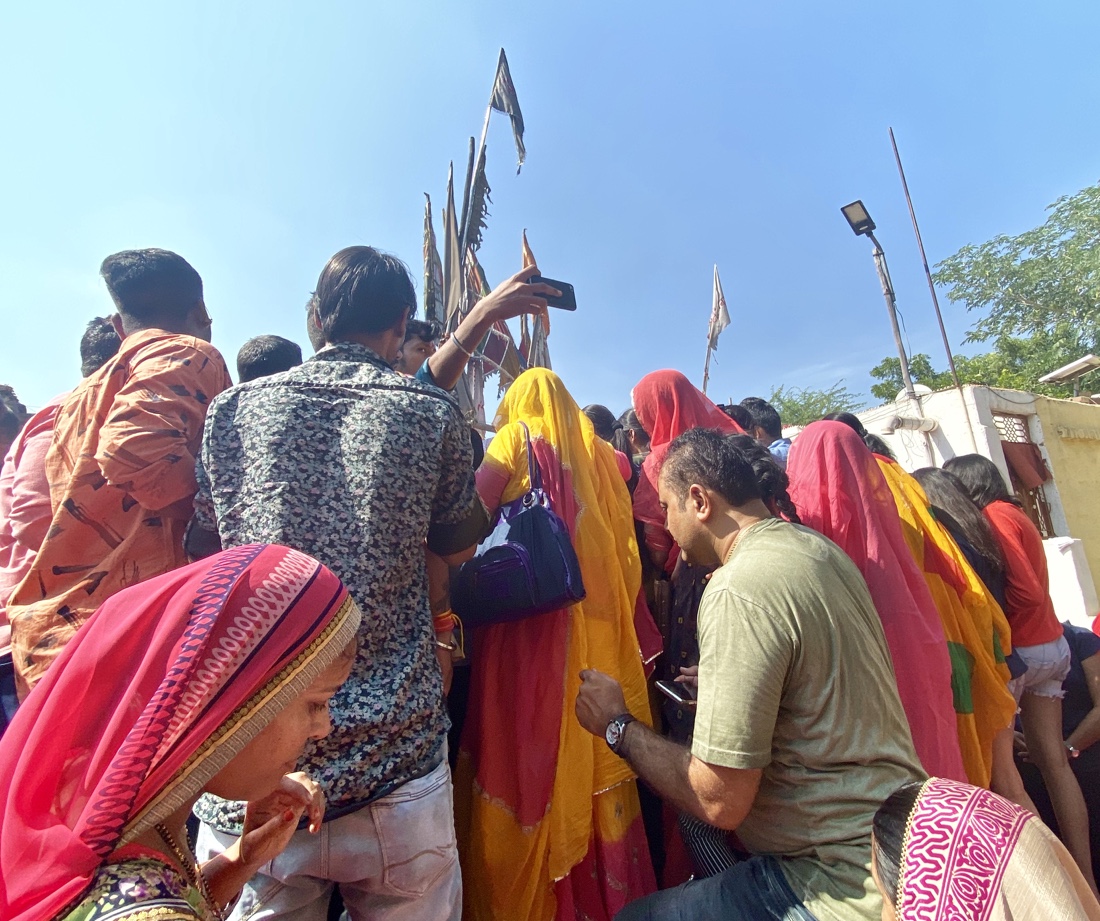 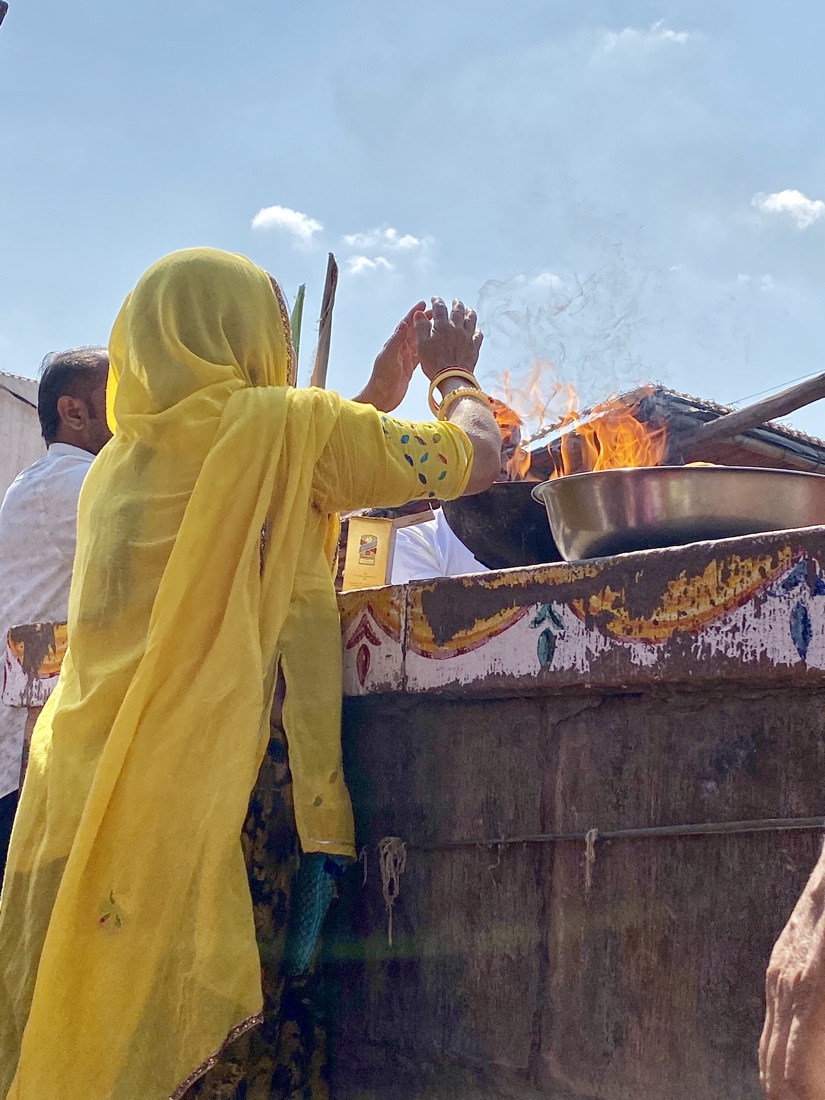 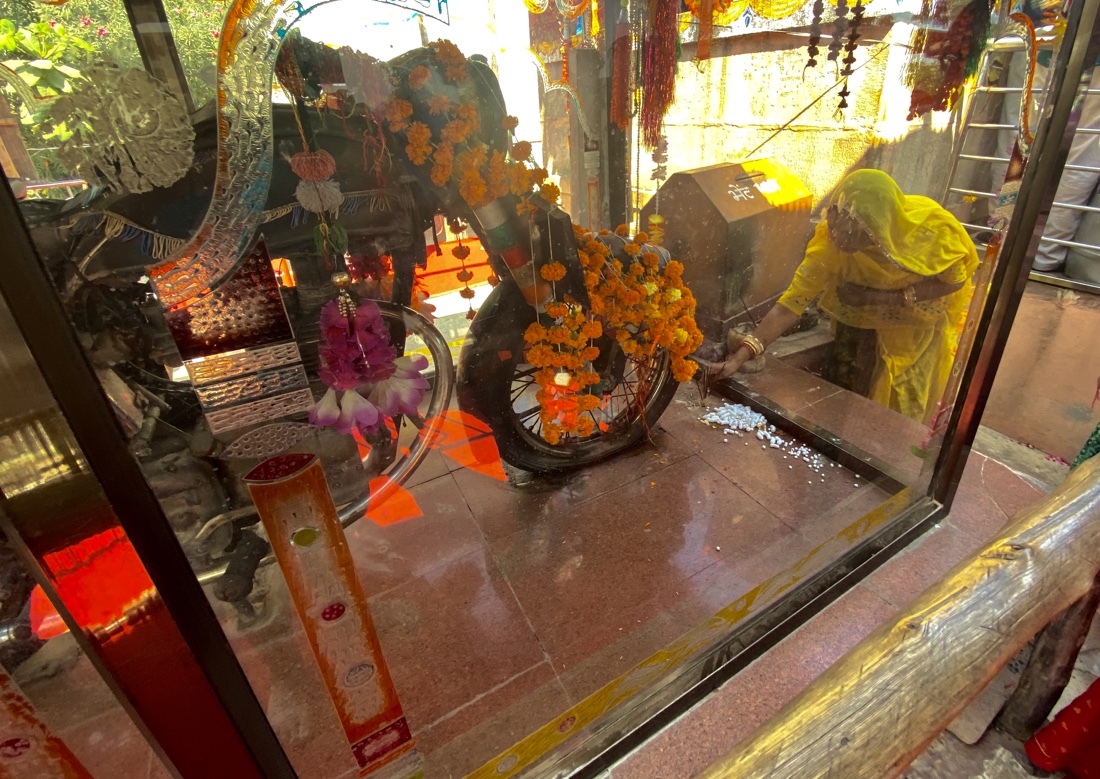 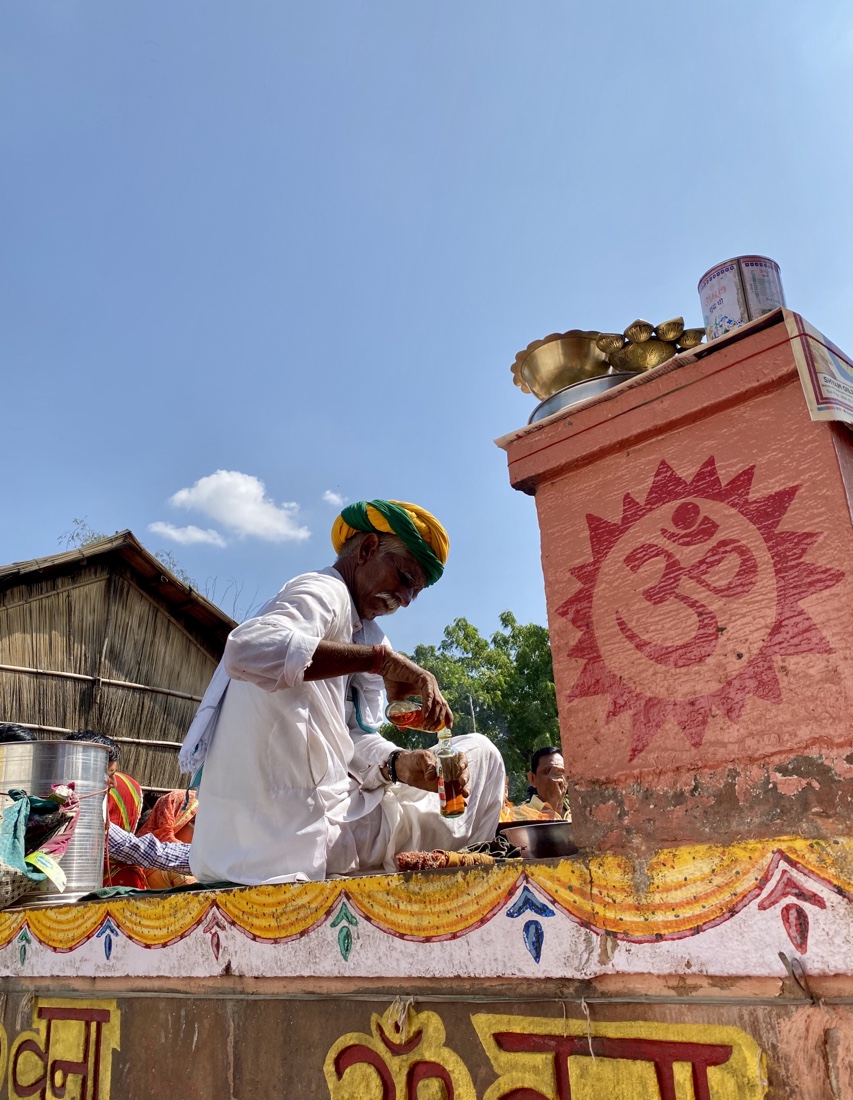 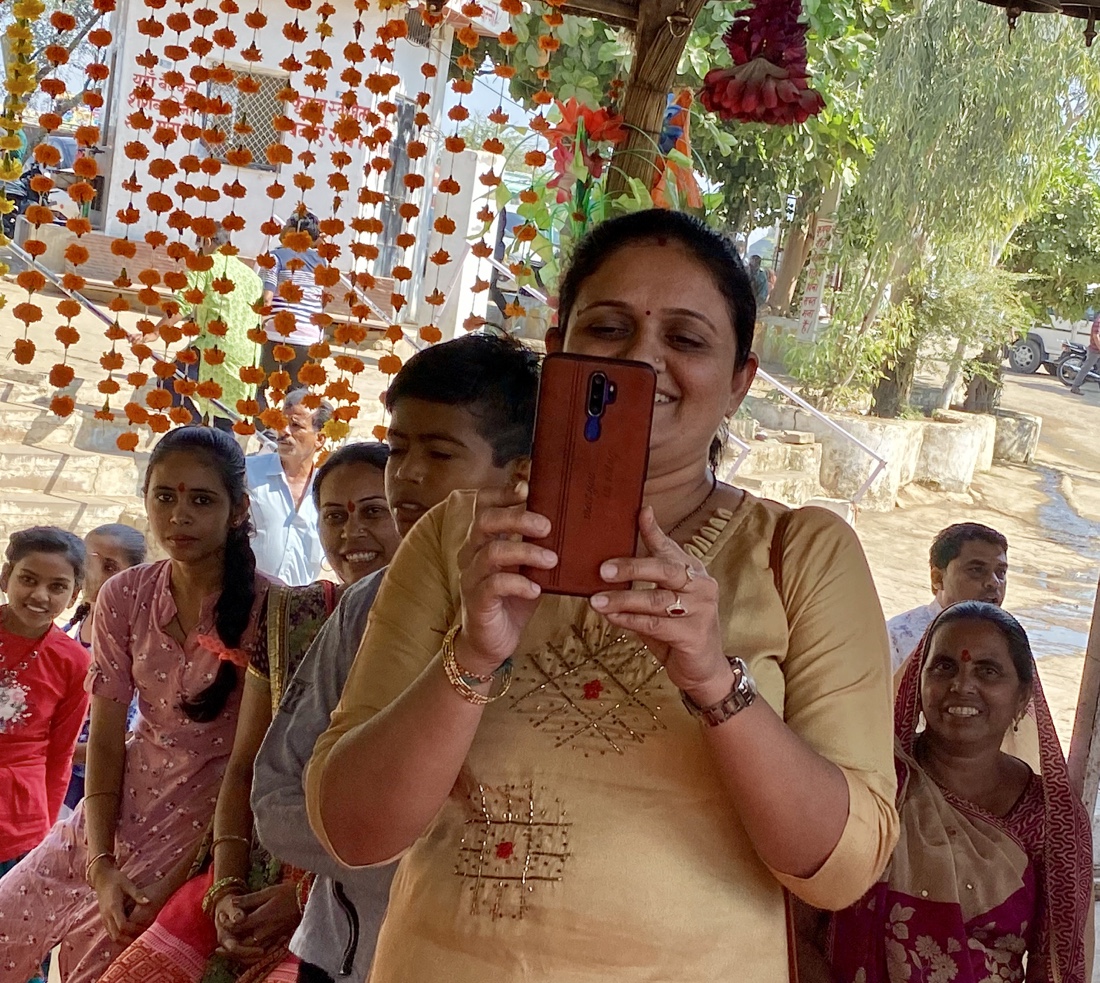 So, if you’ve been to India, seen the Taj, but missed Bullet Baba, that’s a damn shame. We saw it only because our driver from Jawai to the Jodhpur airport, Manu, knew about it and asked whether we’d like to stop. Of course, we would. One of the things I love about India is that there are thousands of tales of Bullet Babas to be found, each of them ardently believed and deeply meaningful to the faithful. So, if you’ve been to India, seen the Taj, but missed Bullet Baba, that’s a damn shame. We saw it only because our driver from Jawai to the Jodhpur airport, Manu, knew about it and asked whether we’d like to stop. Of course, we would. One of the things I love about India is that there are thousands of tales of Bullet Babas to be found, each of them ardently believed and deeply meaningful to the faithful.
After a relaxed breakfast outside at our camp, we ride some 31/2 hours to Jodhpur, are met at the airport and spend a very long time standing in line to clear security for our flight to Delhi. Actually, I spend a very long time in line. Carol whizzes right through, because, in payback for the lines at restrooms, they’ve devised a system with a separate line for women. Carol cleared security a good 35 minutes before I did.
We’re met at the Delhi airport and driven an hour to our hotel, one of my all time favorites, The Imperial, arriving around 6PM. Air quality is very poor. Delhi is reputed to have the worst pollution of any major city in the world. Our guide says that it’s because of Diwali, all the firecrackers, but that sounds fishy to us. The Imperial is a decadent colonial-era hotel that has been upgrade with modern amenities. Just my type a place.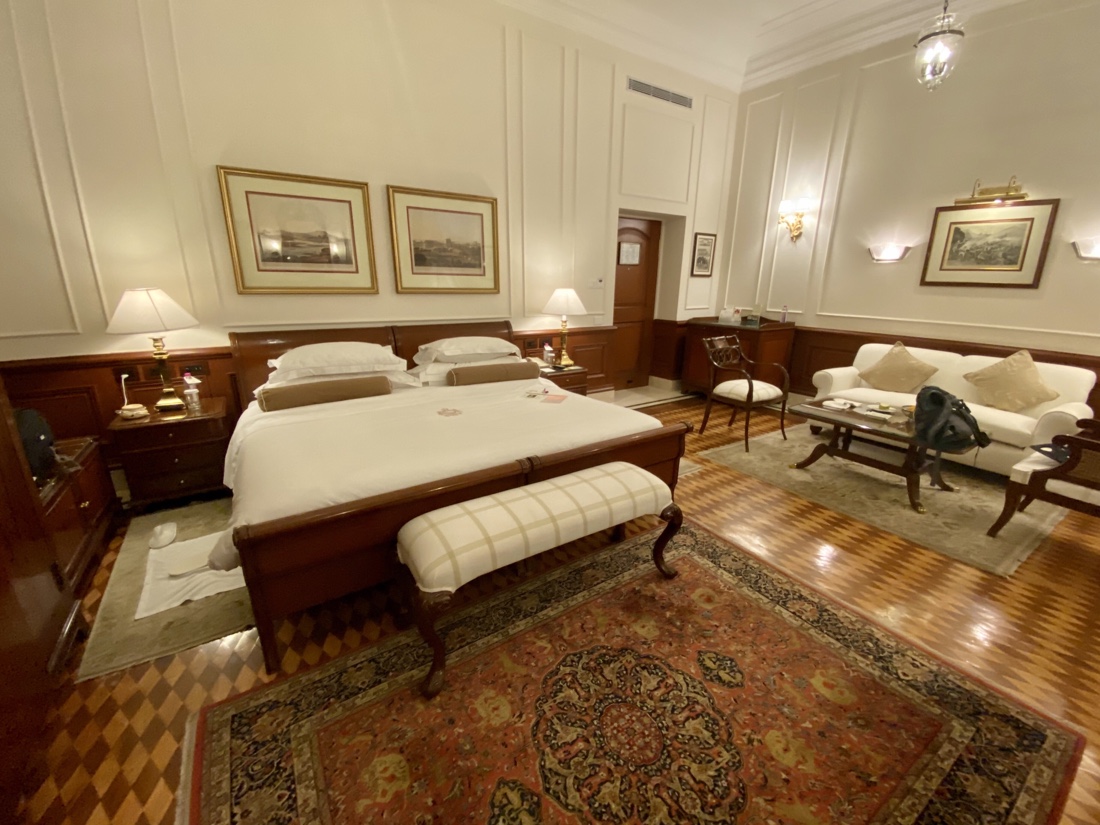
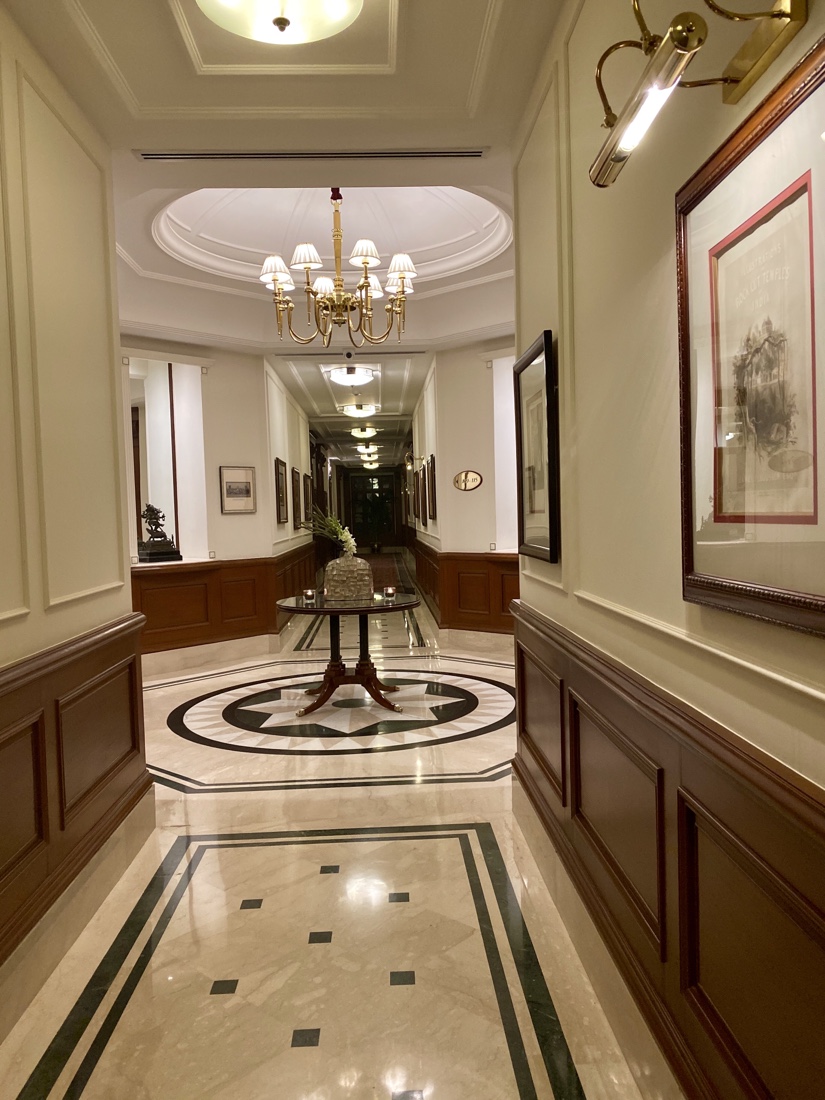 We go down to one of the four restaurants for dinner, then relax and retire. We go down to one of the four restaurants for dinner, then relax and retire.
October 30
Set in a dramatic location of ancient craggy outcrops and fields of mustard and wheat bordered by the Lake, Jawai is the perfect area to explore the Indian countryside. The area is the home of the Rebari tribes, traditionally herders. The men are known for wearing white offset by bright red turbans and the women for their bright clothes and bangles.
We awaken early today to take a safari, searching for leopards amongst the towering boulders and cliffs. No leopards, but beautiful, rugged countryside, birds, peacocks. 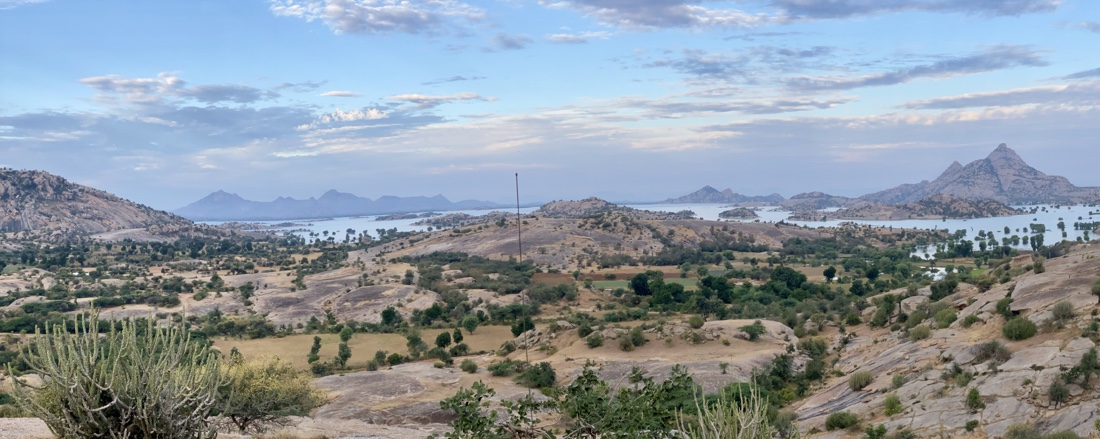 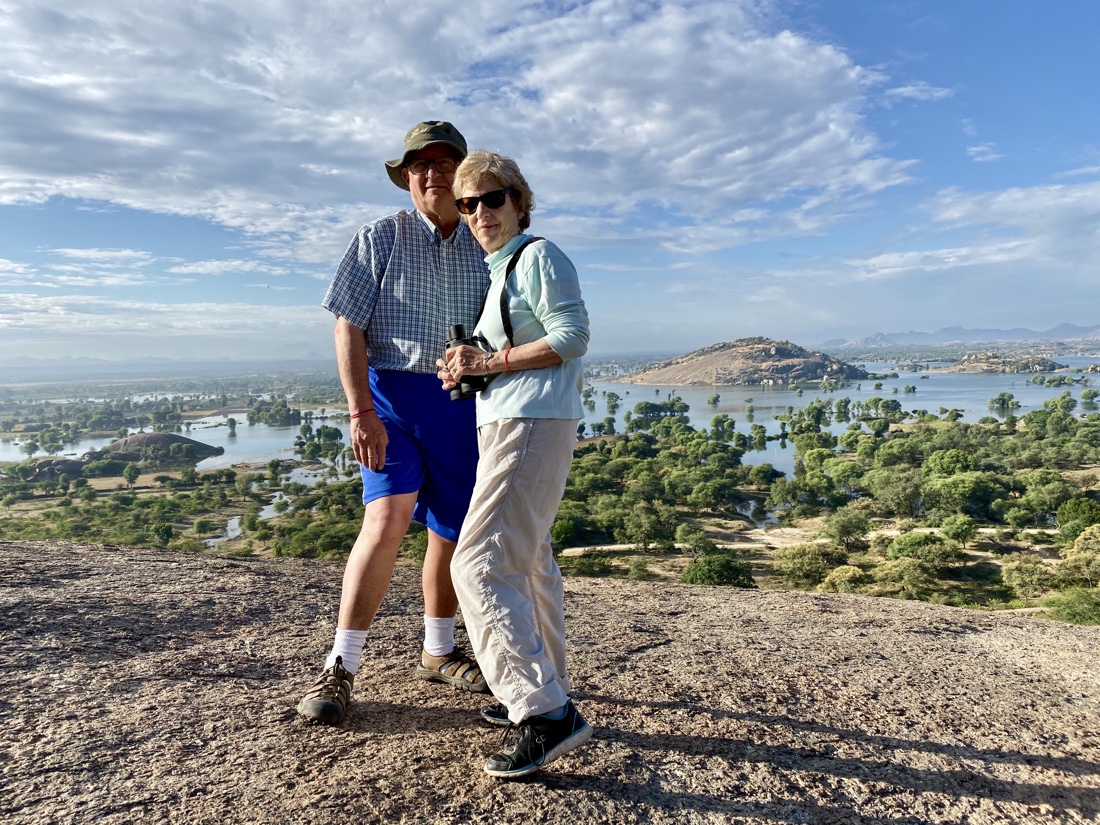 And interesting, very friendly people. And interesting, very friendly people. 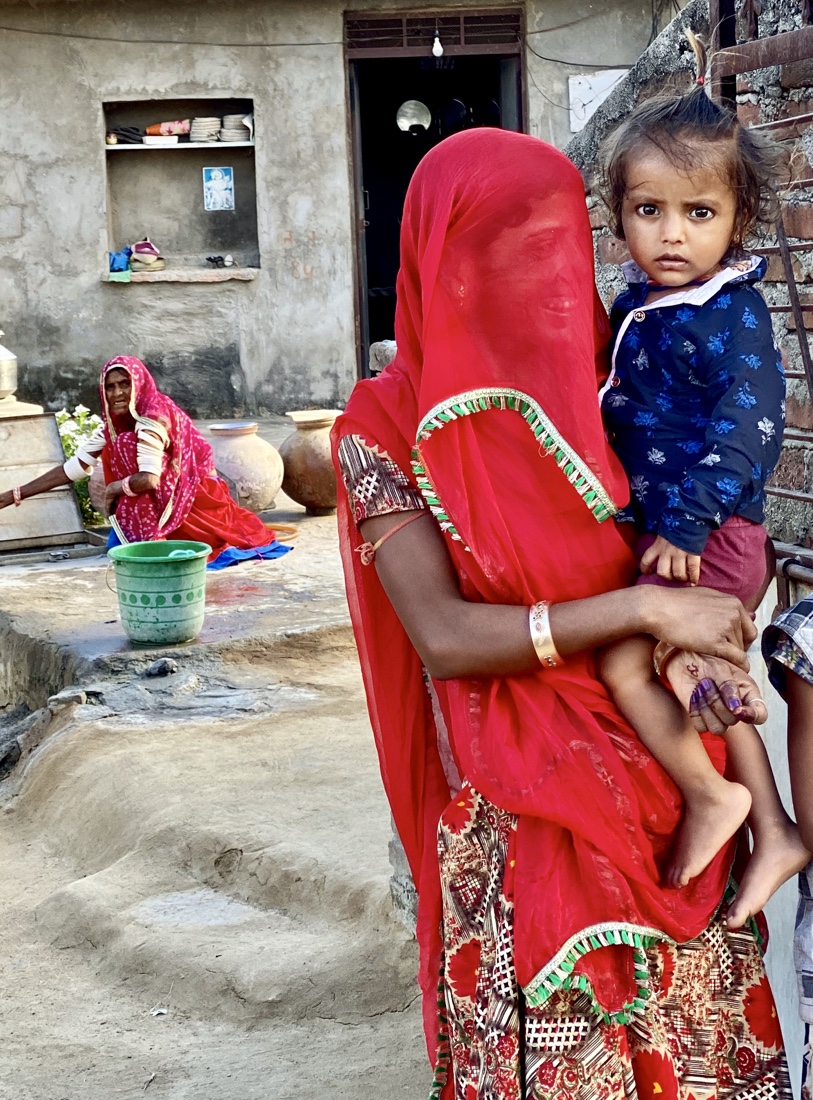 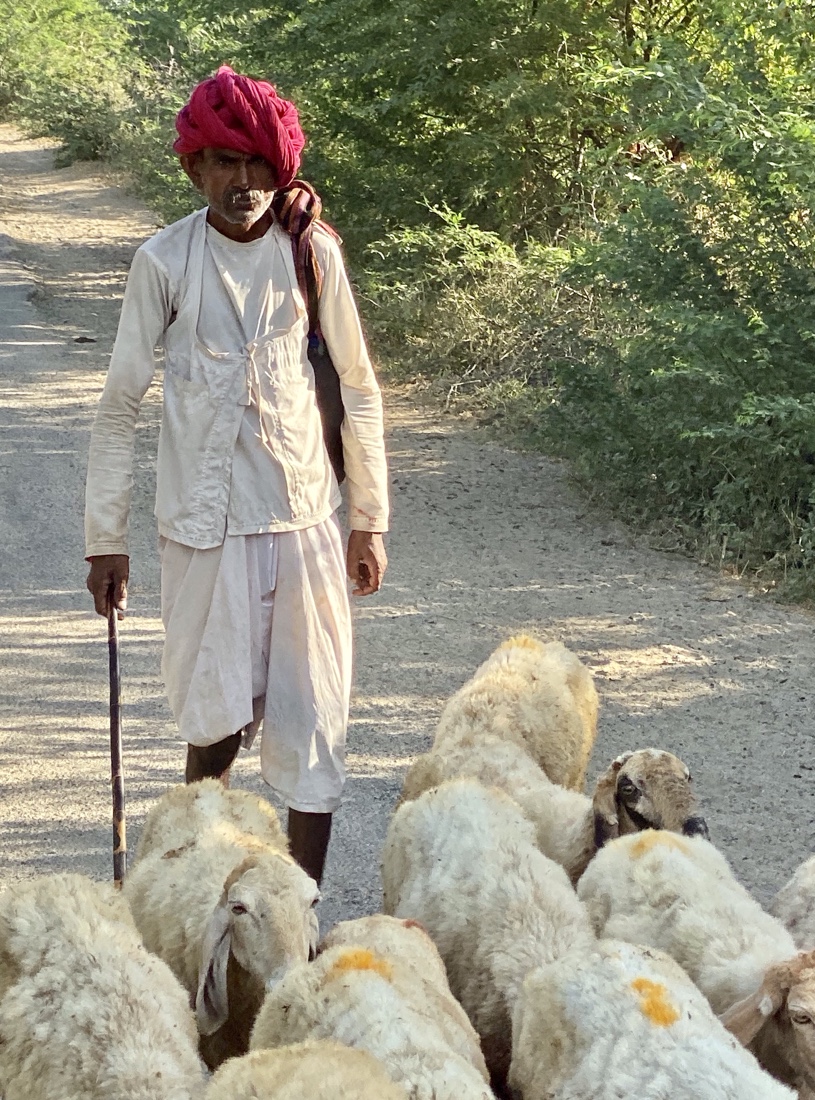 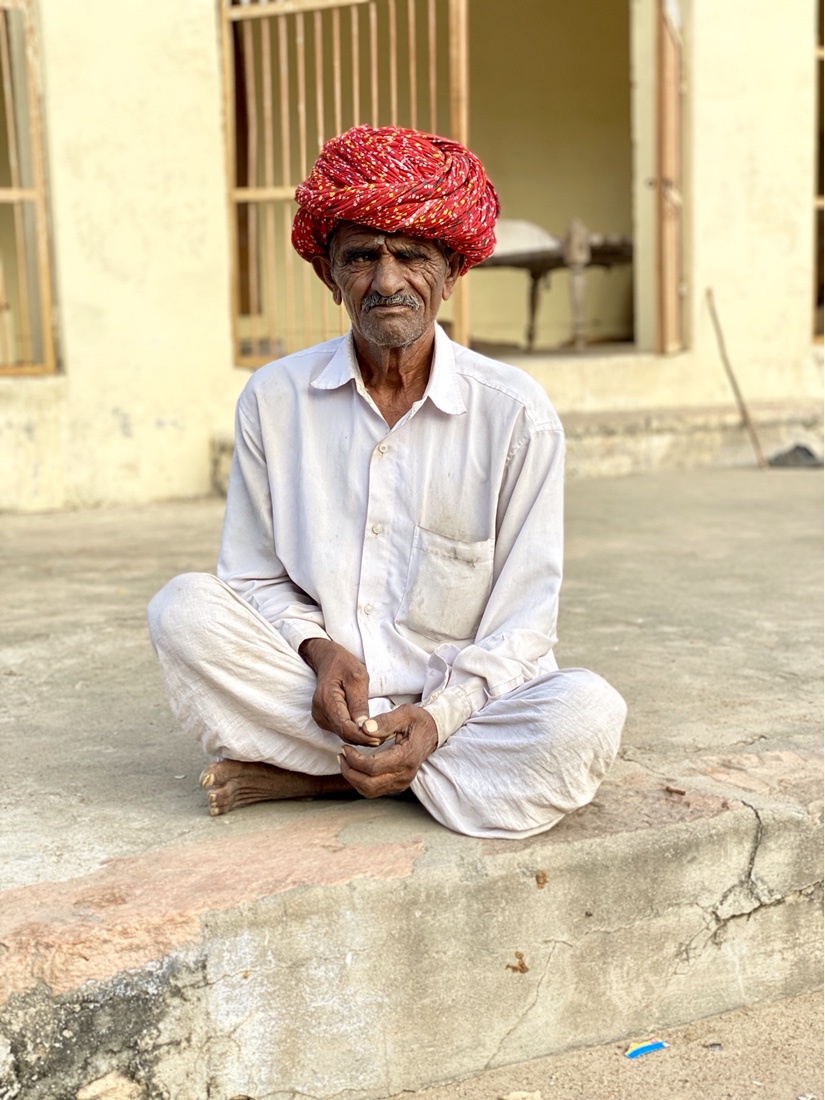 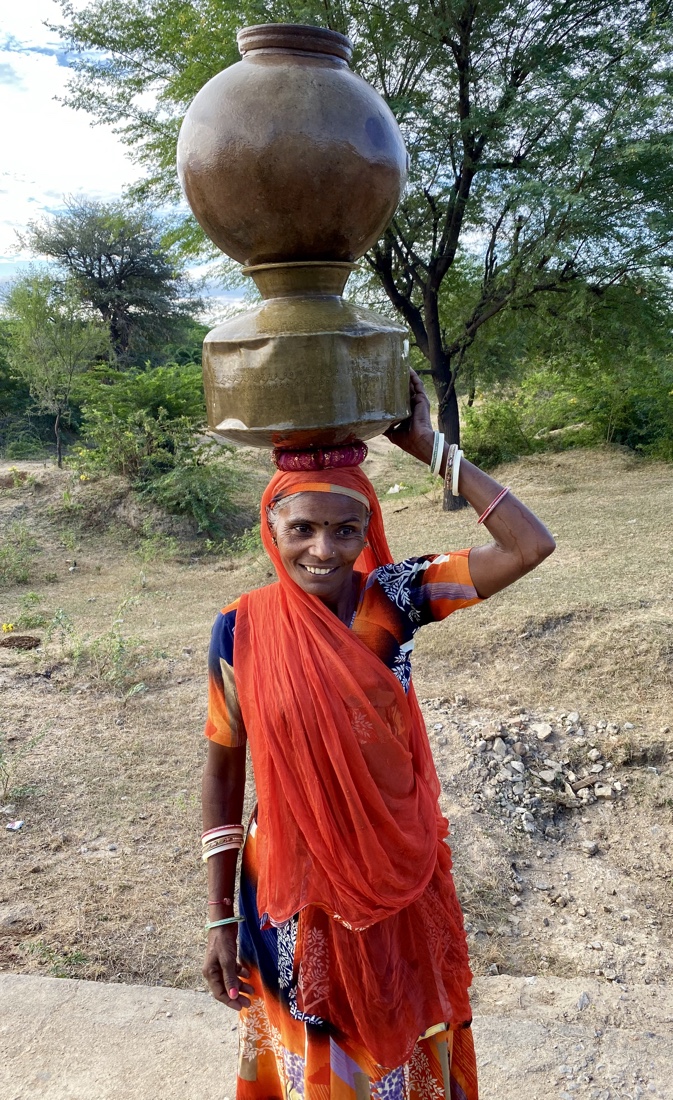 Such a pleasure to be riding around in the Jeep. Such a pleasure to be riding around in the Jeep.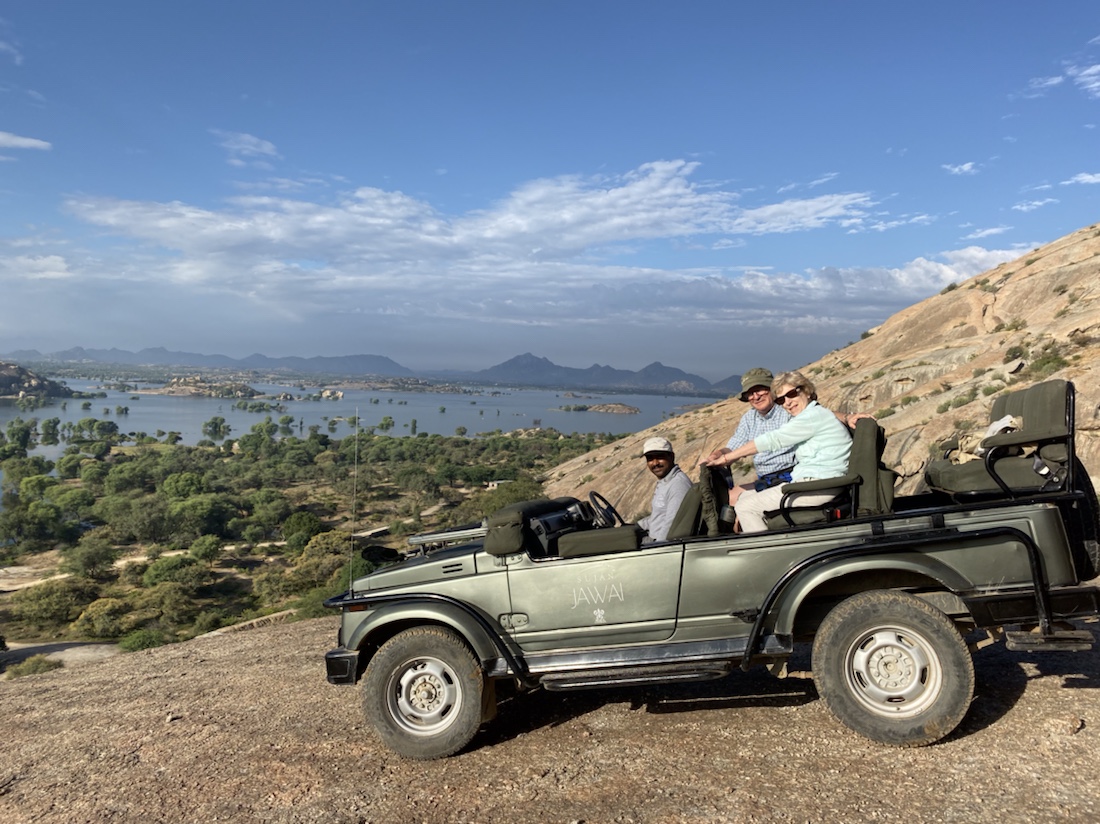 After I have breakfast (Carol is waiting for lunch to eat), we set off with our ranger, Ram, and an employee of our hotel who comes from the village we’ll be visiting, first to find and walk with a shepherd After I have breakfast (Carol is waiting for lunch to eat), we set off with our ranger, Ram, and an employee of our hotel who comes from the village we’ll be visiting, first to find and walk with a shepherd 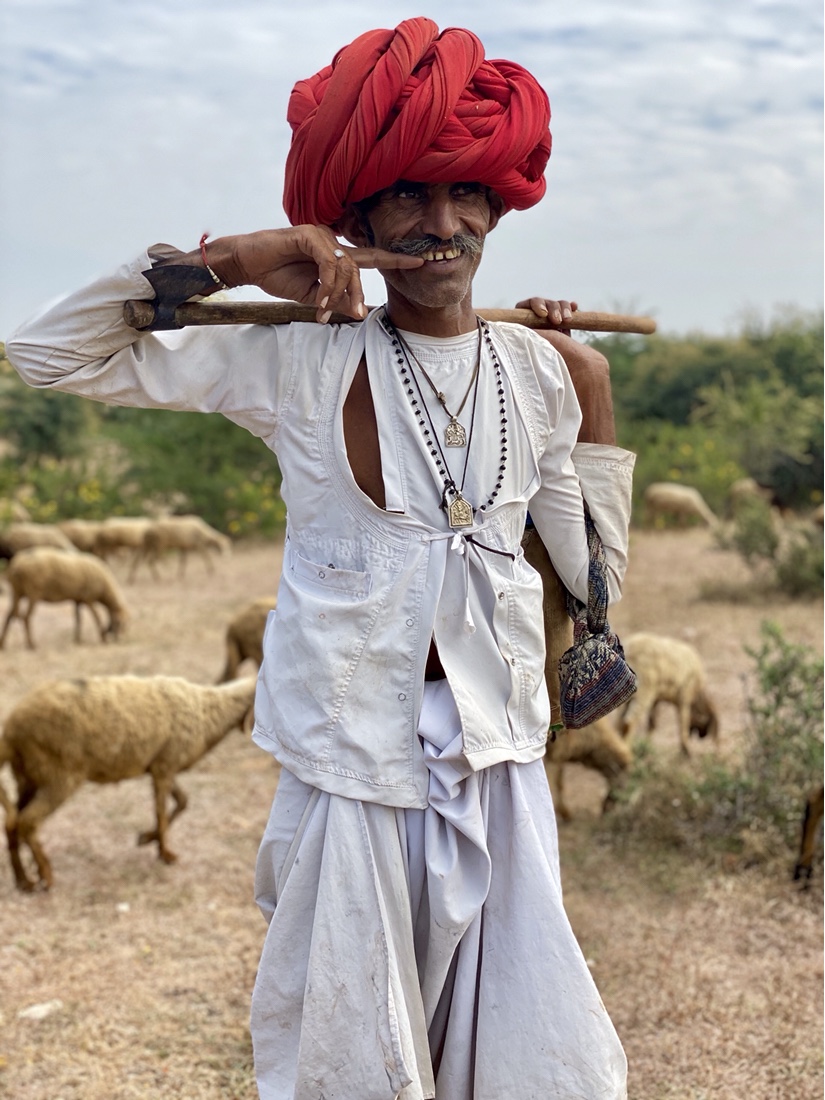 and, after we get the hang of shepherding, to give him a few pointers. and, after we get the hang of shepherding, to give him a few pointers. 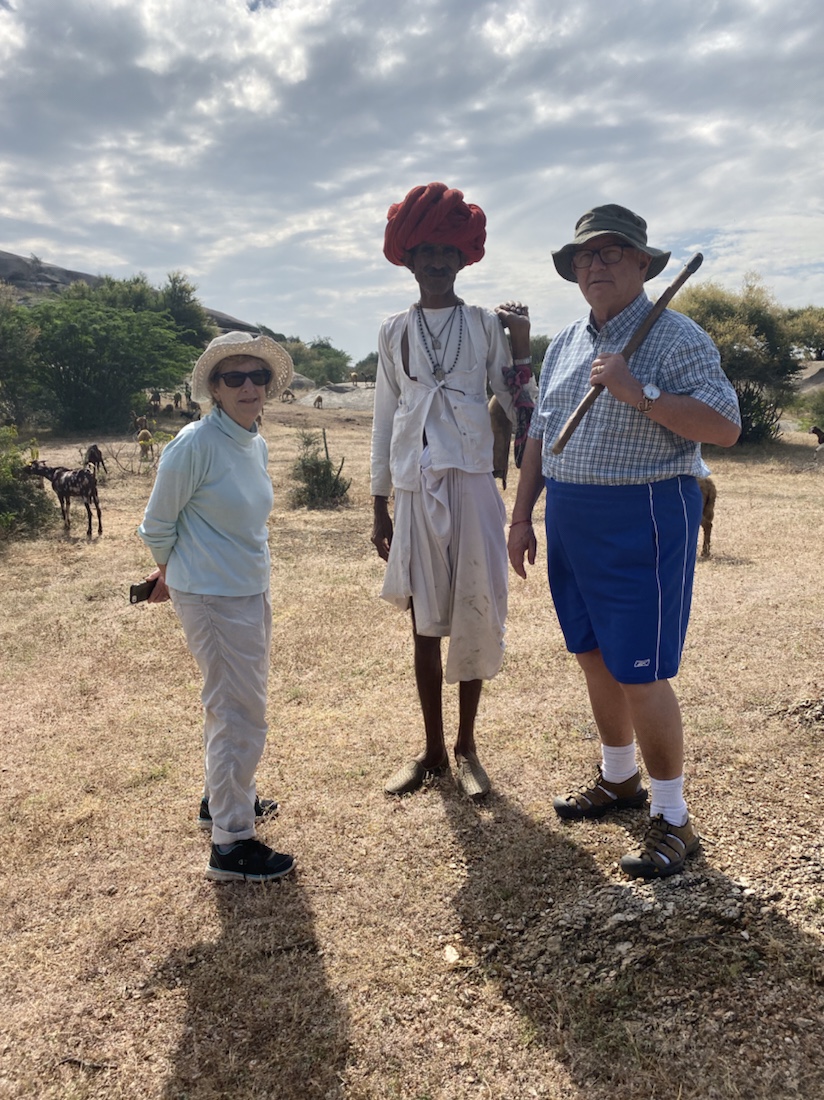 Some goats go to considerable length to reach their food. Some goats go to considerable length to reach their food.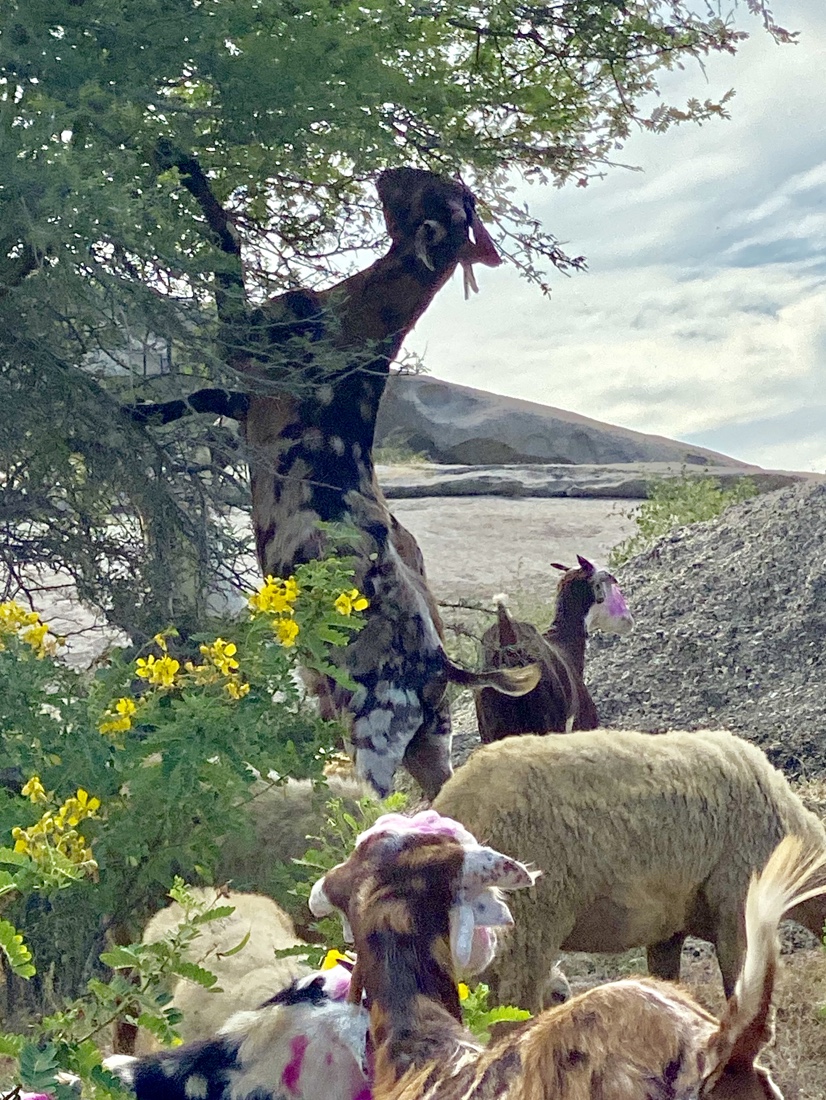
Afterwards, we go into a rather clean and prosperous-looking village, where we meet some villagers, including women with many bangles, 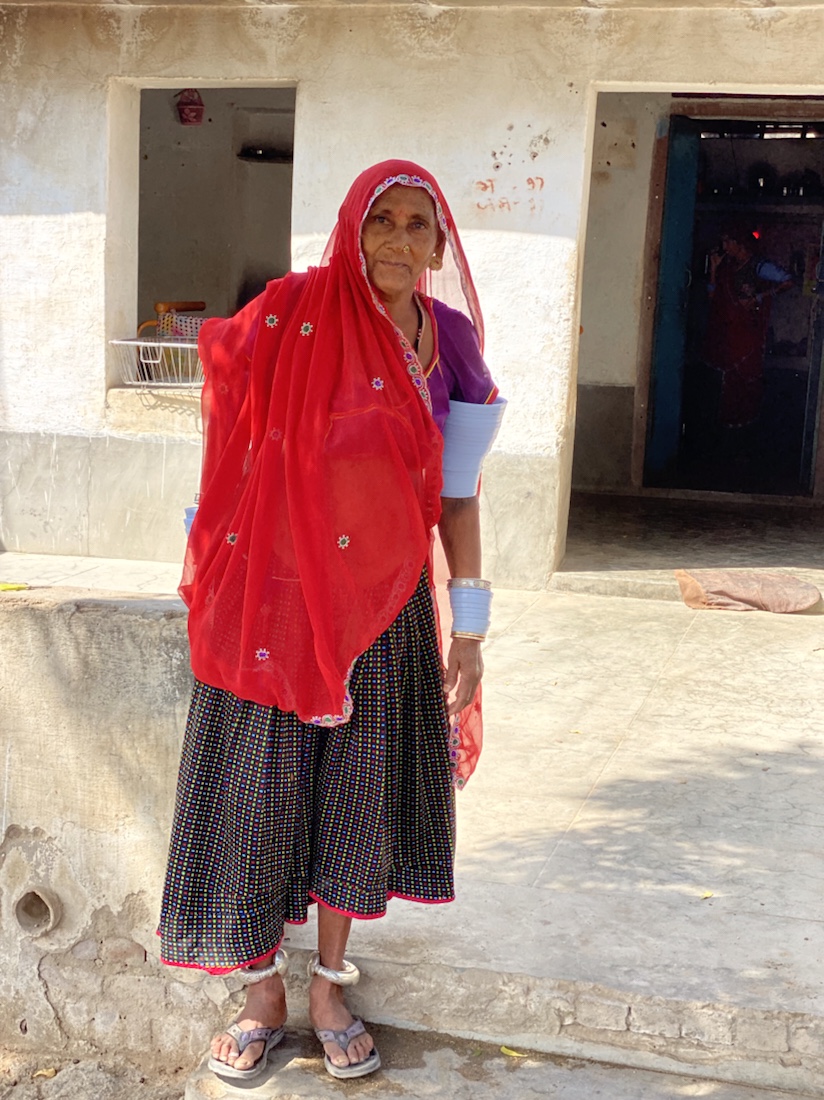 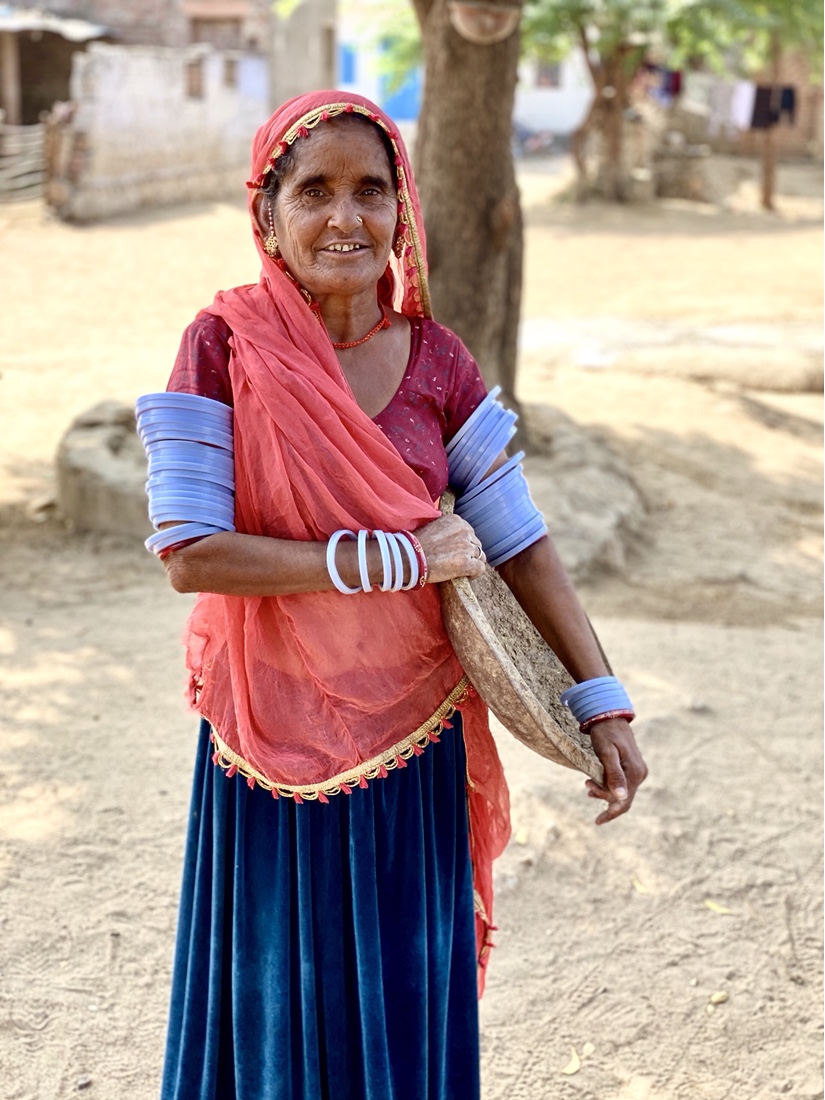 climb up to see a temple, busy with Diwali visitors climb up to see a temple, busy with Diwali visitors 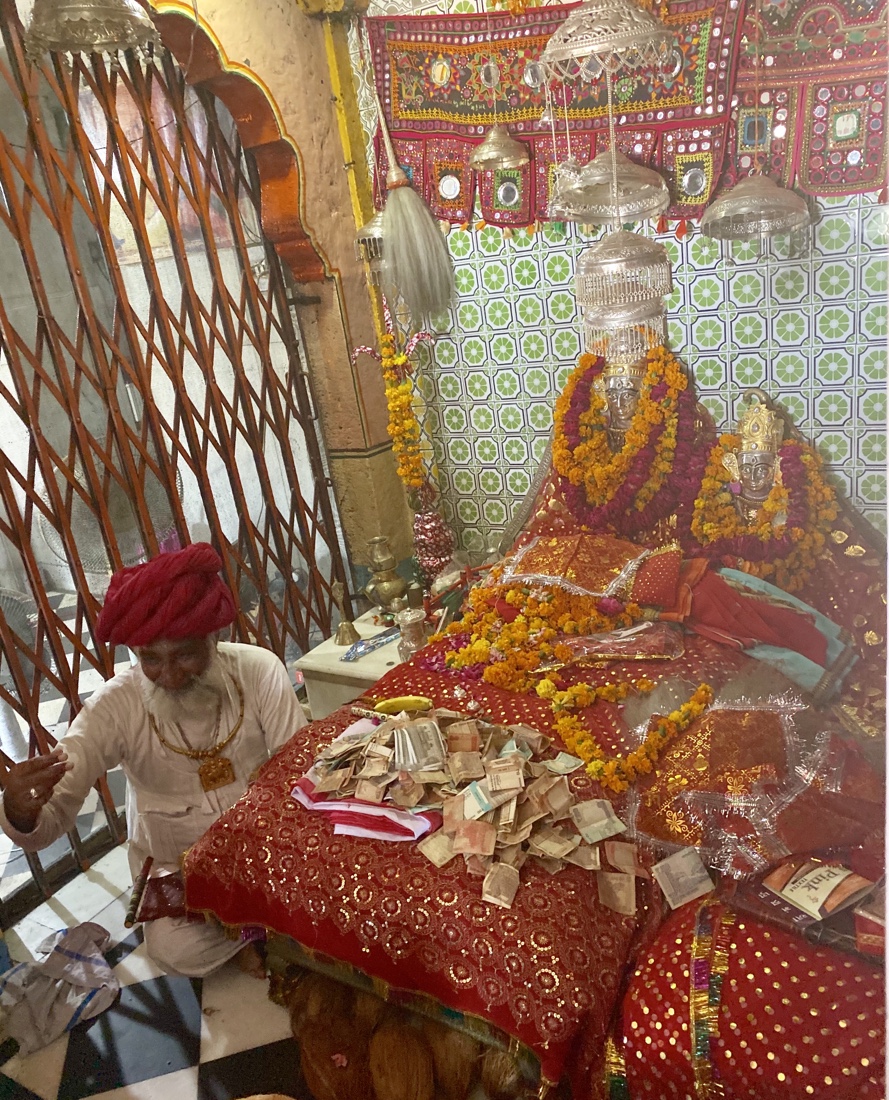 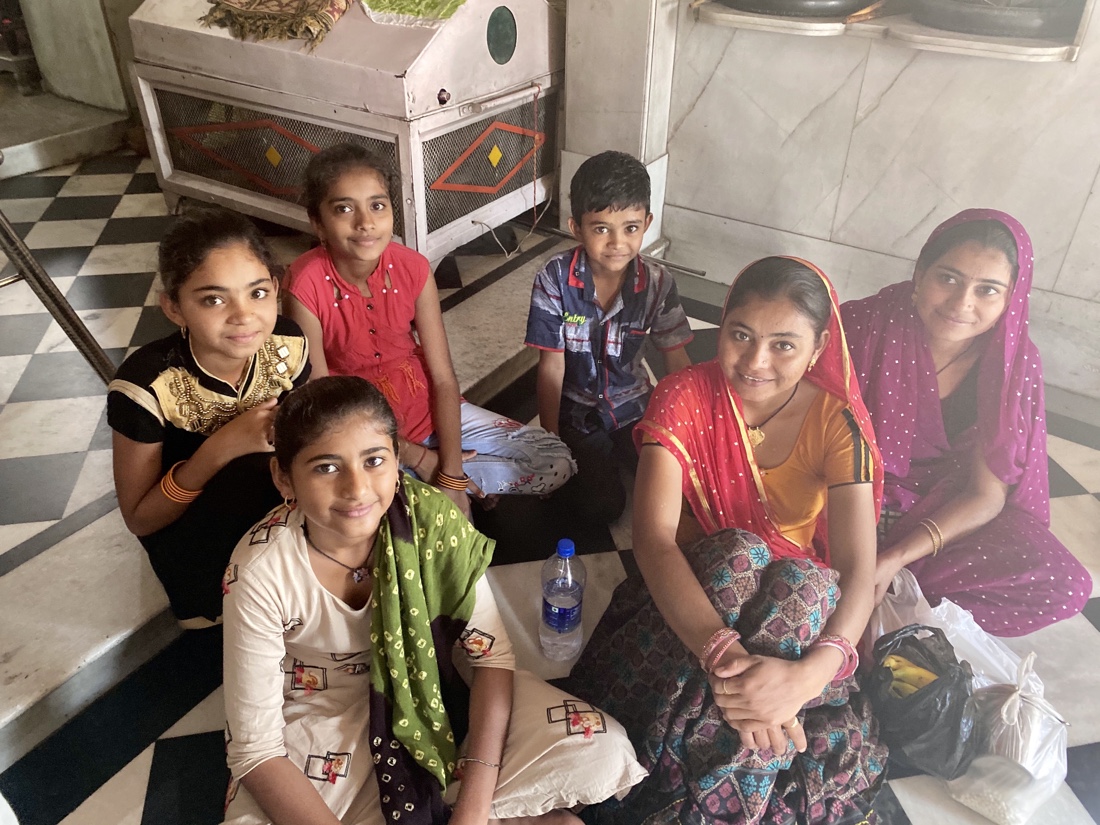 and happen upon men playing a kind of dice game. and happen upon men playing a kind of dice game. 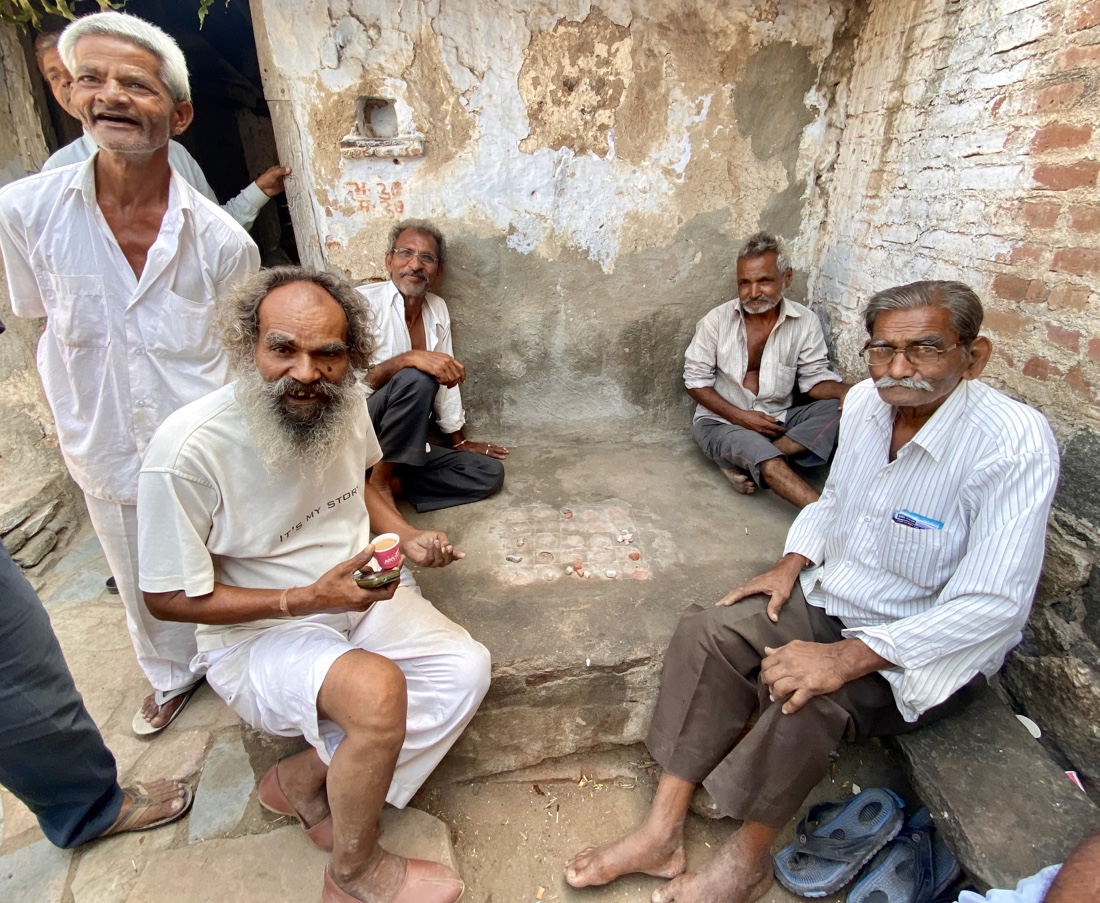 We are not the only ones interested in taking photos of interesting-looking people; we are often the subject matter. We are not the only ones interested in taking photos of interesting-looking people; we are often the subject matter.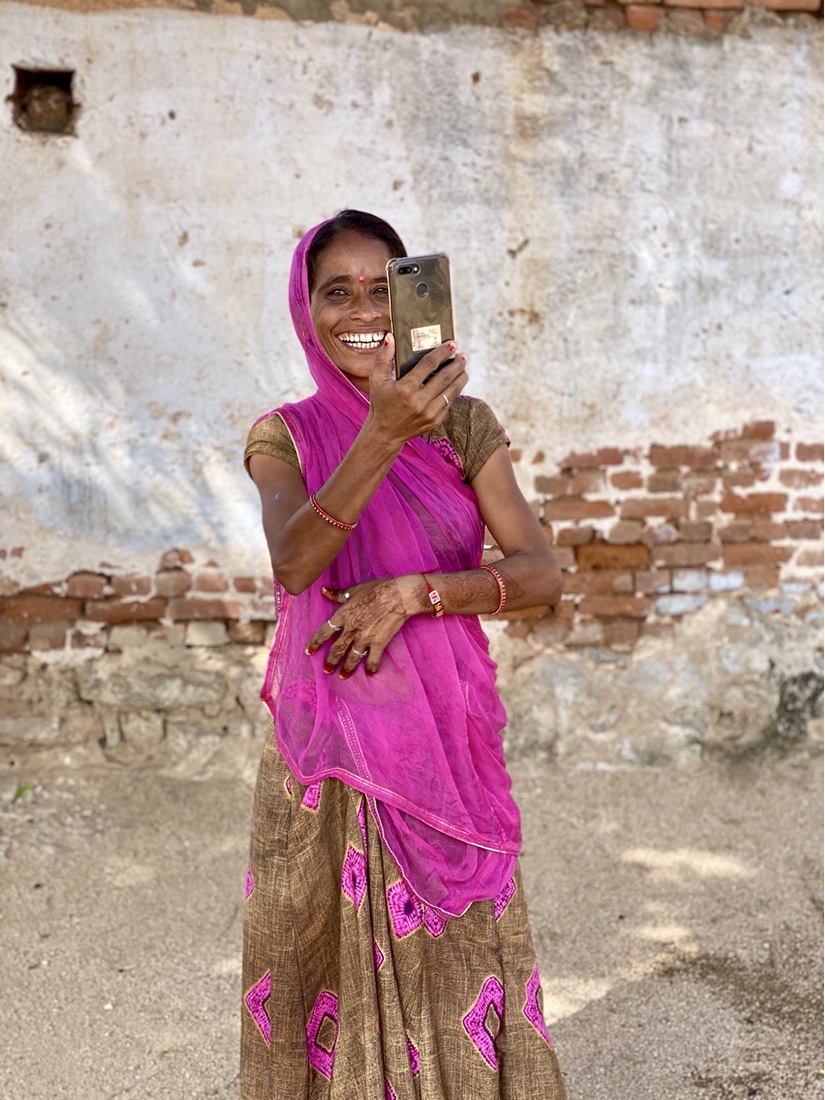 It’s gotten quite hot, so we are happy to return to the camp, where Carol has lunch and I go for a swim, before departing on our 4:30 game drive, once again searching for leopards among the craggy rocks. As we start out, it begins to drizzle, and Ram considers turning back to camp, but we continue. It’s gotten quite hot, so we are happy to return to the camp, where Carol has lunch and I go for a swim, before departing on our 4:30 game drive, once again searching for leopards among the craggy rocks. As we start out, it begins to drizzle, and Ram considers turning back to camp, but we continue.
Not long after, Ram gets word of a leopard sighting, tells us to hang on, and tear asses over very bumpy roads to the sight, which is full of bushes, trees and large, craggy rocks. Many other jeeps have gathered, in fact eighteen at one point. Ram is able to locate the leopard and cub, well hidden and a long way off. They move from time to time, making it even more difficult to find them. Carol spots them, better than I can, but we’re still barely able to see them. At least we’d be able to tell folks that we’d seen leopards, but not in a very satisfying way.
As the sun is setting, we take off and drive up a stony hill for a spectacular view of Lake Jawai at sunset.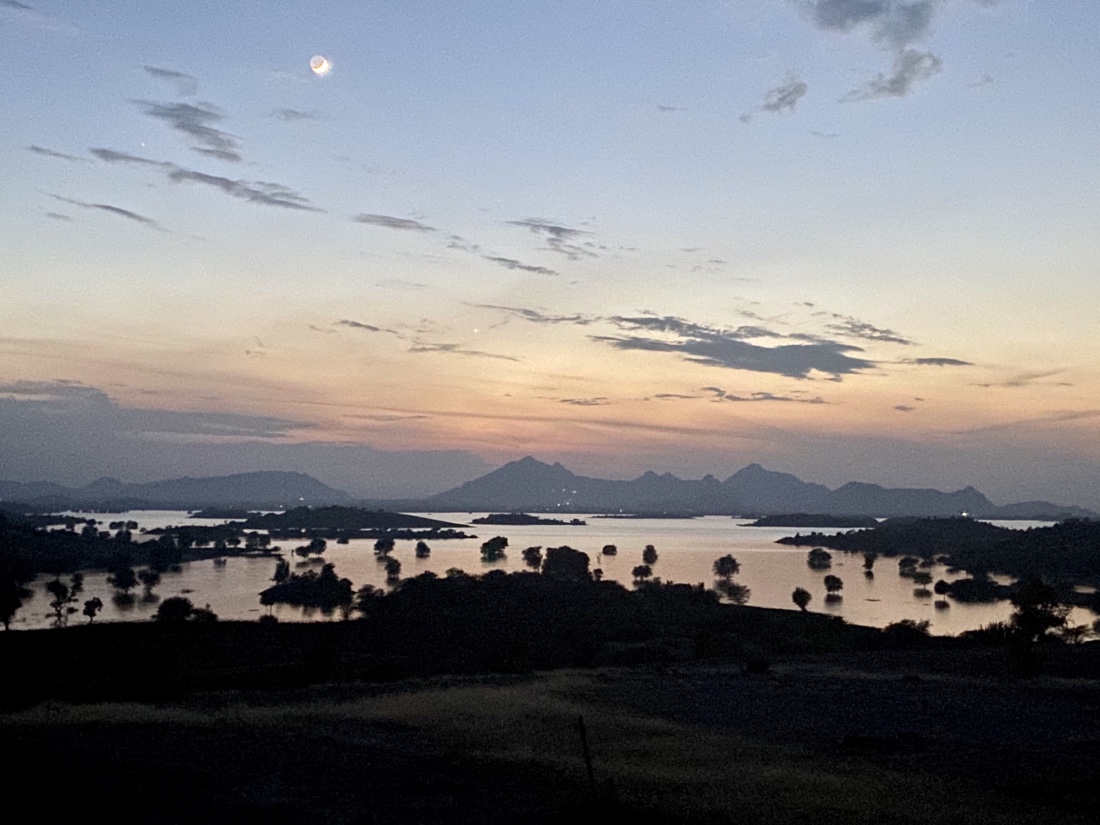
After sunset, Ram says he has an idea and wants to look for the leopards again. It’s pitch dark, but by shining a flashlight (not really cricket), he finds the mother leopard and cub, and we’re able to see them clearly, with no other jeeps around. This is fun and exciting. For the first time on this trip, not having my camera prevents a better photo (though even if I’d had my camera, it wouldn’t have been much). As it is, here’s proof, at least, that we saw a damn leopard.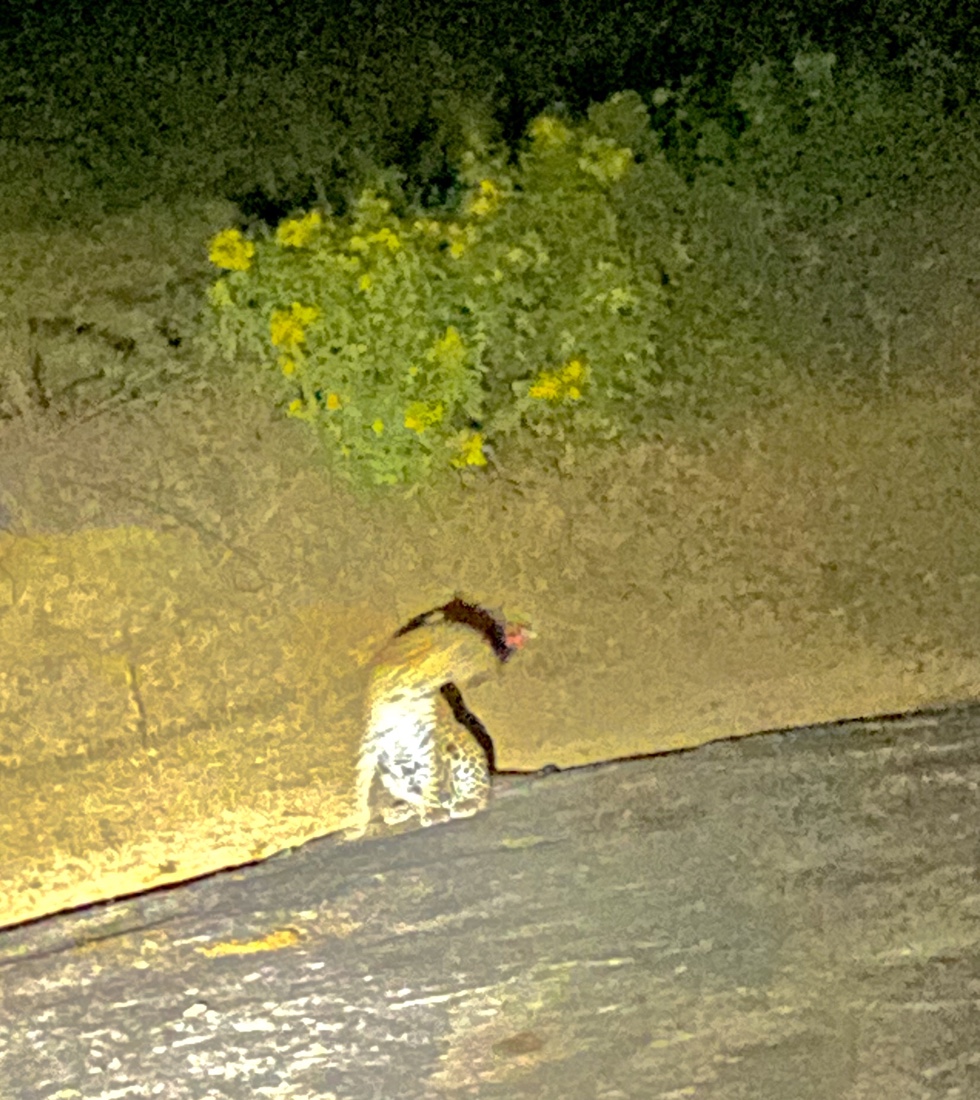
Not my best leopard photo. For comparison, here’s one taken about fifteen years ago that appears in Carol and my book, No Secret Where Elephants Walk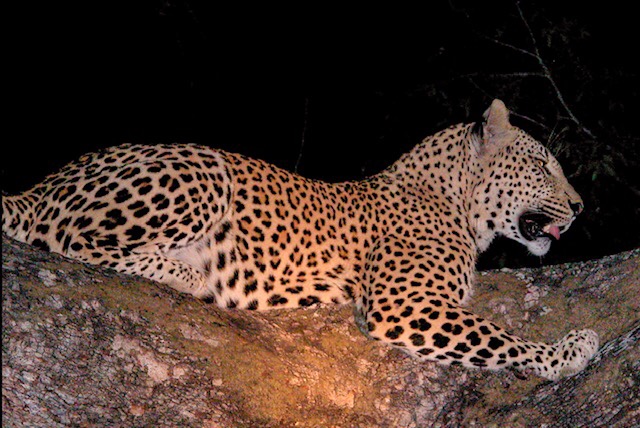 After tonight’s sighting, in a stunningly sensible decision, Carol and I decide not to arise at 5:30 tomorrow for a final game drive, but to sleep in, and pack and have breakfast at leisure. Pretty mature, huh? After tonight’s sighting, in a stunningly sensible decision, Carol and I decide not to arise at 5:30 tomorrow for a final game drive, but to sleep in, and pack and have breakfast at leisure. Pretty mature, huh?
October 29
A view from our breakfast table during our final meal at this fabulous palace.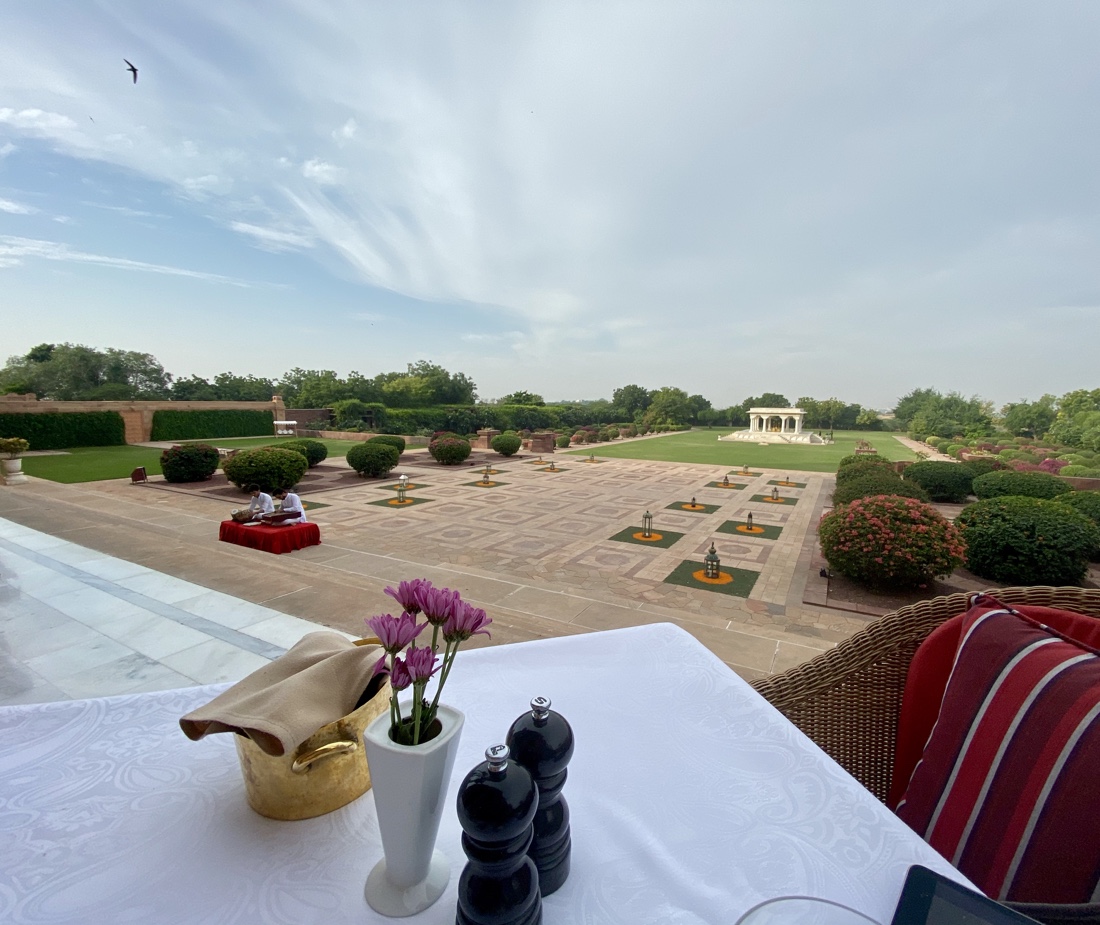 And a view of the front of our palace. And a view of the front of our palace.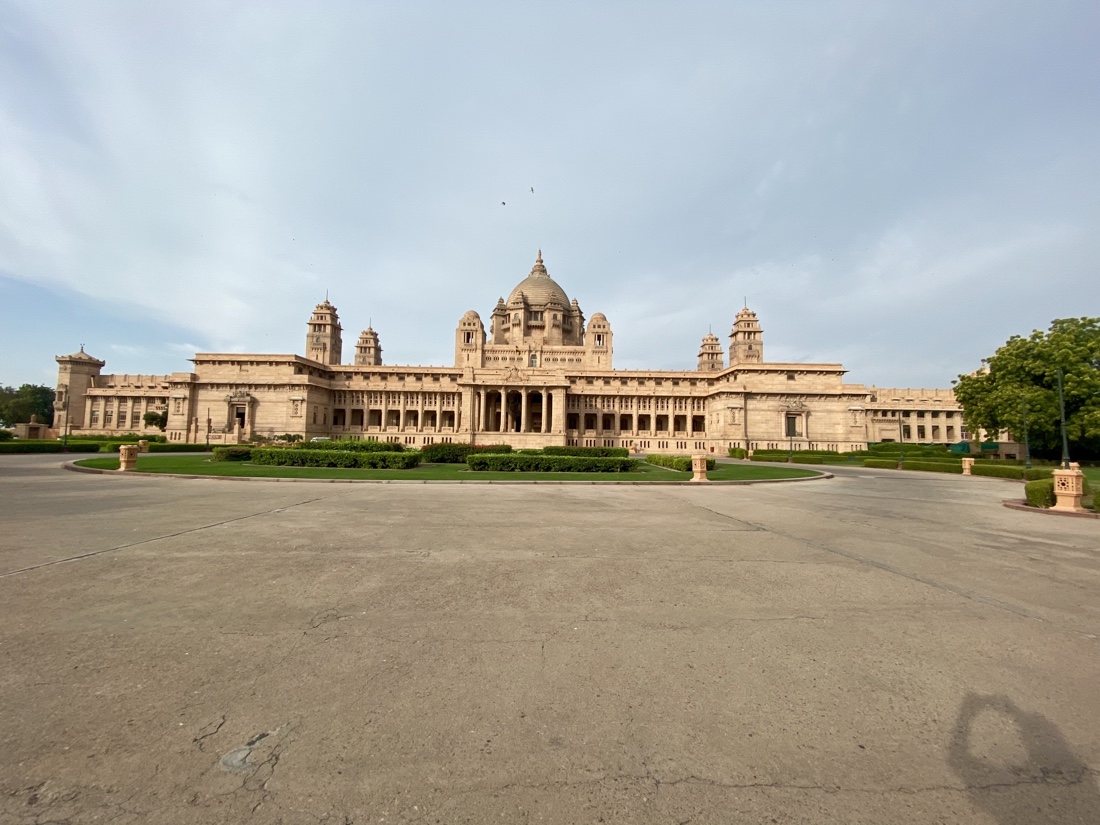 Of all the many forts in Rajasthan, very few compare to majesty of the Mehrangarh Fort. The fort is divided into three sections – the public areas, the Maharajas palaces, and the zenana, or queens’ palaces. The zenana is decorated with exquisite sandstone filigree work. Here are views of and from the fort. Of all the many forts in Rajasthan, very few compare to majesty of the Mehrangarh Fort. The fort is divided into three sections – the public areas, the Maharajas palaces, and the zenana, or queens’ palaces. The zenana is decorated with exquisite sandstone filigree work. Here are views of and from the fort.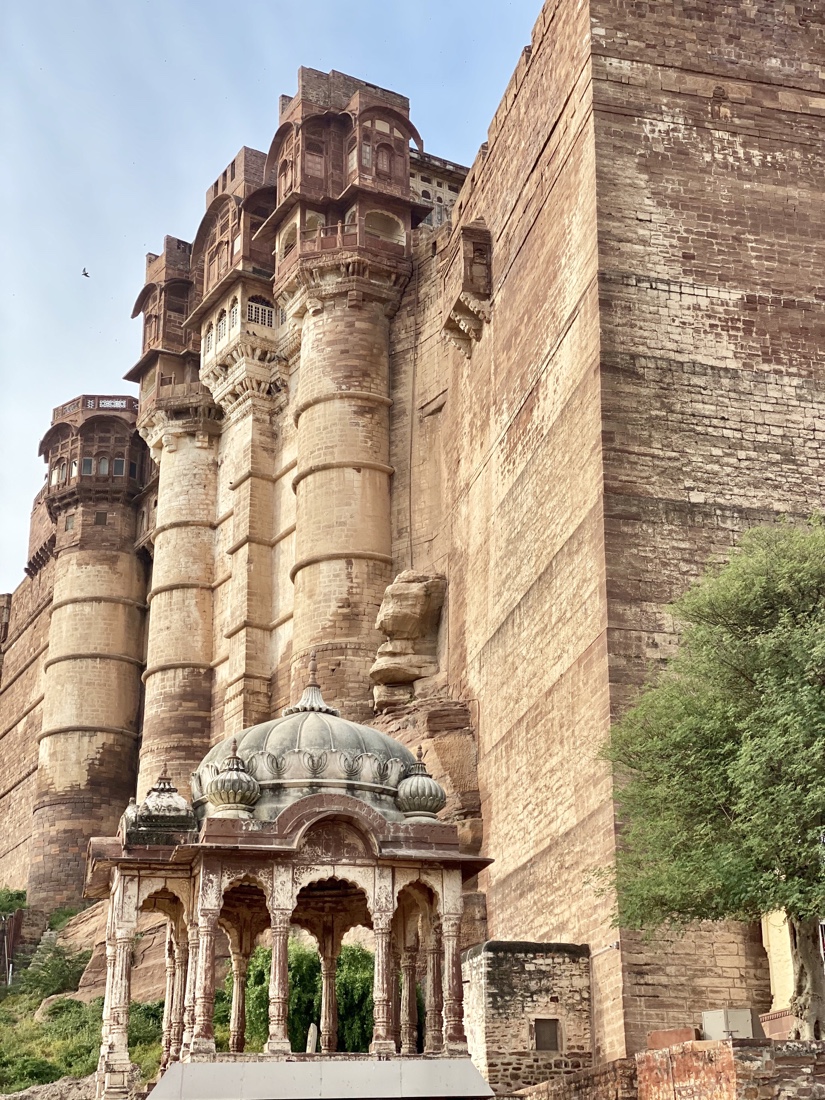 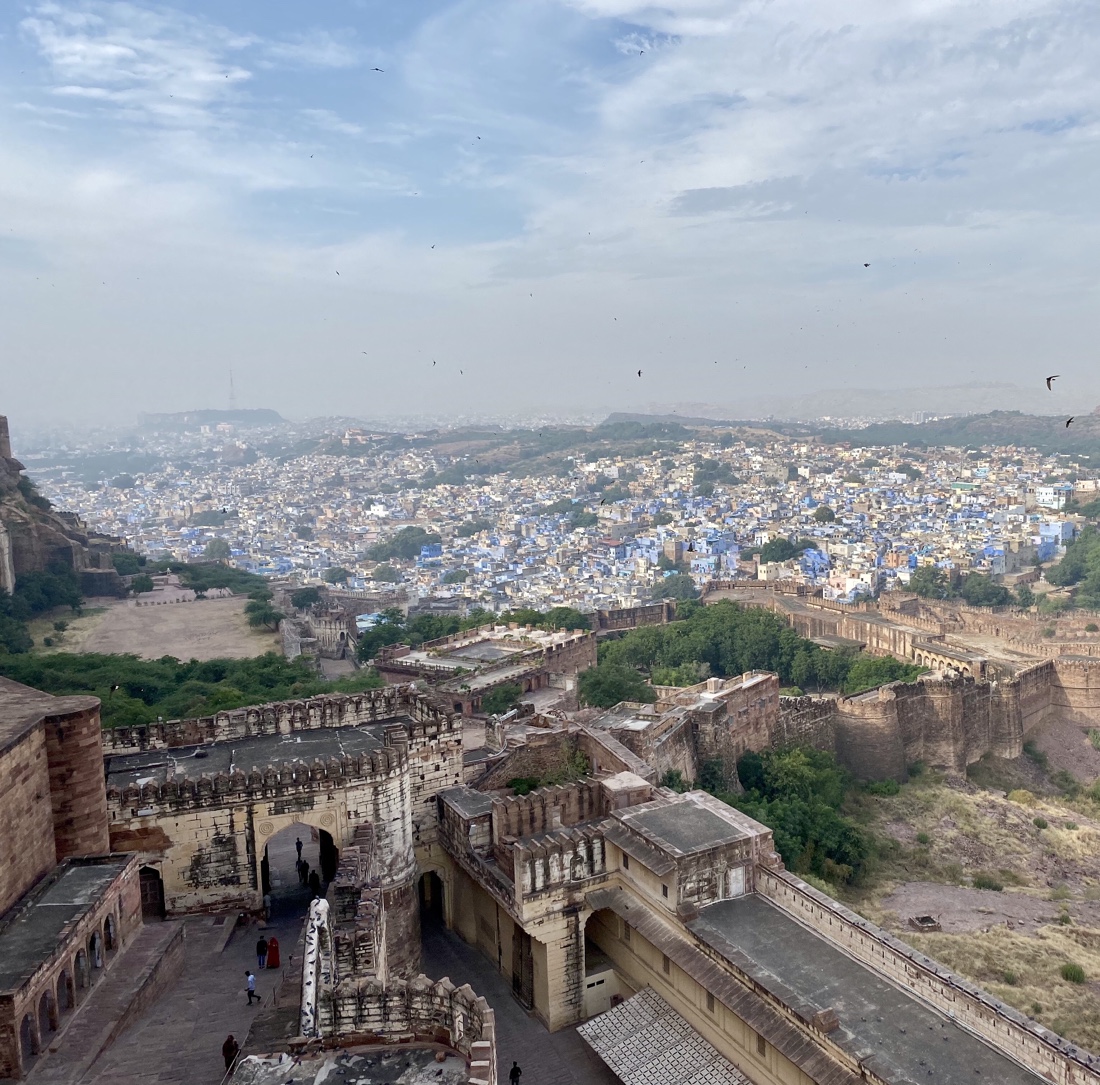 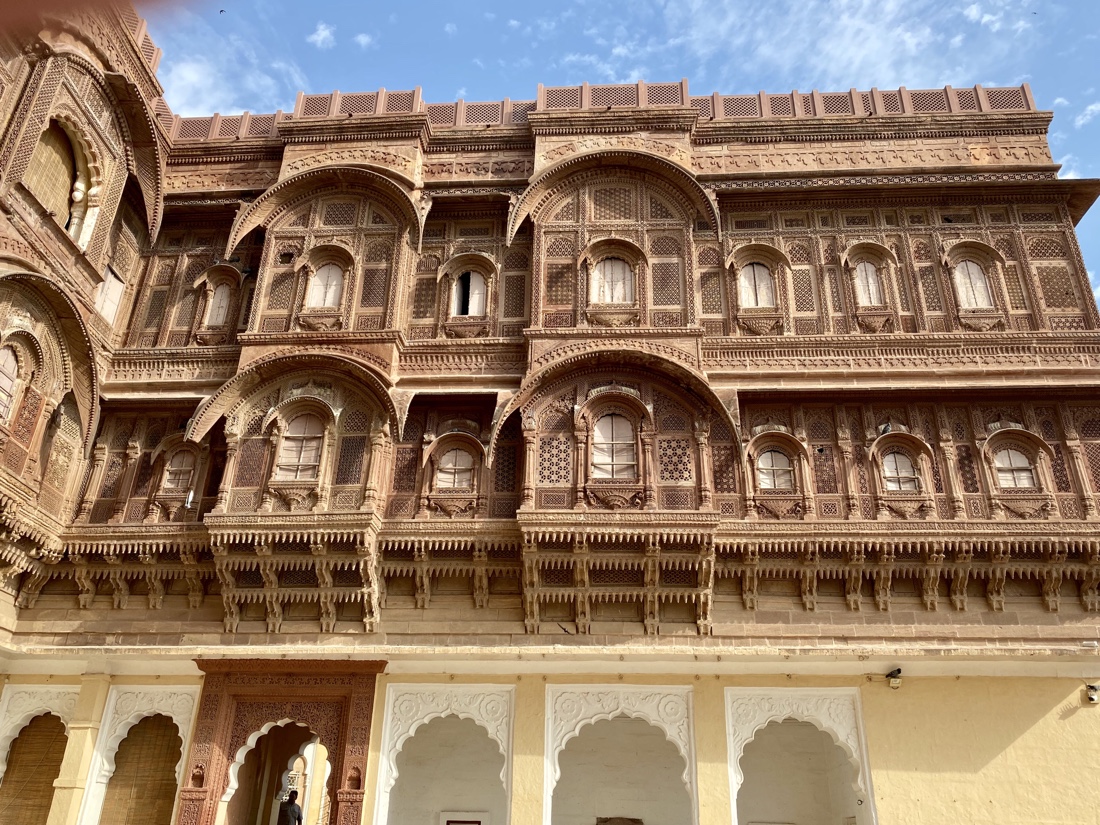
Within the fort is the museum, guarded by this colorful fellow,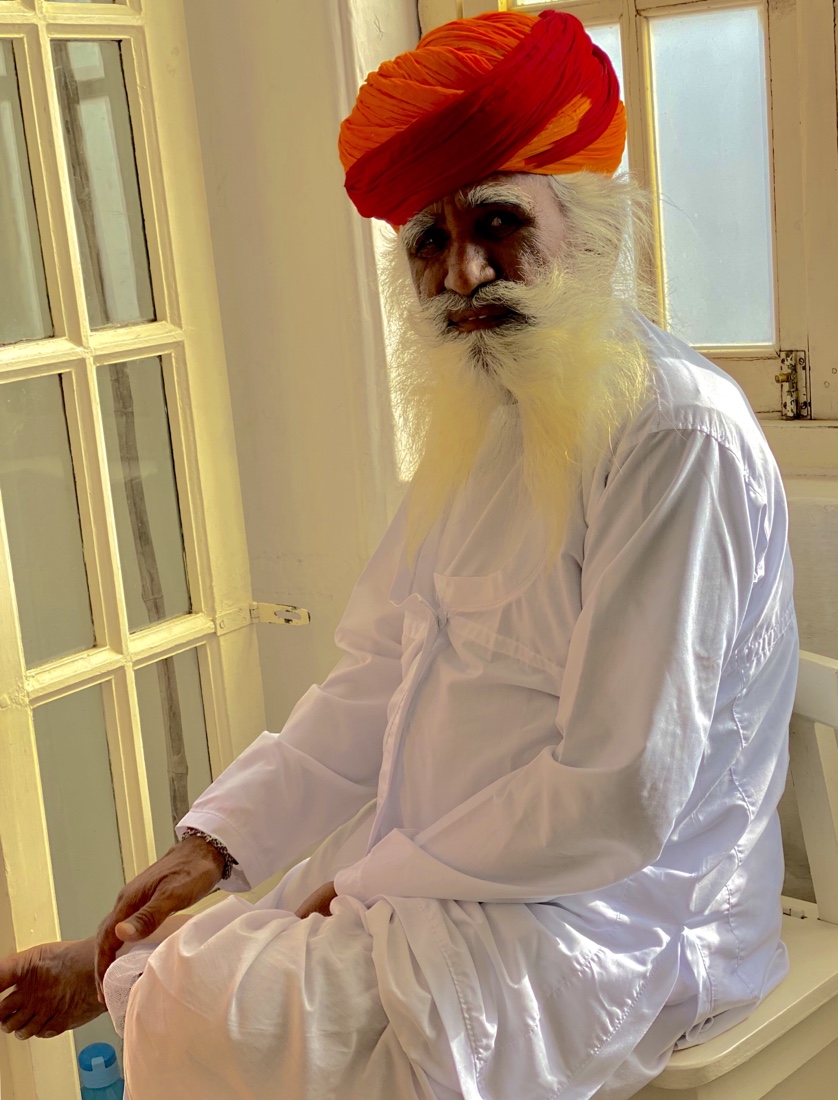 which among its varied exhibits has an excellent collection of royal palanquins and the howdah section which has perhaps the finest collection of old ornate elephant howdahs in the world. which among its varied exhibits has an excellent collection of royal palanquins and the howdah section which has perhaps the finest collection of old ornate elephant howdahs in the world. 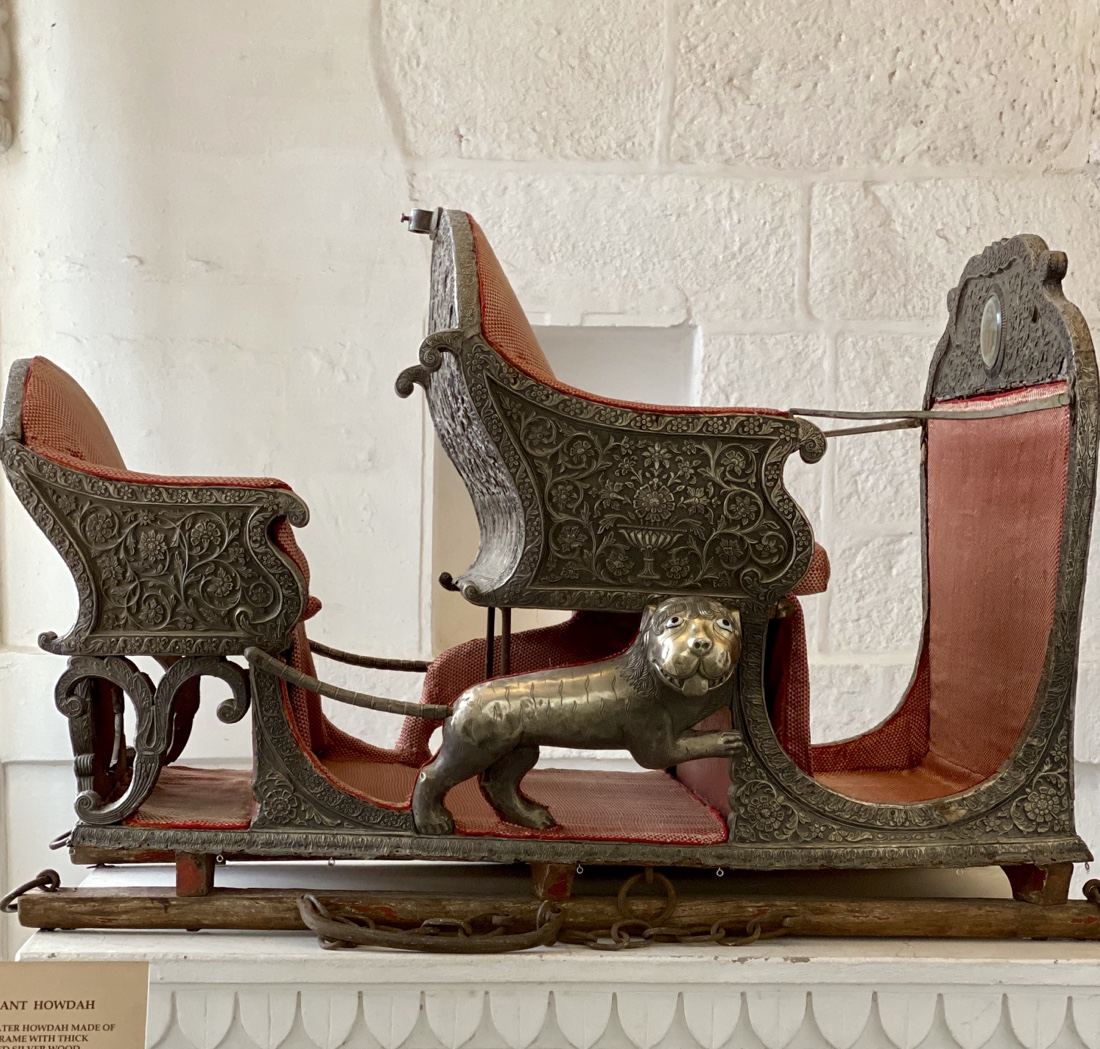 Carol and I are blown away by the incredible color, detail and artistry of the miniature paintings. Carol and I are blown away by the incredible color, detail and artistry of the miniature paintings.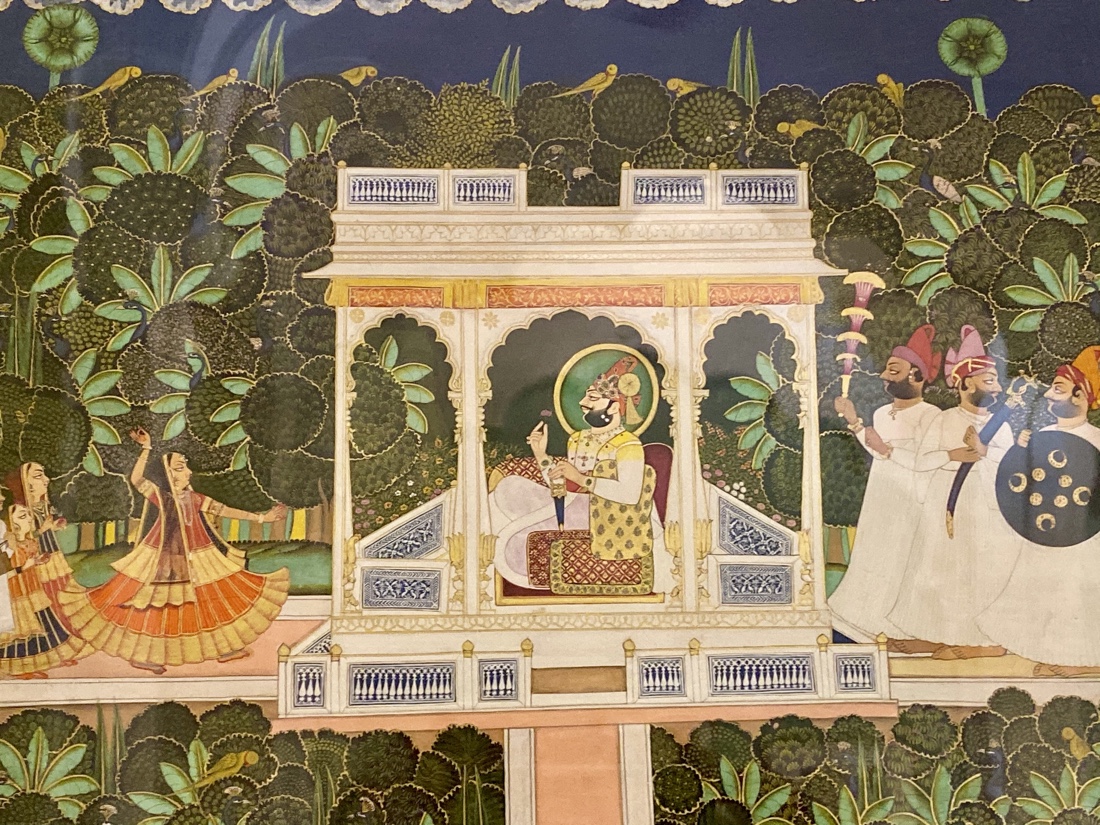 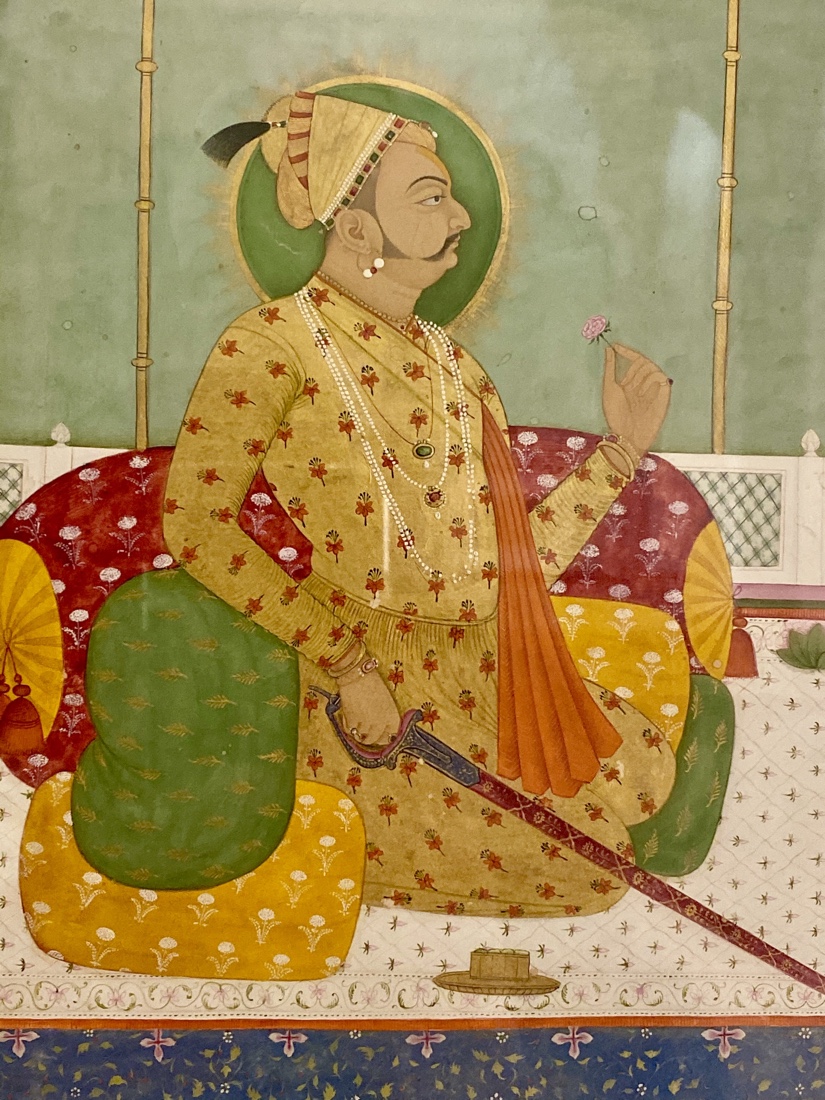 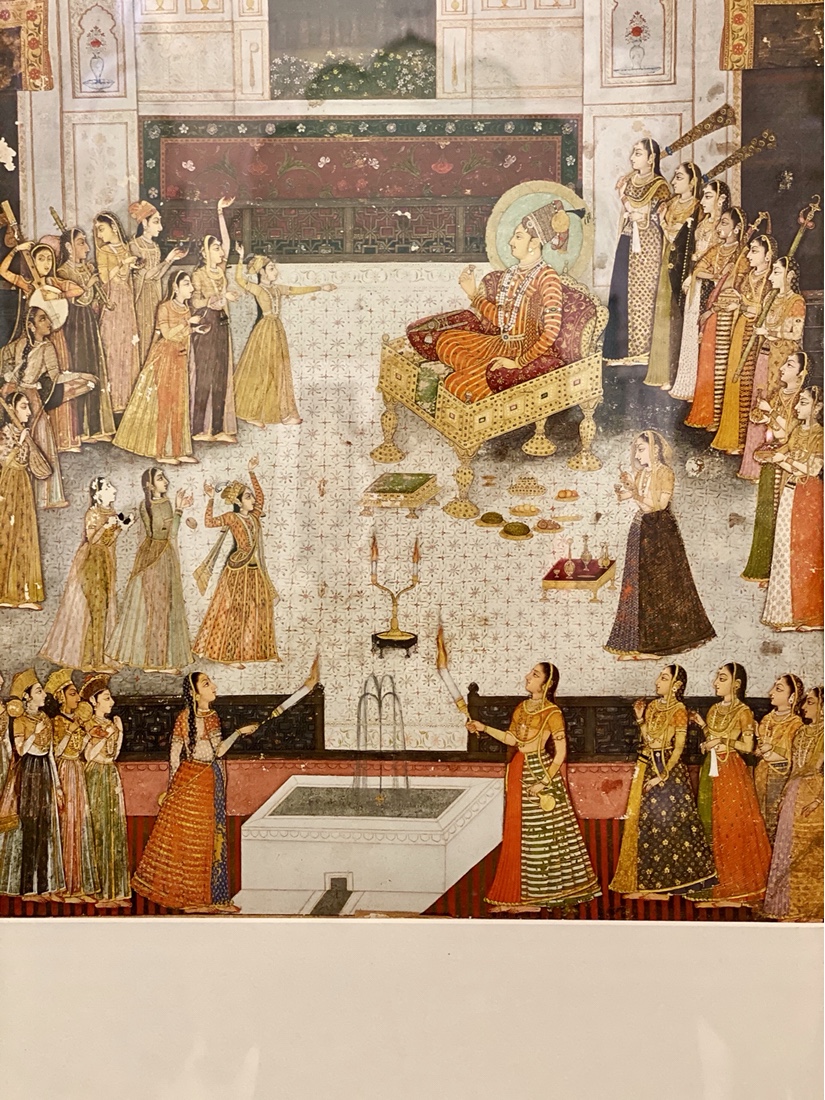 
After the fort, we visit Rao Jodha Desert Rock Park, spread over 72 hectares, nearby. The park contains ecologically restored desert and arid land vegetation. Sure nature’s the nuts, but walking around, and up and down, in heat and high humidity for more than an hour is overdoing nature, in my opinion. I use my walking sticks and, while I did okay, don’t expect to see me in the walking stick finals at the Tokyo olympics next year. There are birds, most of whom are sensible enough not to show their beaks in the heat. Here’s my best wildlife shot at the park.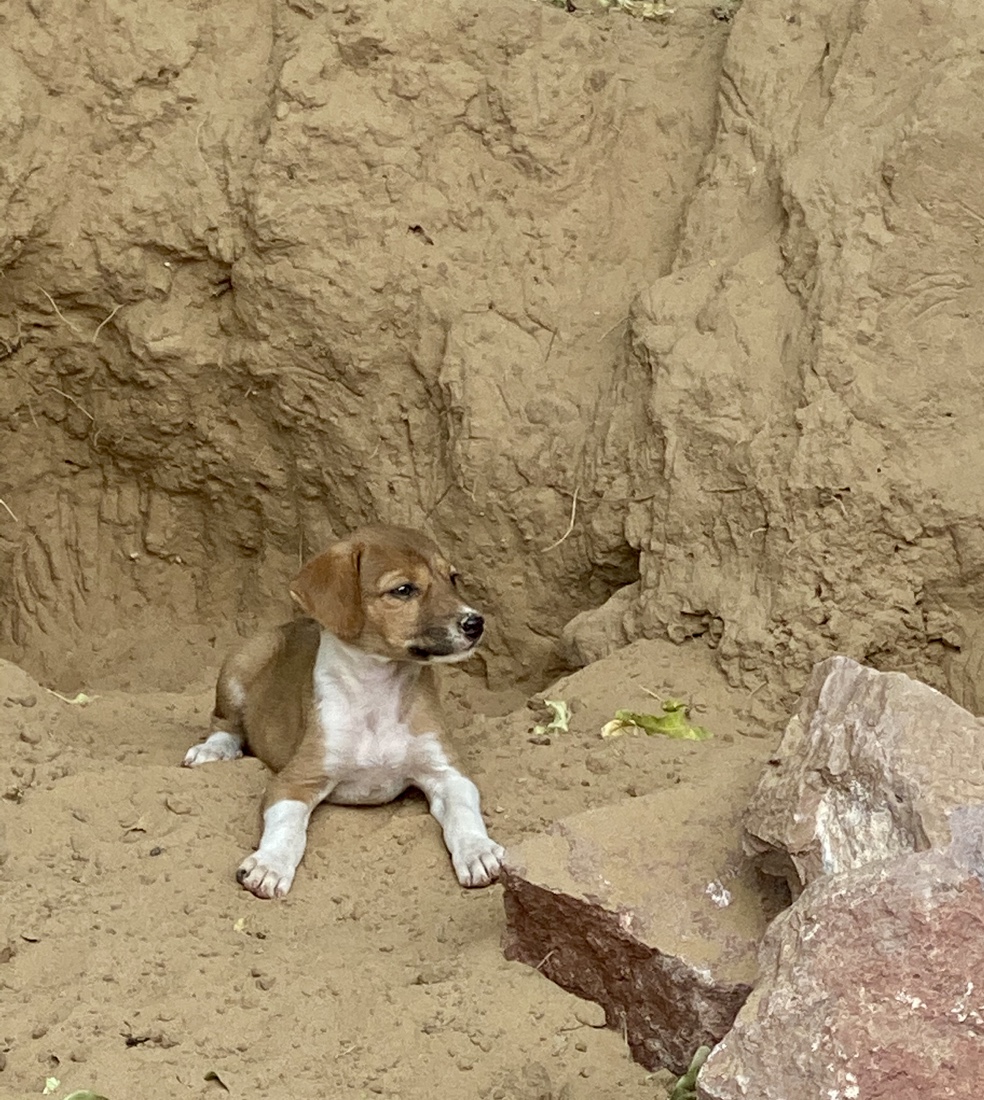 Carol, of course, liked the park, though she admitted that it wasn’t exactly comfortable. Carol, of course, liked the park, though she admitted that it wasn’t exactly comfortable.
After an excellent lunch, at an upscale and nicely air conditioned restaurant we head for Jawai. As we’ve jettisoned our guide, Praveen, after lunch, we are now only with our driver, Manu, who, it turns out, speaks much more English than we’d thought. We detour from the road for fifteen or twenty minutes to visit a village in which a resident (whose foot has been injured by his buffalo) demonstrates making opium tea for us. 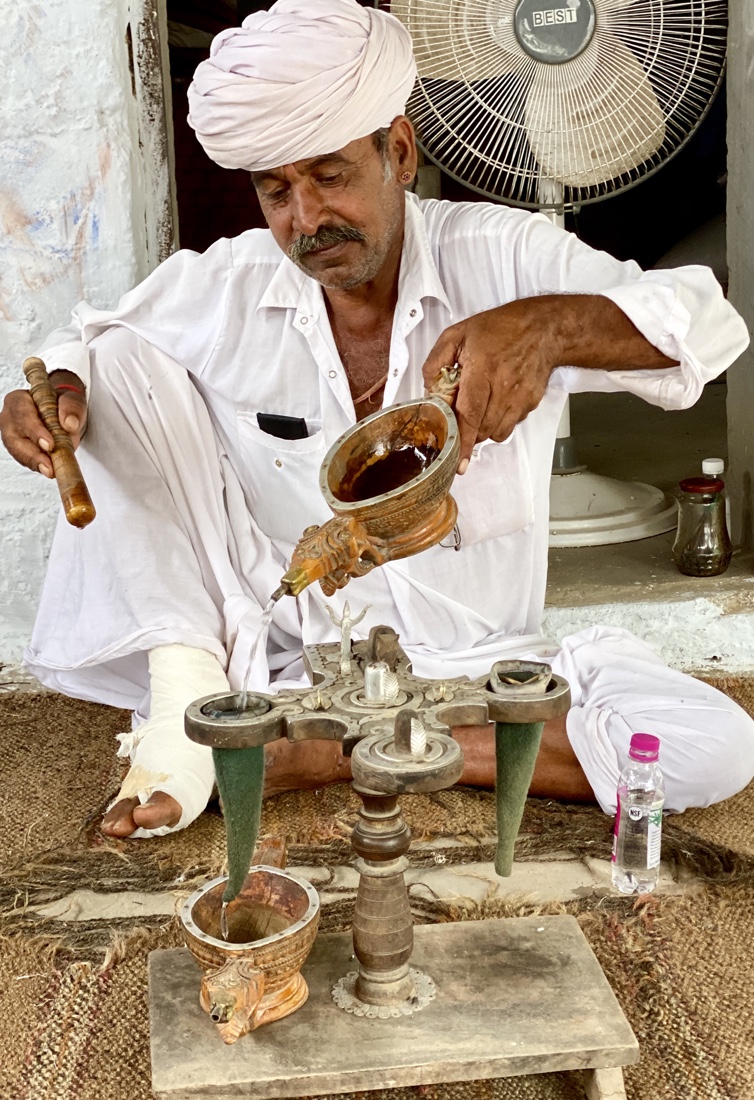 He offers us a taste and, after accepting, we begin to look like this. He offers us a taste and, after accepting, we begin to look like this.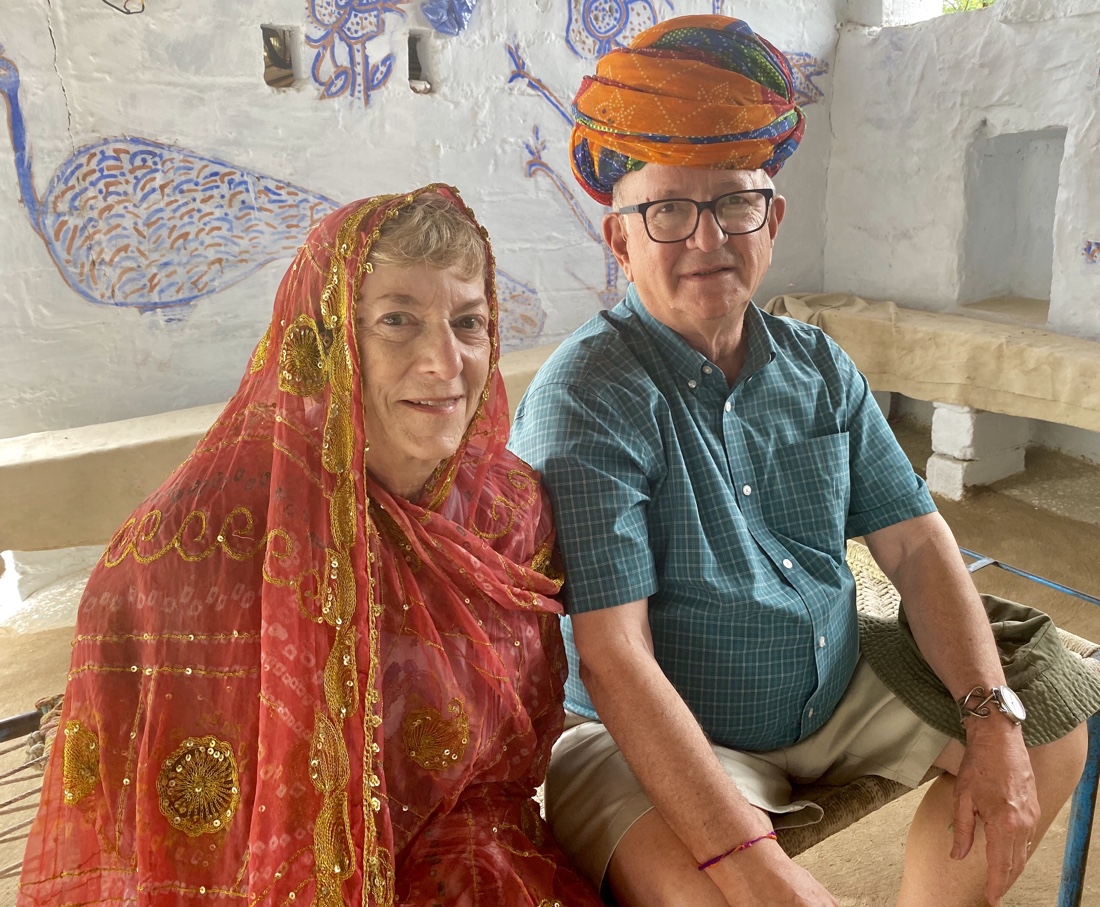 Here are photos of the outside and inside of our tea maker’s house. Here are photos of the outside and inside of our tea maker’s house.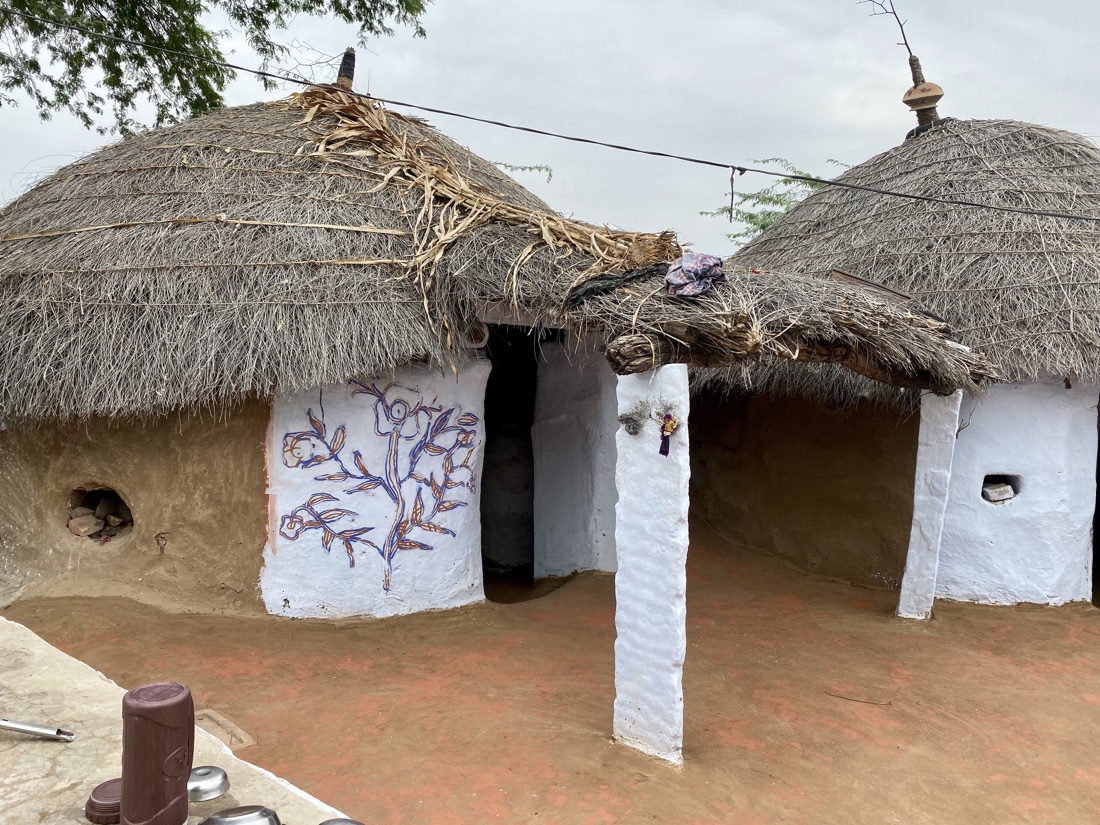 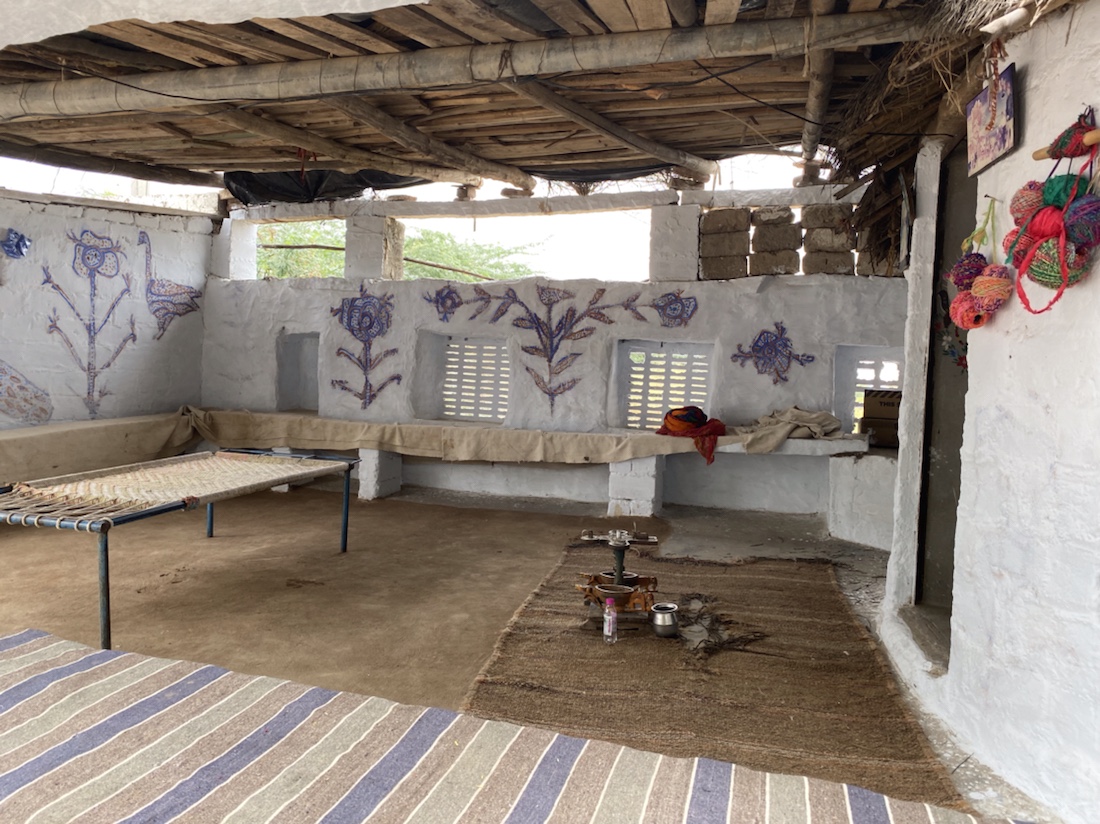 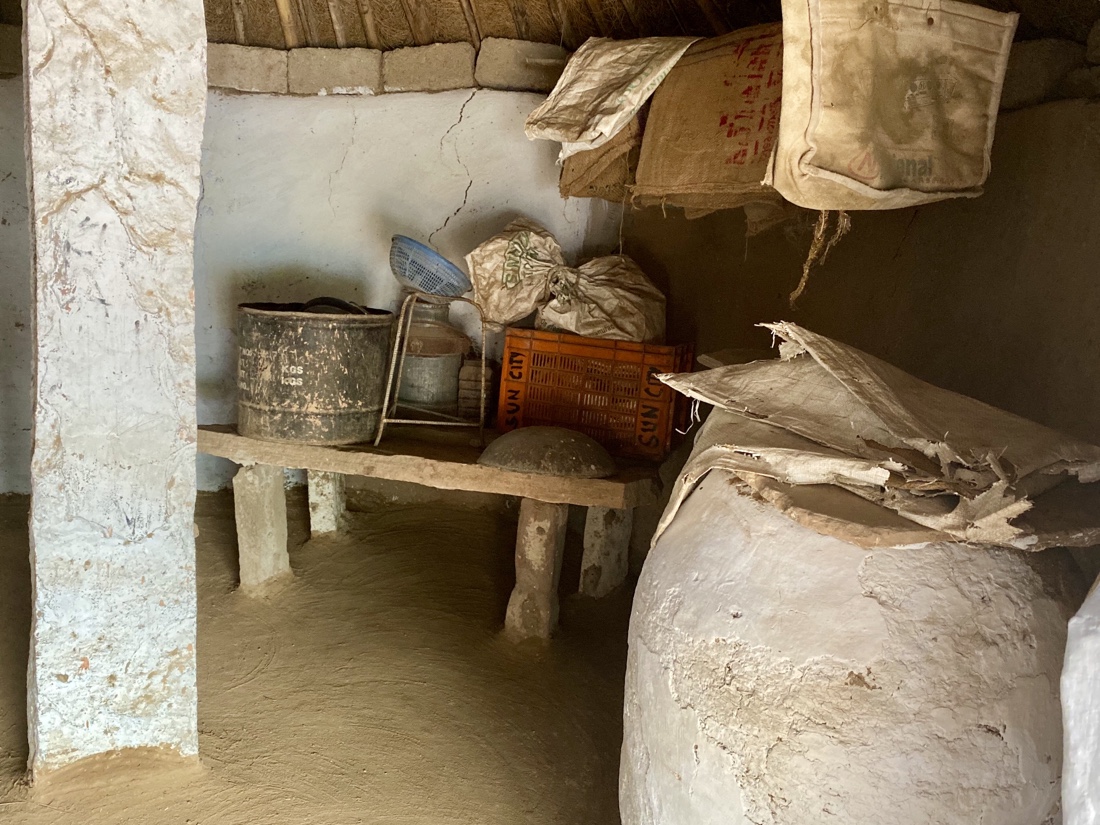 We also stop to see an excellent rug weaver nearby. Carol resists buying any, just because we have no conceivable place to use them. We also stop to see an excellent rug weaver nearby. Carol resists buying any, just because we have no conceivable place to use them. 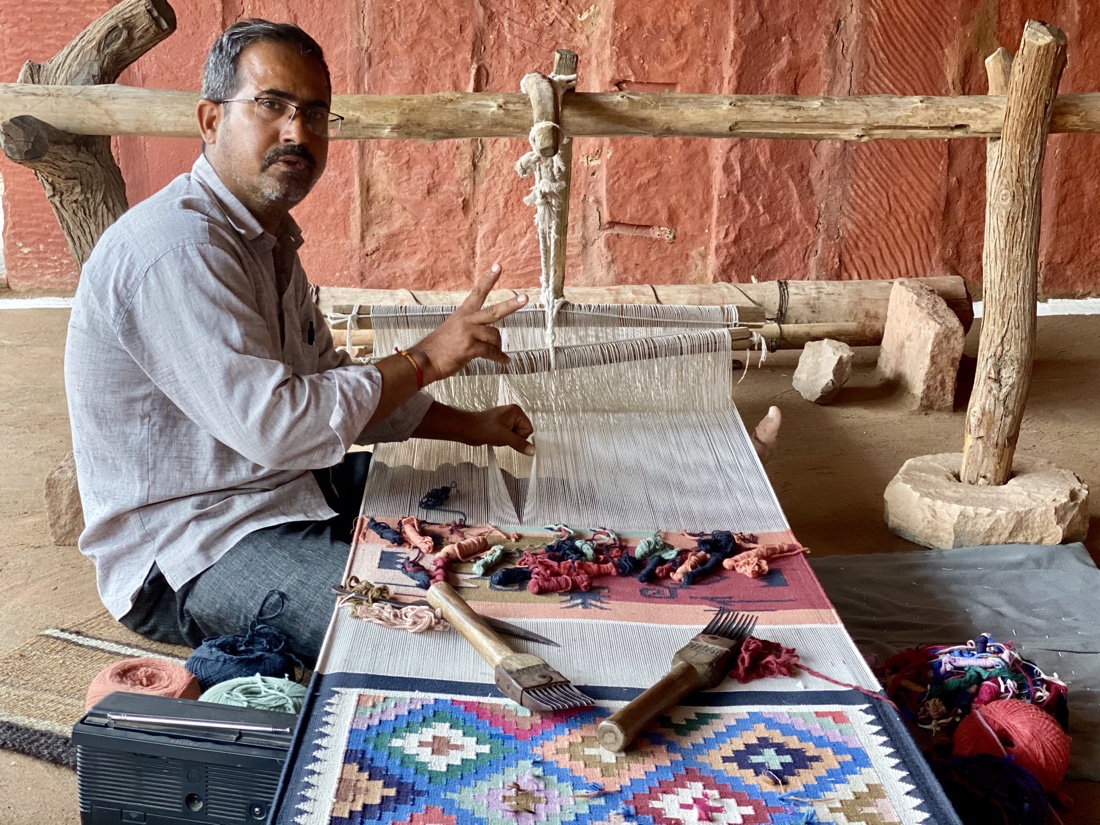 This decision seems to me to lack imagination, but, being the compliant husband that I am, I accede. This decision seems to me to lack imagination, but, being the compliant husband that I am, I accede.
Here’s a scene from the back of a truck we get behind in a town not far from Jawai.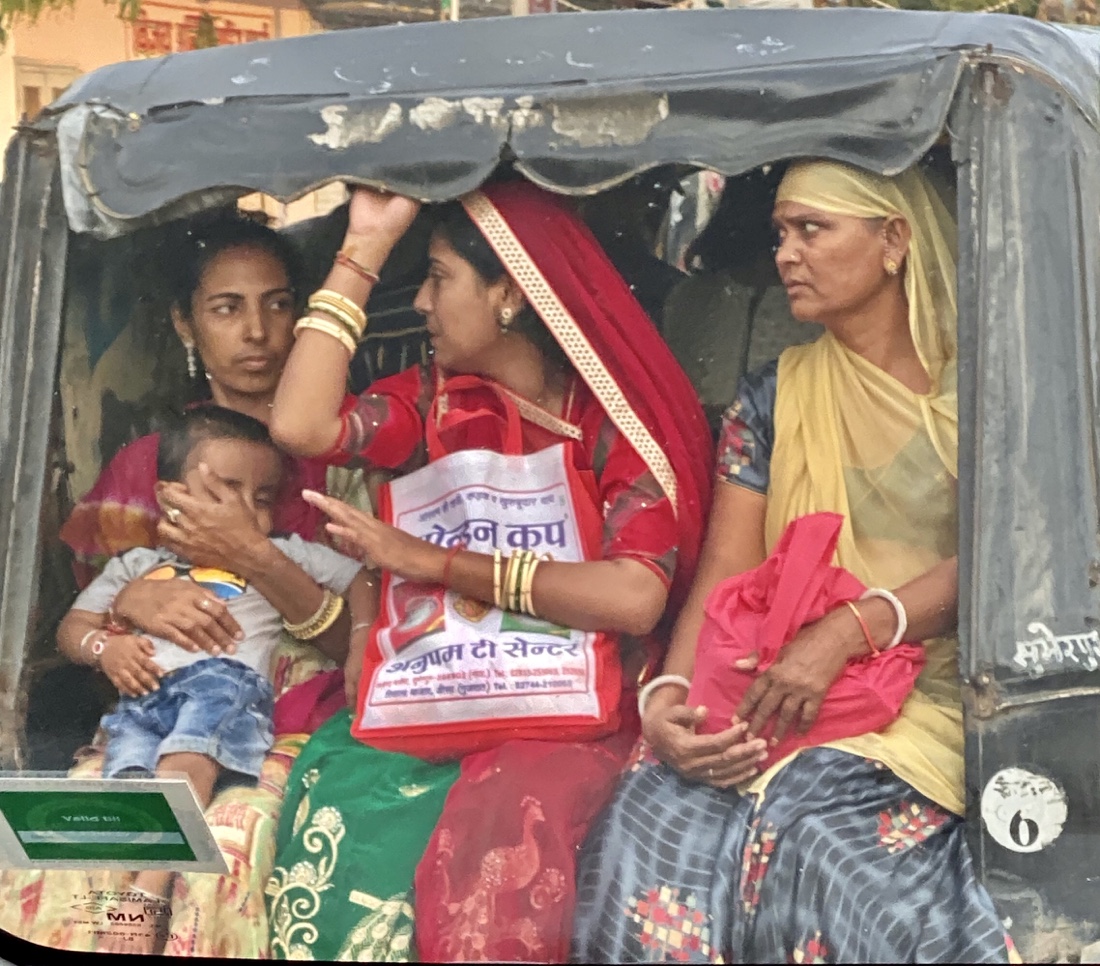 And here are some folks on a motorcycle, stopped at a railroad crossing, where a crowd has gathered, because a few hours earlier, somebody had been struck and killed by a train. And here are some folks on a motorcycle, stopped at a railroad crossing, where a crowd has gathered, because a few hours earlier, somebody had been struck and killed by a train.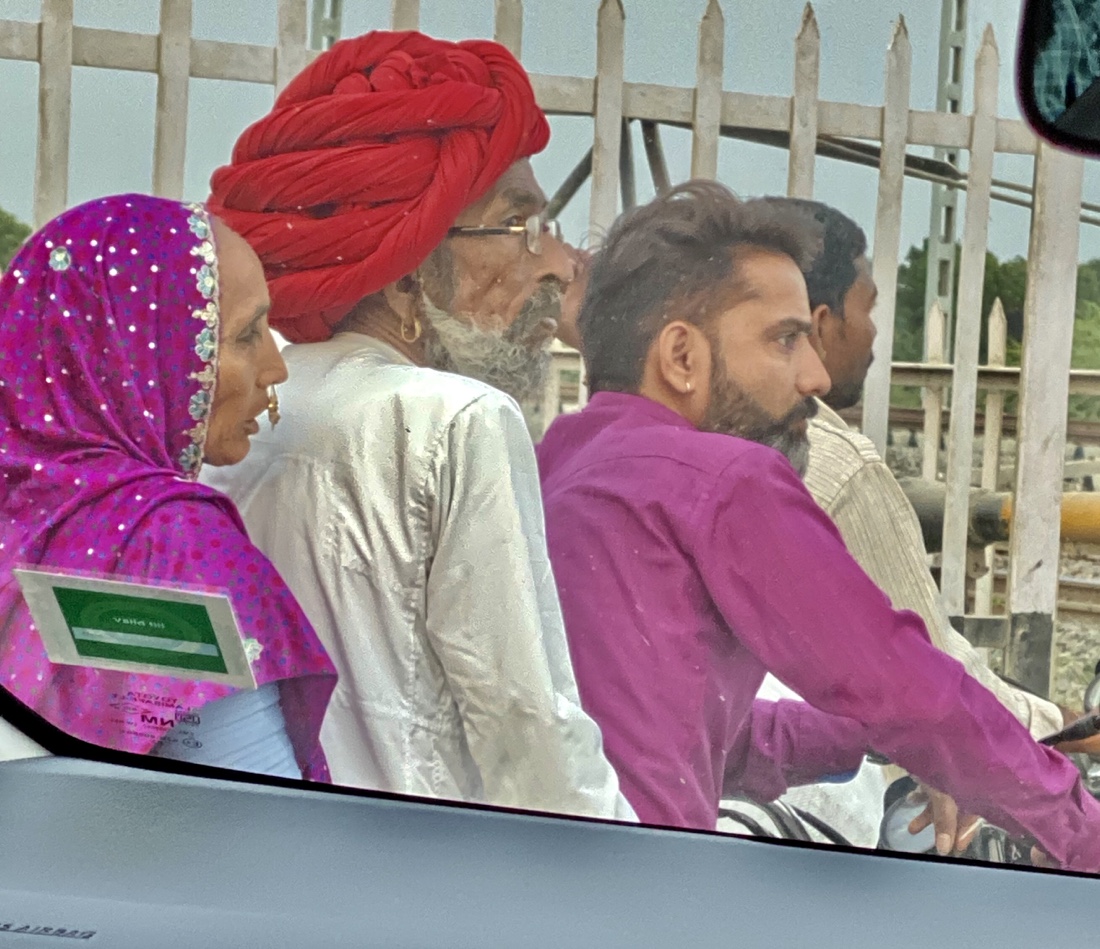 We stay at Hotel Jawai, in African style tents with wonderful views of the grasslands and the landscape. Here’s the backdrop for the camp. We stay at Hotel Jawai, in African style tents with wonderful views of the grasslands and the landscape. Here’s the backdrop for the camp.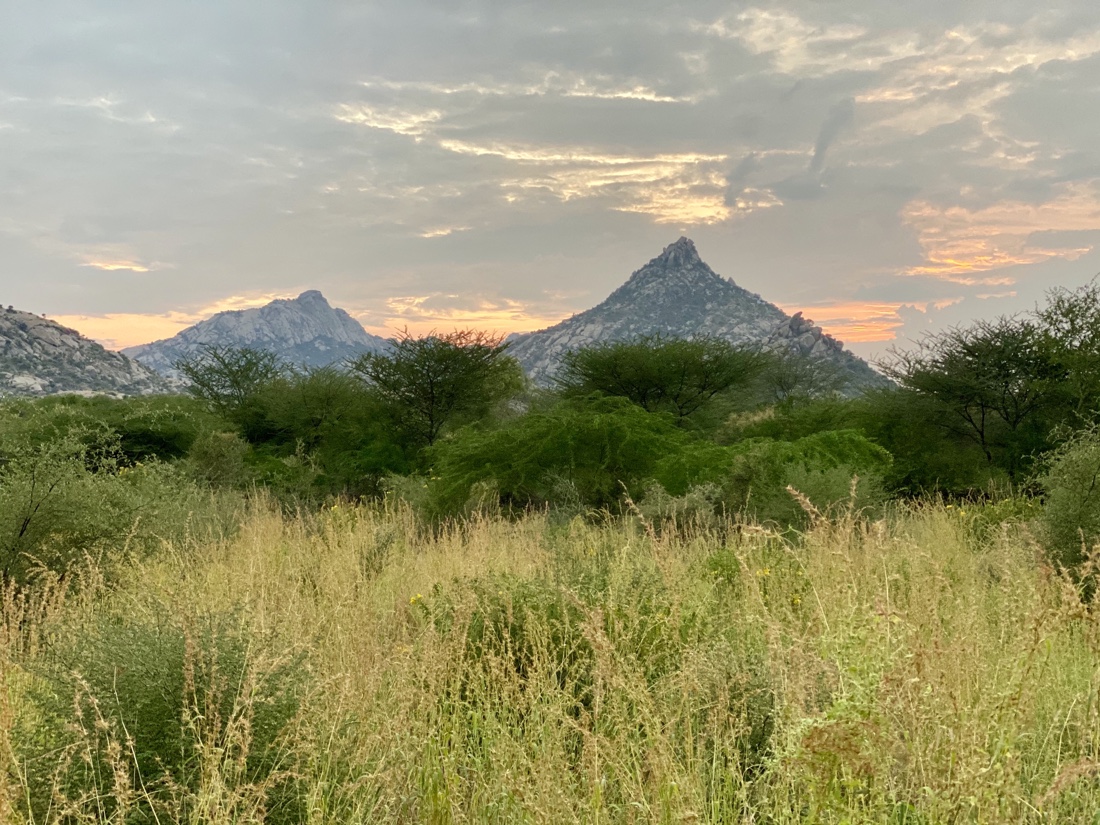
We are transferred from our van to a Jeep to be transported to the camp, which is a Relais & Chateaux property. We’re greeted by the managers and shown to our tent, which has a separate bathroom area, hot water, electricity, air conditioning and WiFi. 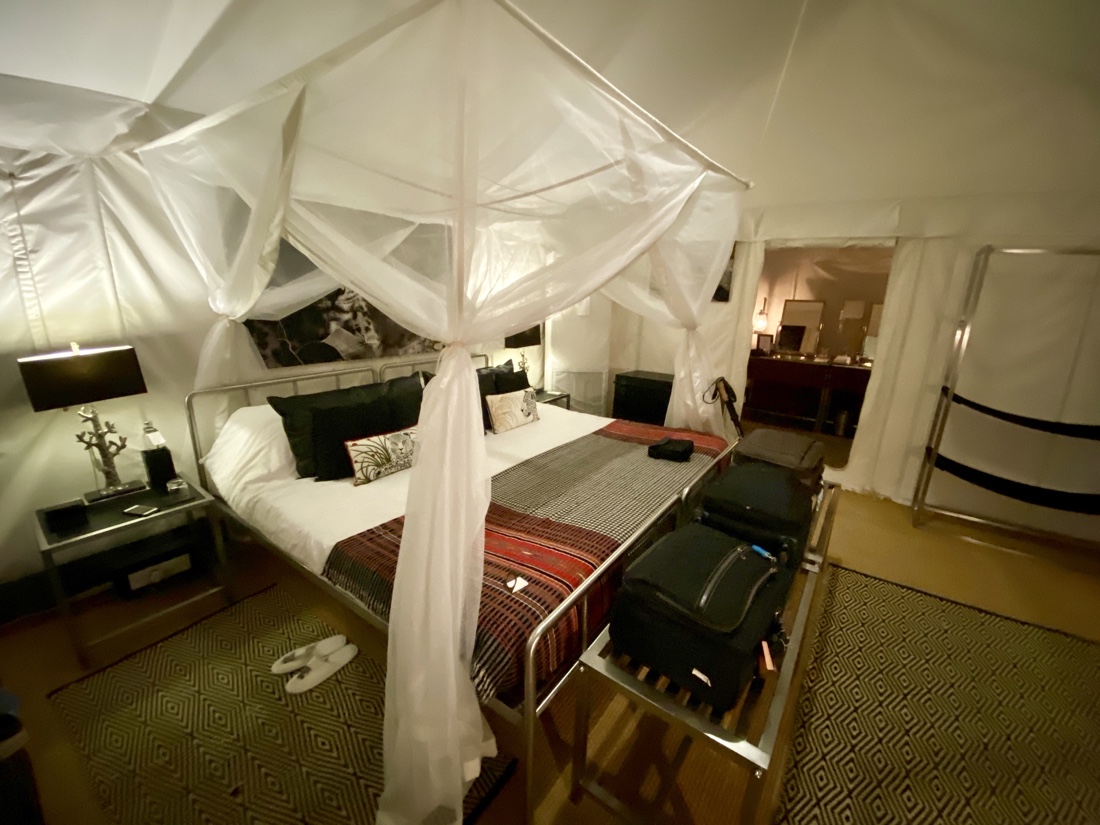
The name of the WiFi network at Jawai is “Ruin my holiday.” In an ultimate irony, I learn that the WiFi is out in our condo at home by reading am email from our building manager while seated by the campfire tonight in the desert in India.
We have an excellent dinner and retire to our tent to prepare for an early safari tomorrow morning.
Breakfast at the hotel, which, of course, would not be complete without live music.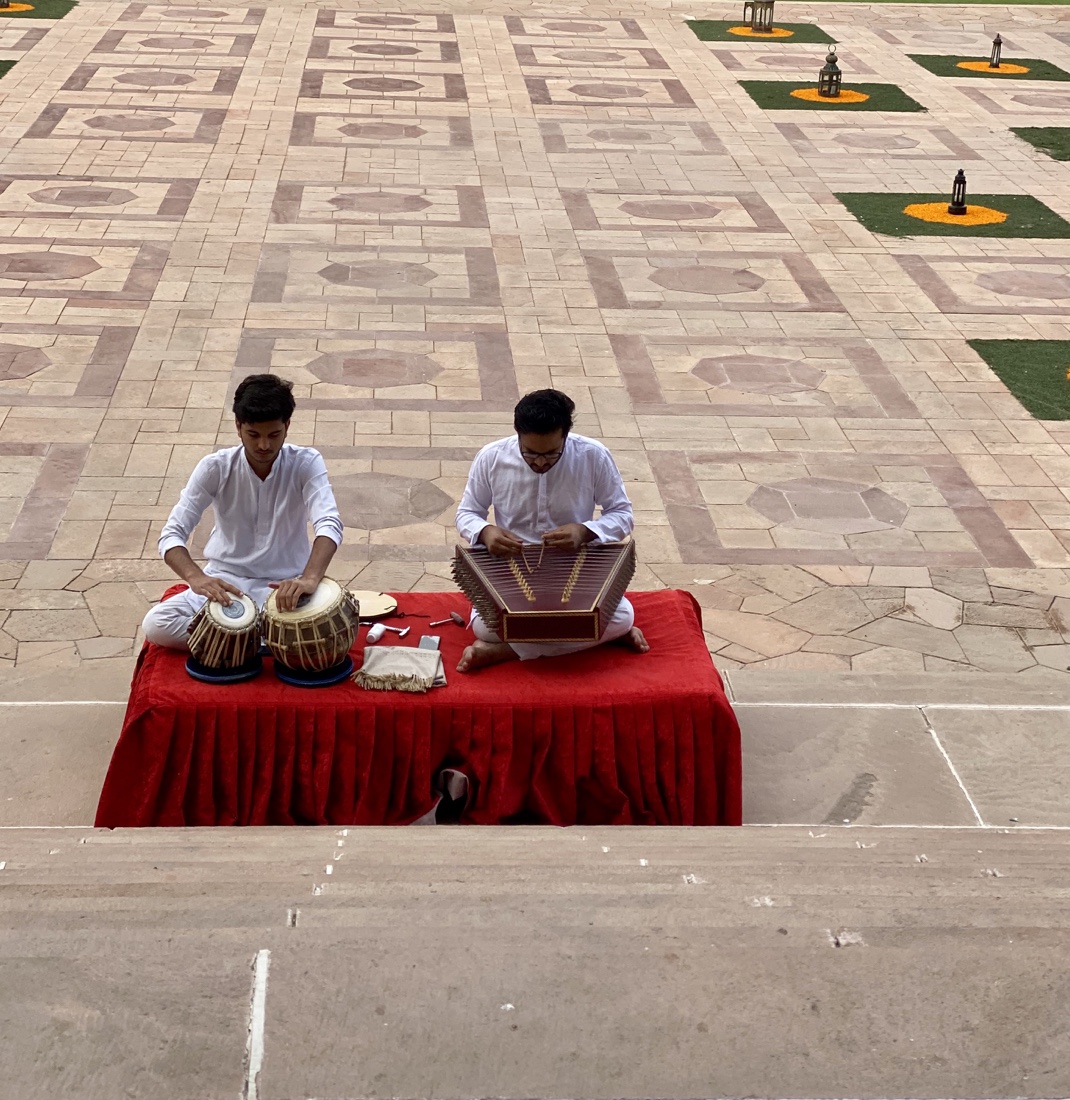
A bit of history, and myth. The Kingdom of Jodhpur was established by the powerful Rathor clan who claim ancestry as far back as 470 AD. In the mid 15th century, Rao Jodha, the ruler of Marwar, abandoned his old capital and built a new fort on the rocky cliffs of what is now Jodhpur. According to legend, in the process of building the fort, he displaced a hermit who was meditating on the site. The hermit placed a curse on the descendents of Rao Jodha saying they would be plagued by famine every year. This is the reason the locals claim that the area has drought every three or four years. The gigantic Umaid Bhavan Palace Where we are staying was built as a result of a project initiated by the Royal family during a famine to provide employment.
Our “safari” today is designed to give us an authentic rural experience to an area that is completely devoid of tourism and commercialization. It gives us the opportunity to see the daily struggles and the joys of the hardy yet very welcoming people of the desert. We switch to a Jeep to rude on bumpy dirt roads, our driver having to get out frequently to open and close stick gates.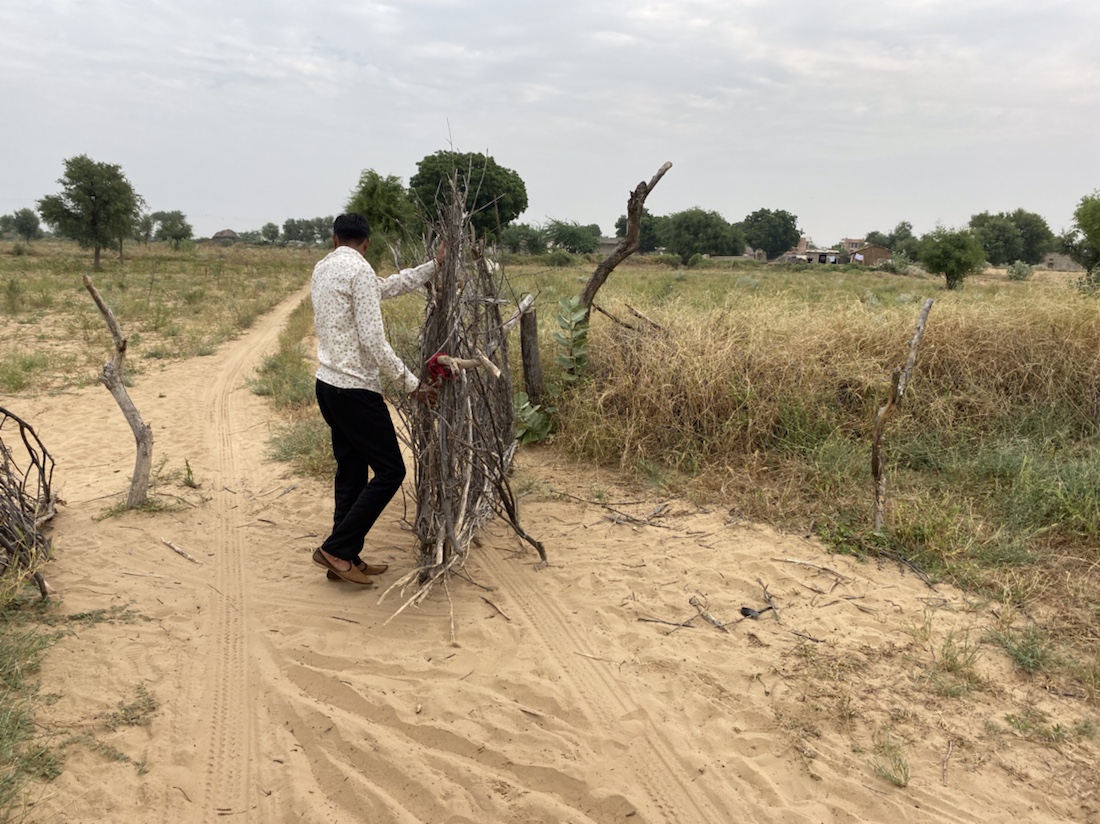 We first visit the Bishnoi tribe who are regarded as the first environment conservationists of the world, and have been preserving the flora and fauna for the past 550 years as a sacred tenet of their religion. They live in a small “Dhani” or settlement of mud and stick huts, one of many that dot the desert region of Marwar. They are resourceful in storing things in the sticks of their huts for ready access. We first visit the Bishnoi tribe who are regarded as the first environment conservationists of the world, and have been preserving the flora and fauna for the past 550 years as a sacred tenet of their religion. They live in a small “Dhani” or settlement of mud and stick huts, one of many that dot the desert region of Marwar. They are resourceful in storing things in the sticks of their huts for ready access.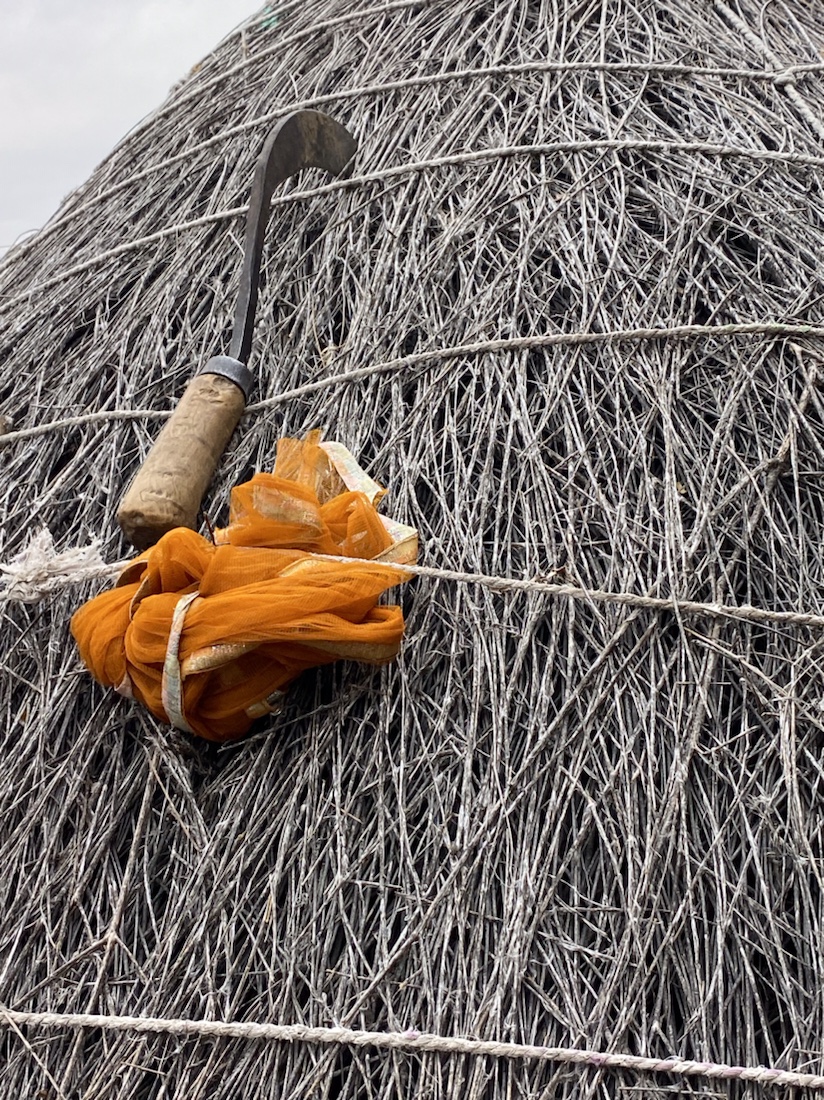 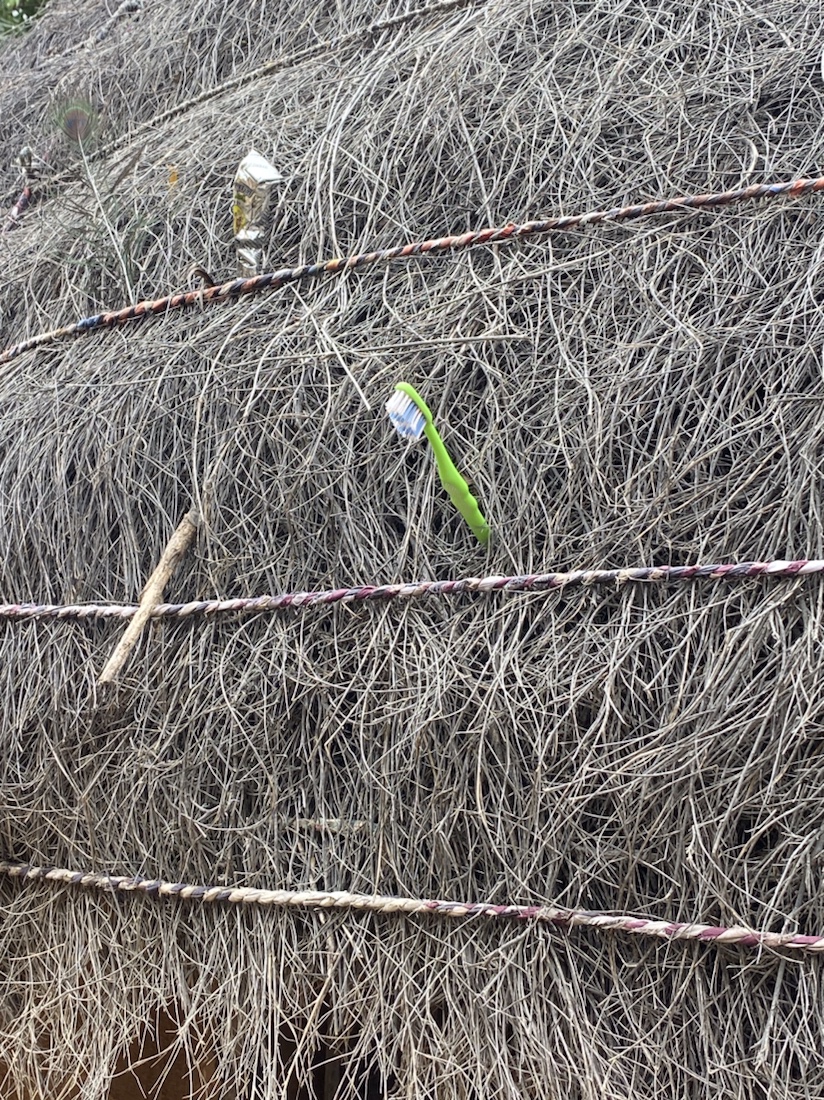
most of the men are out visiting friends to wish them a Happy Diwali, but there are some women and children around.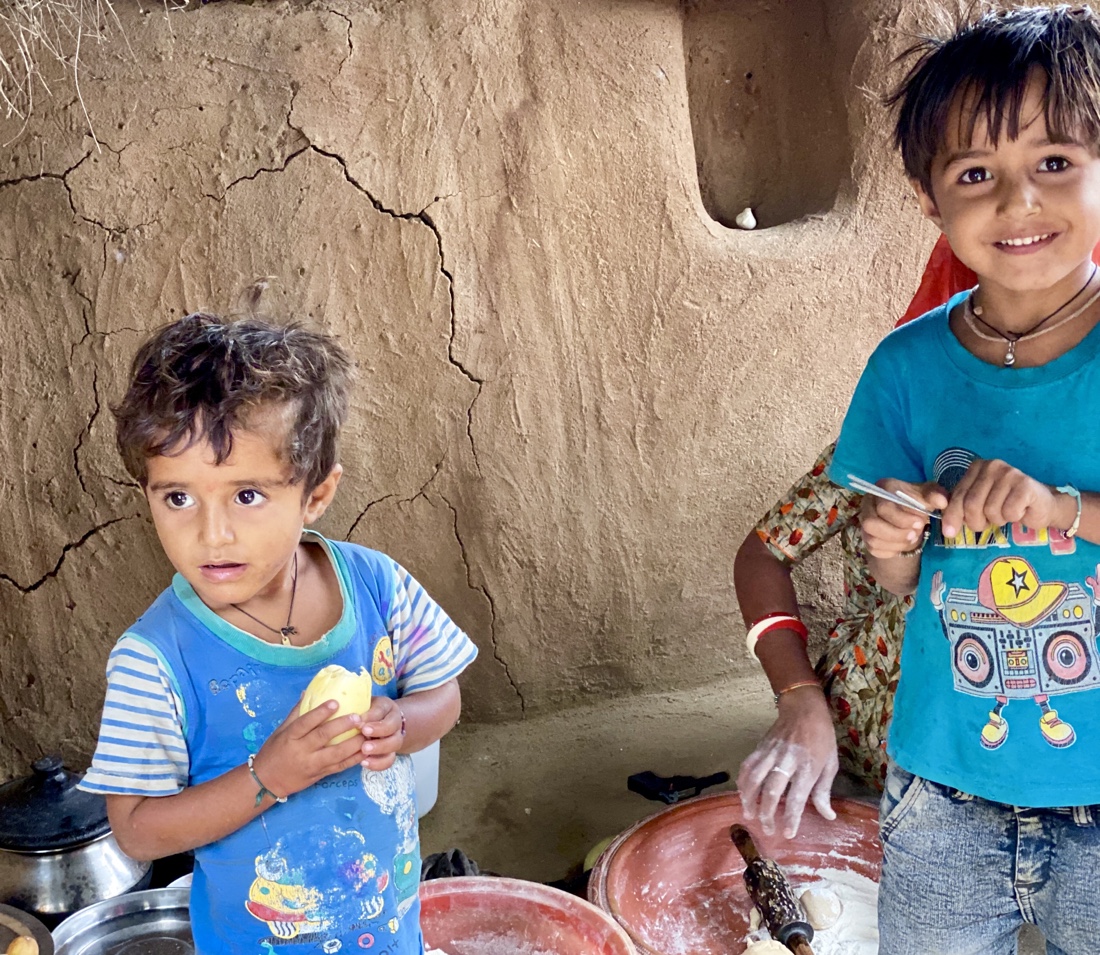 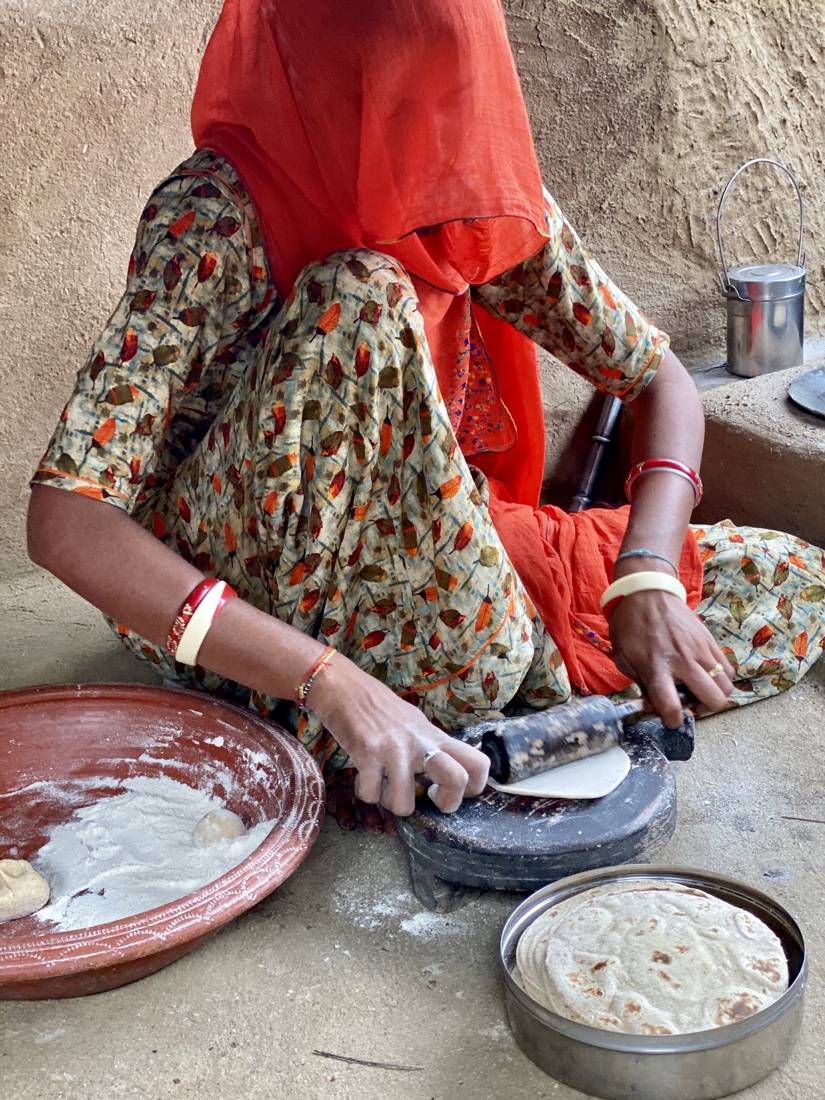 We also see the thriving cottage industry in a region where skills of the hands earned more than farming in this inhospitable land. We stop at small workshops doing pottery We also see the thriving cottage industry in a region where skills of the hands earned more than farming in this inhospitable land. We stop at small workshops doing pottery 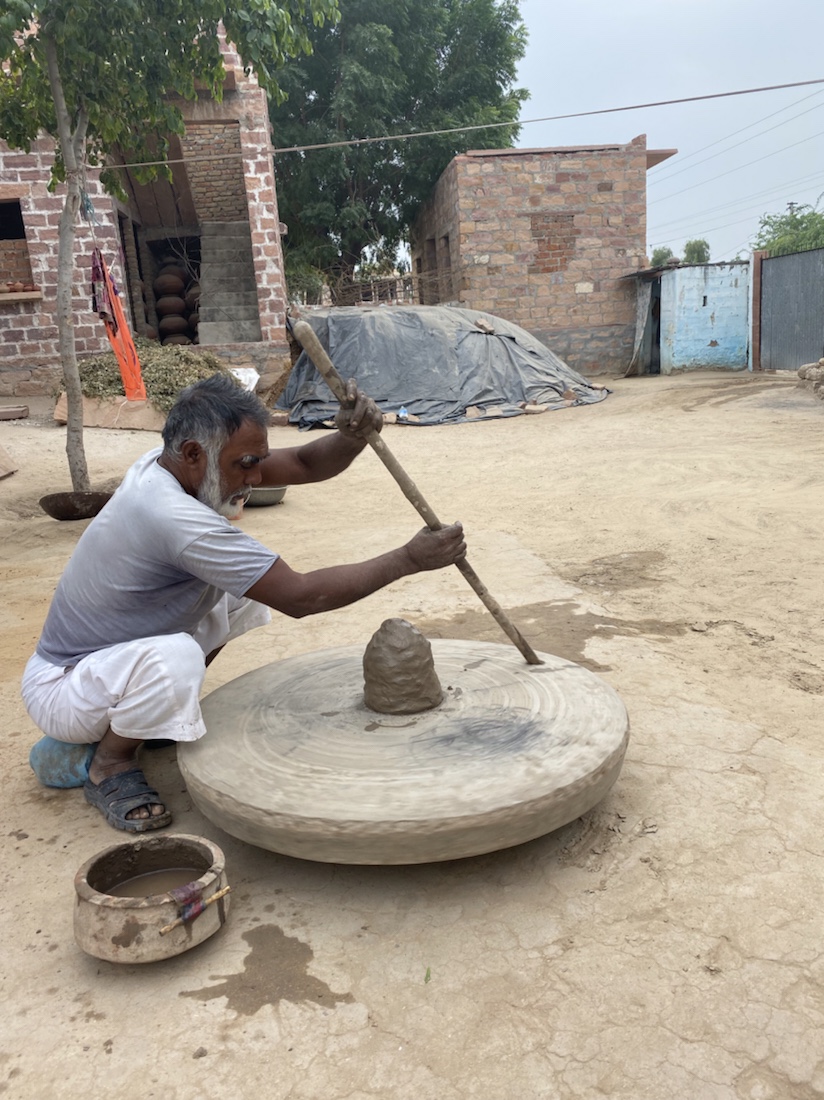 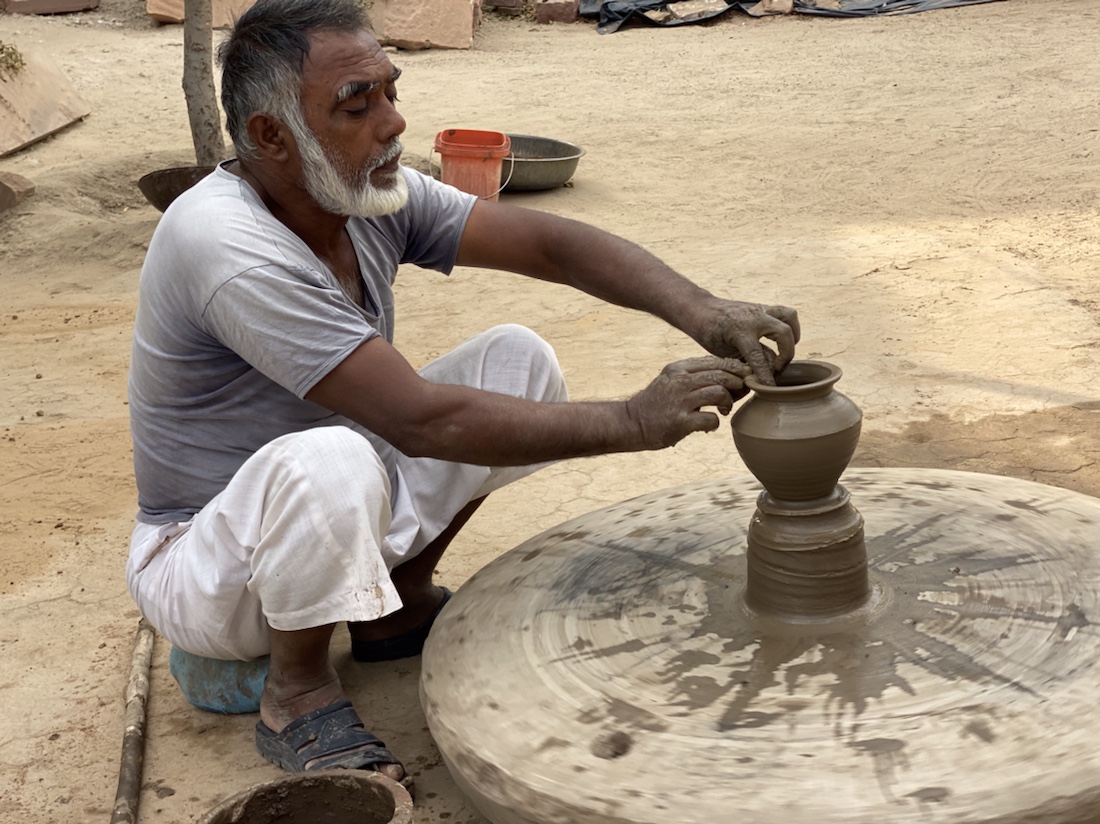 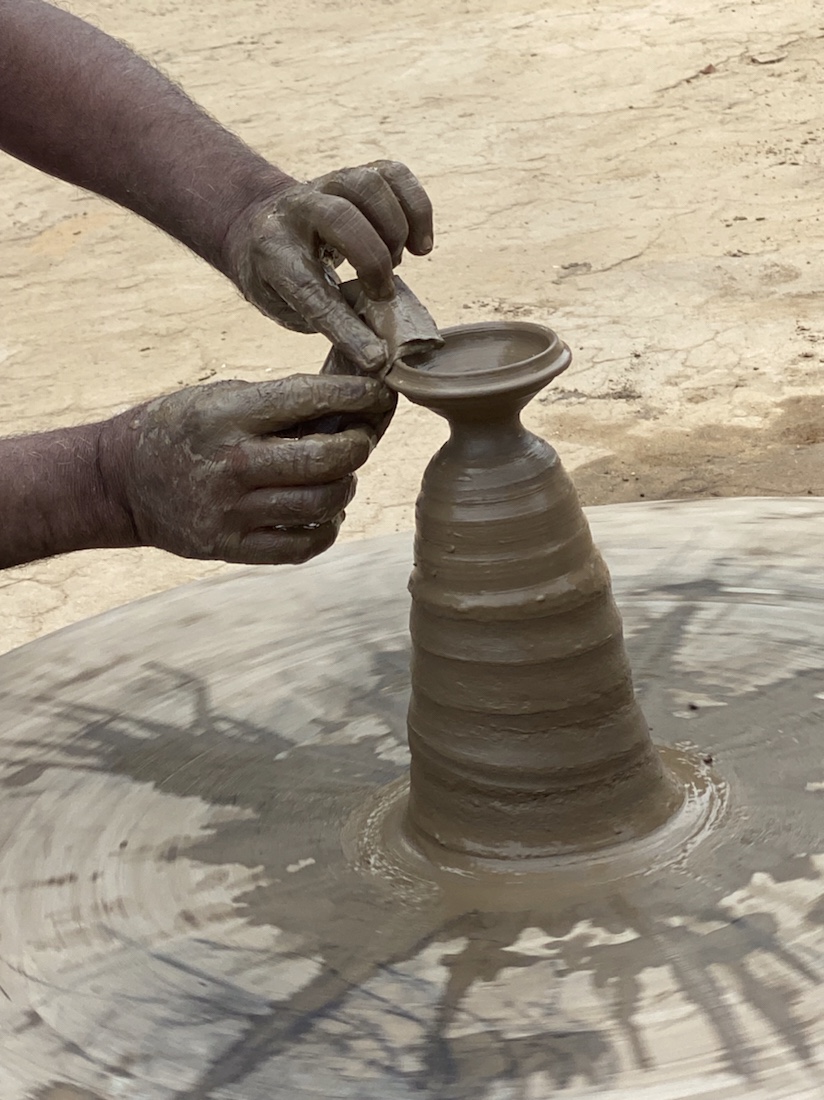 embroidered jootis (camel leather shoes), embroidered jootis (camel leather shoes), 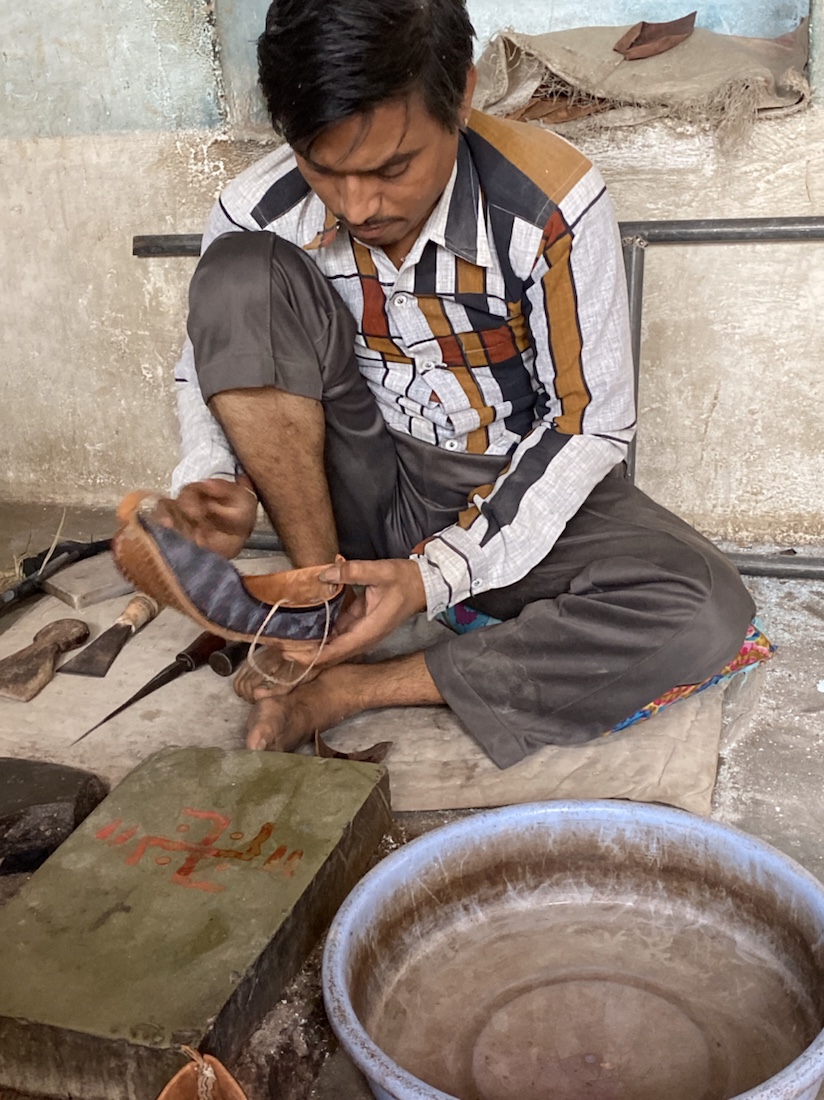 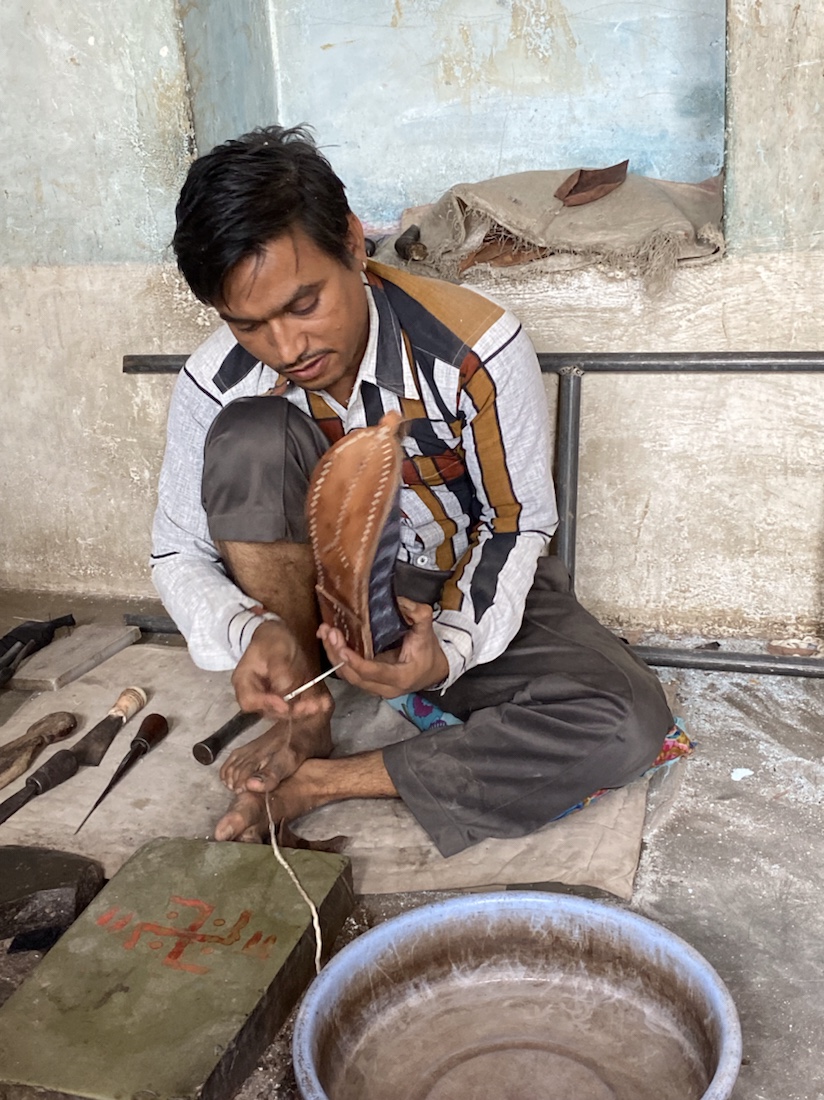 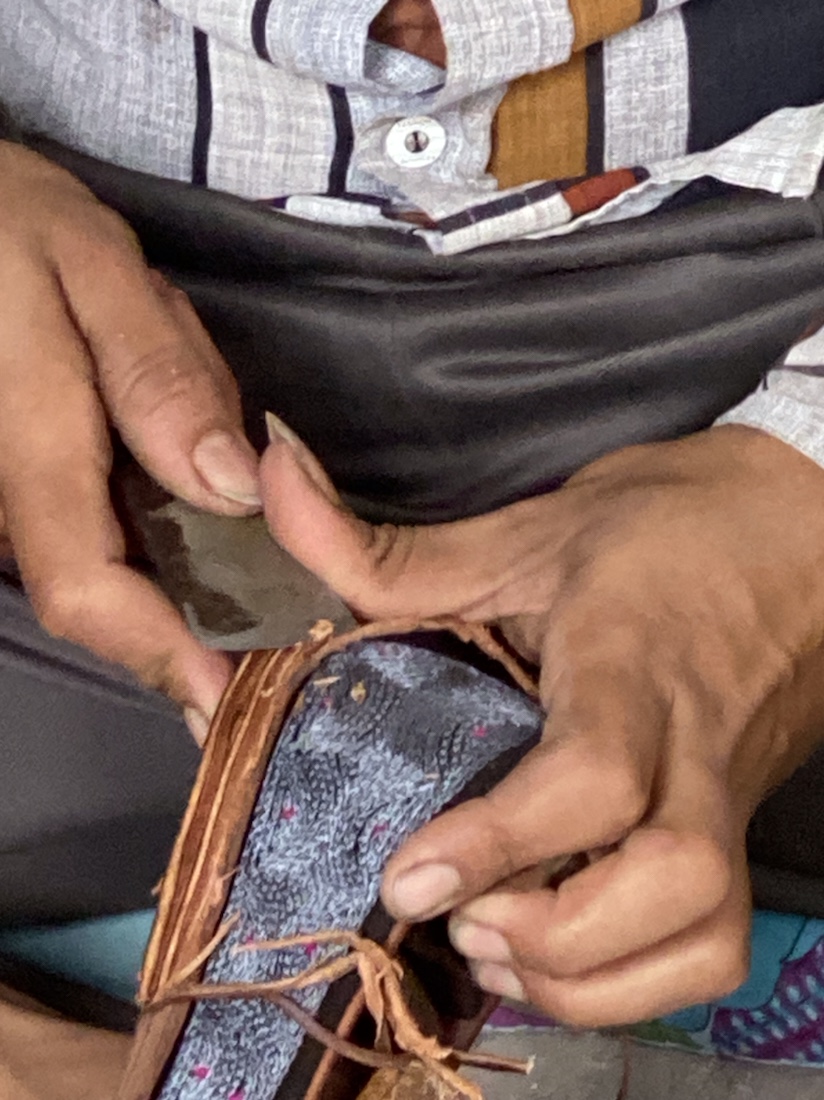 the famous pattu weaving the famous pattu weaving 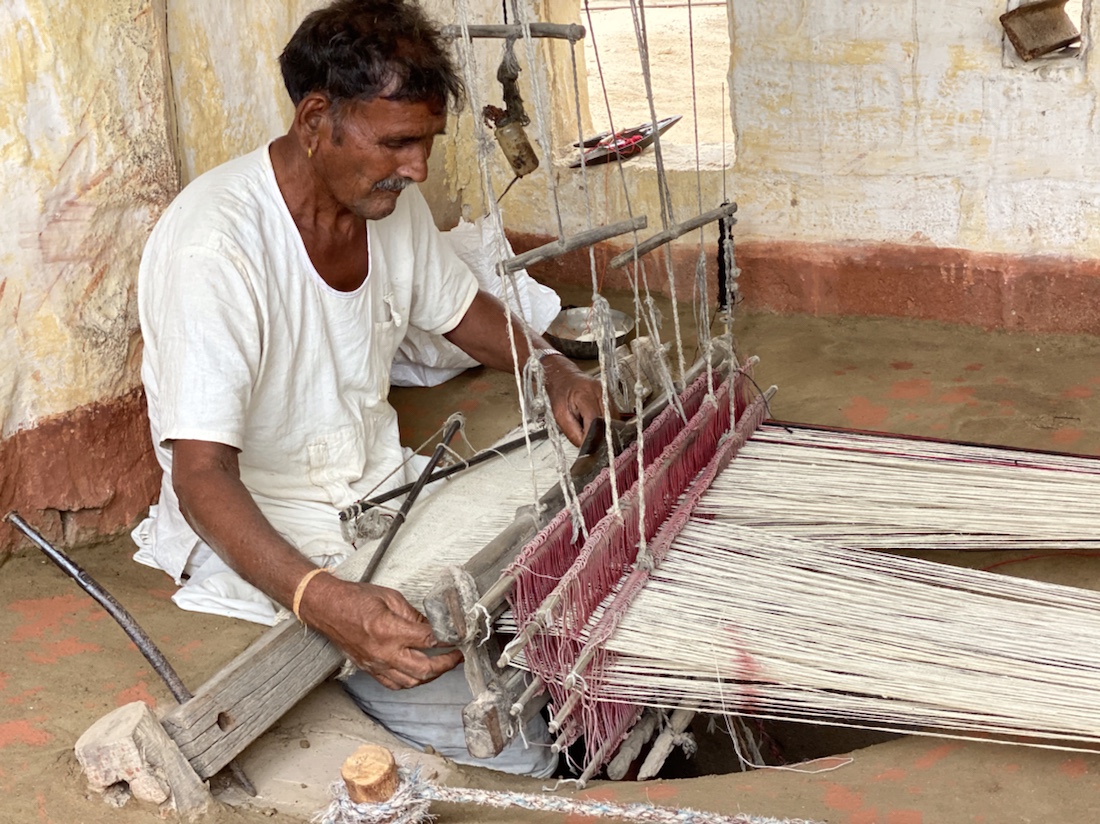 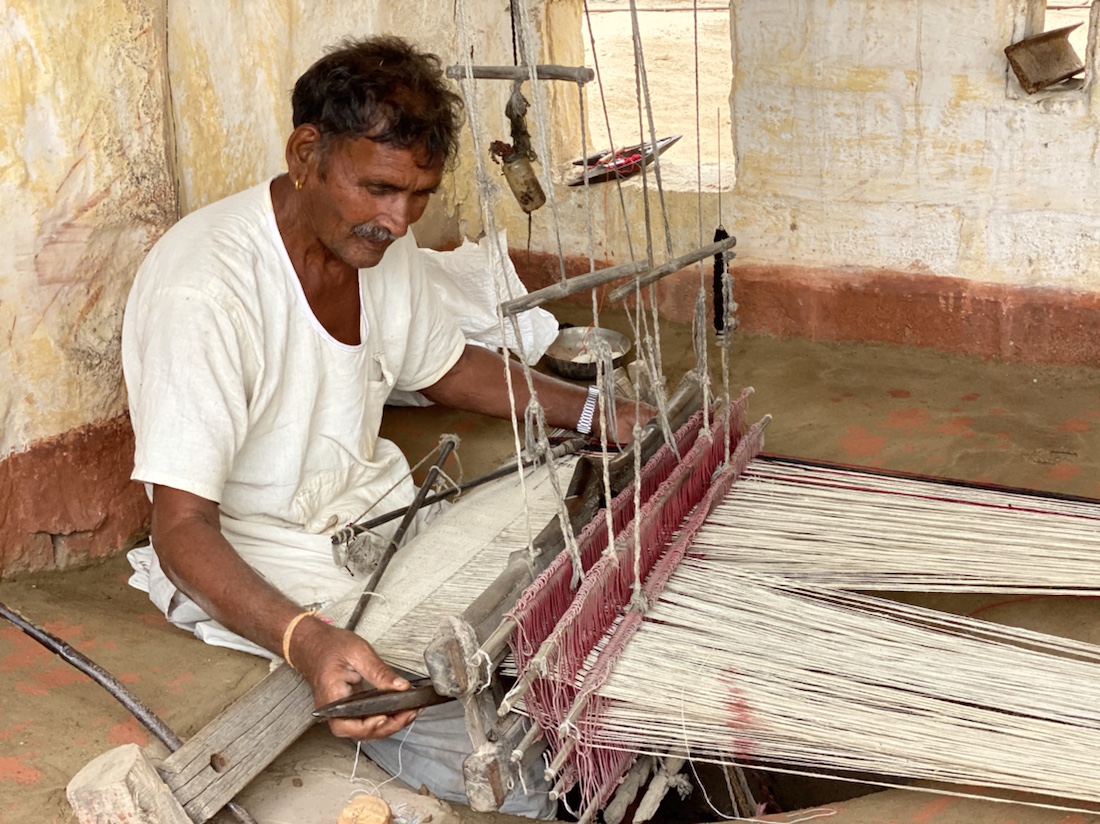 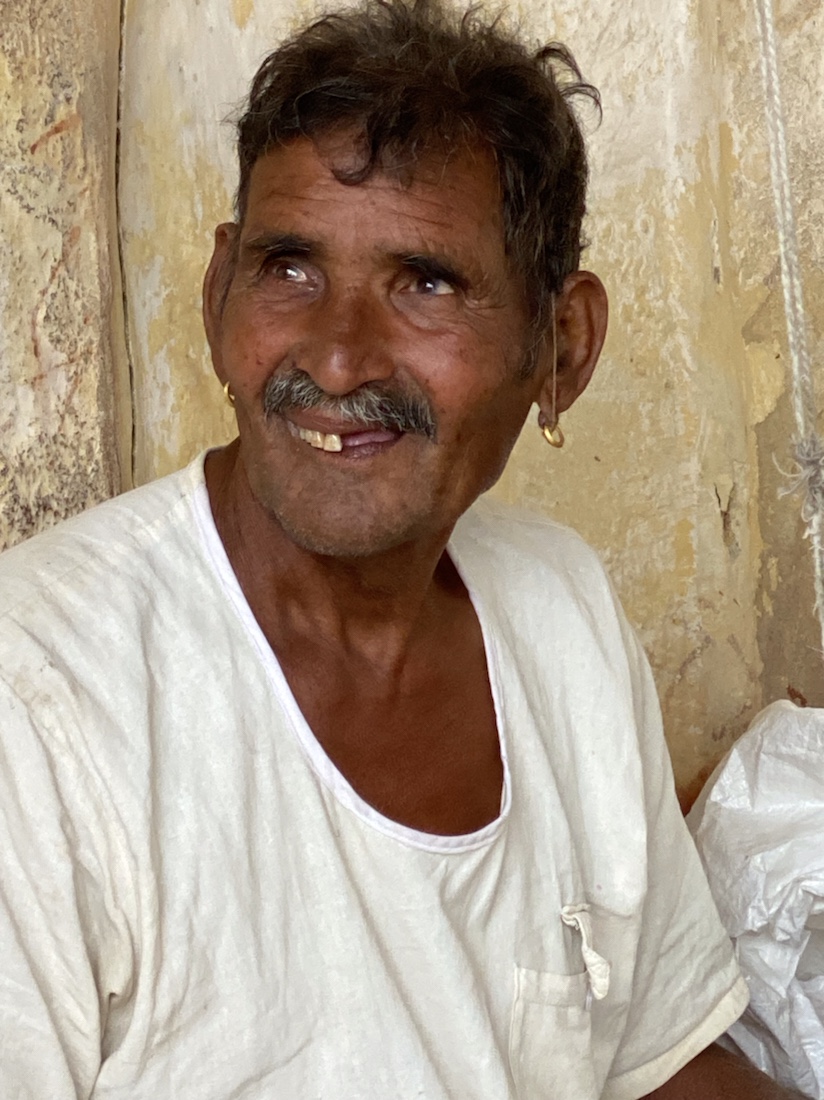 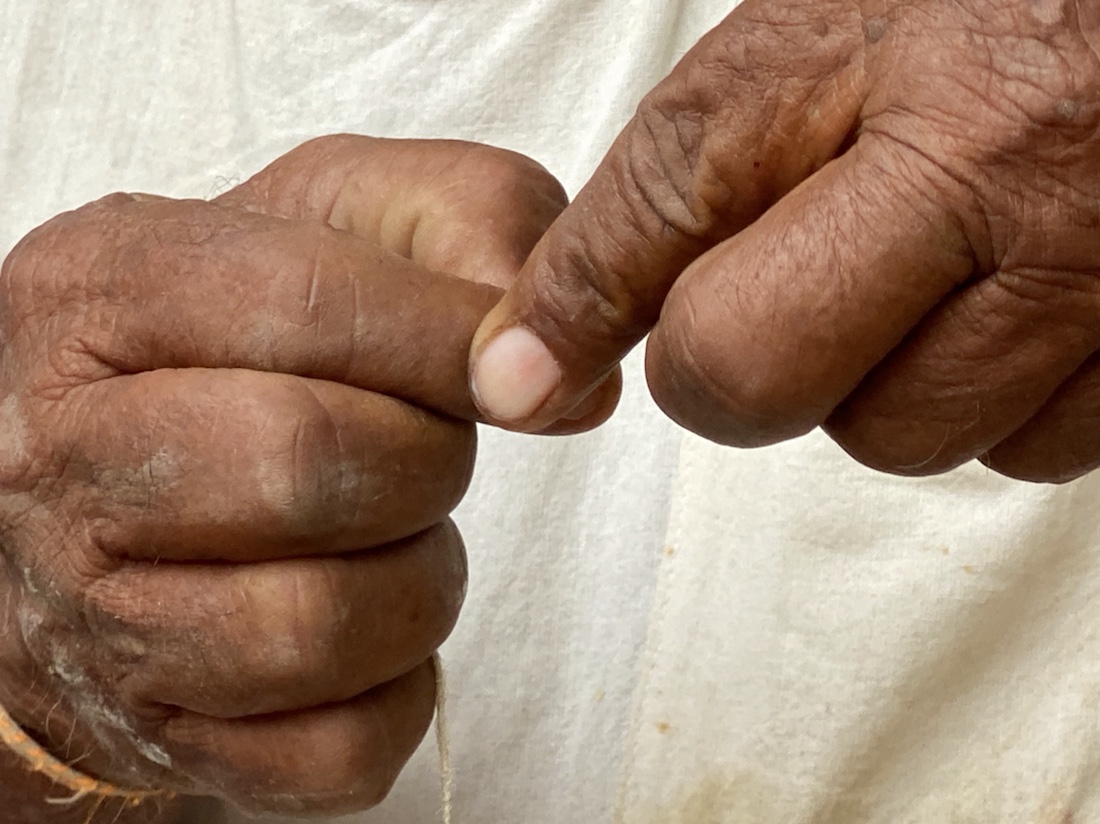 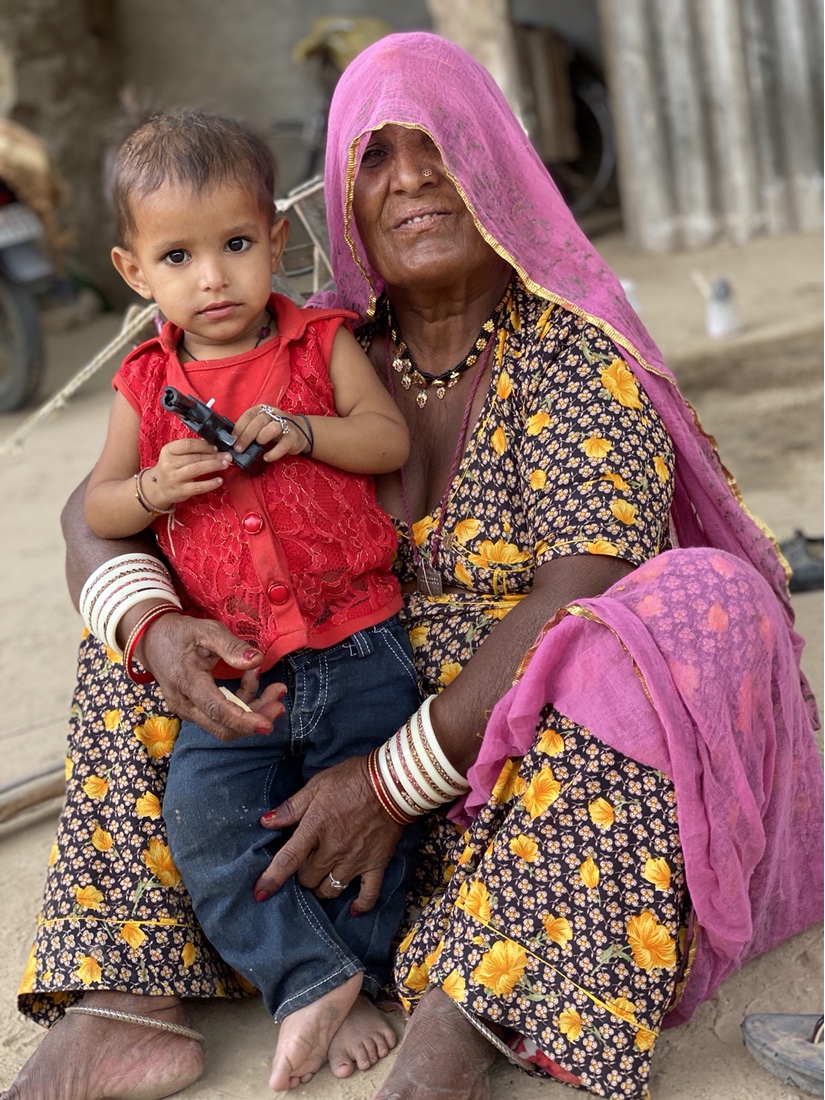 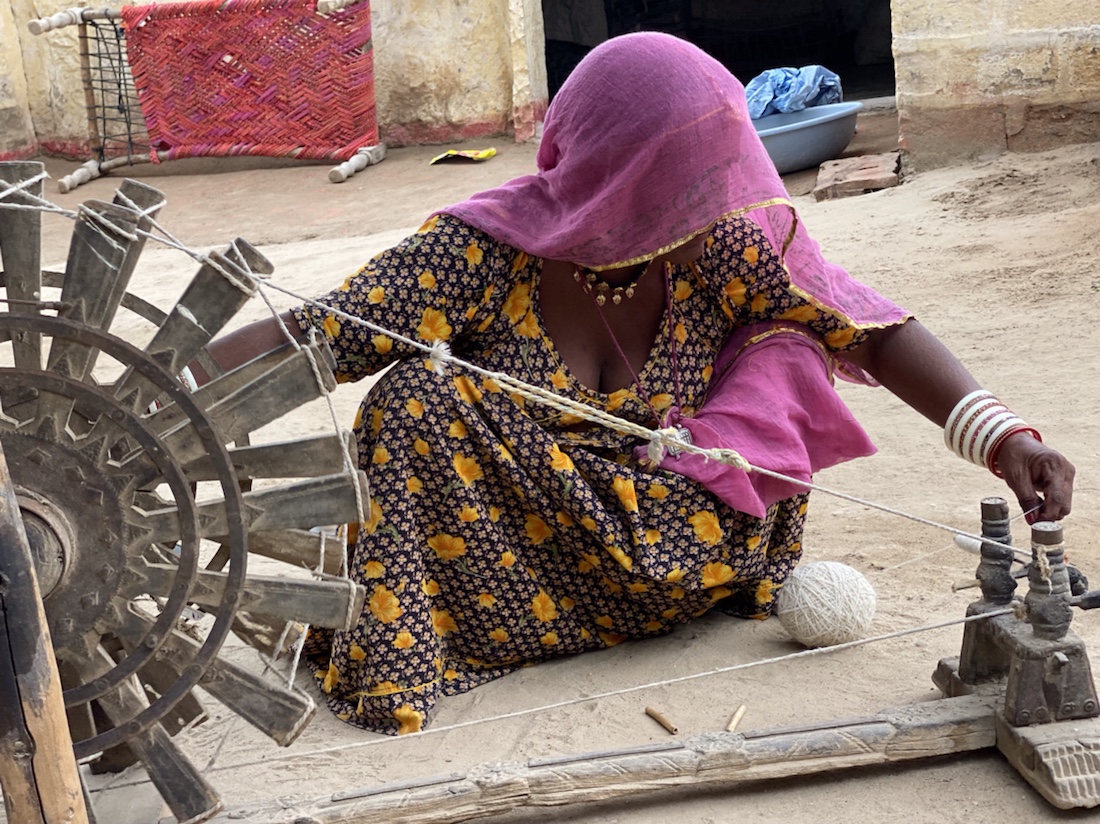 and embroidery and embroidery 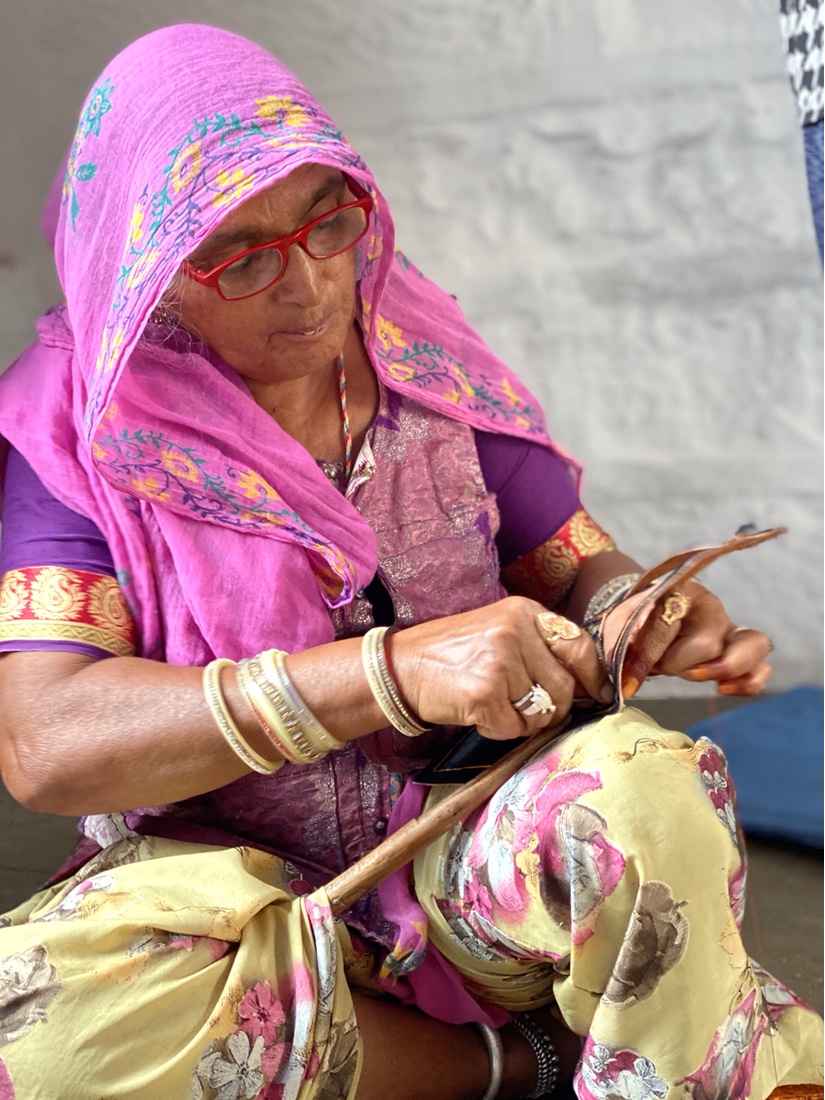
of these craft visits is that we were not pushed to buy anything. In fact,,nothing was even offered to us for sale. This is in complete distinction from every other craft visit we’ve made any place else in the world.
Of course, there are the inevitable cute little kids.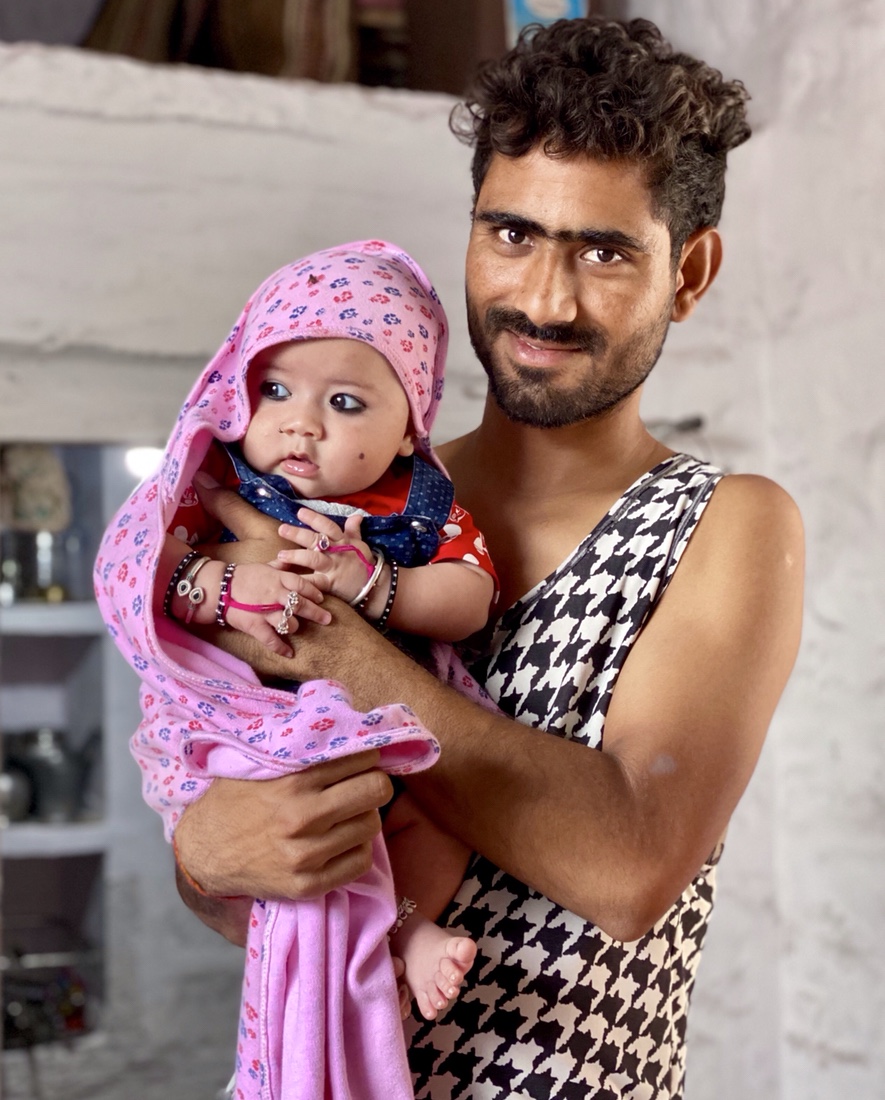 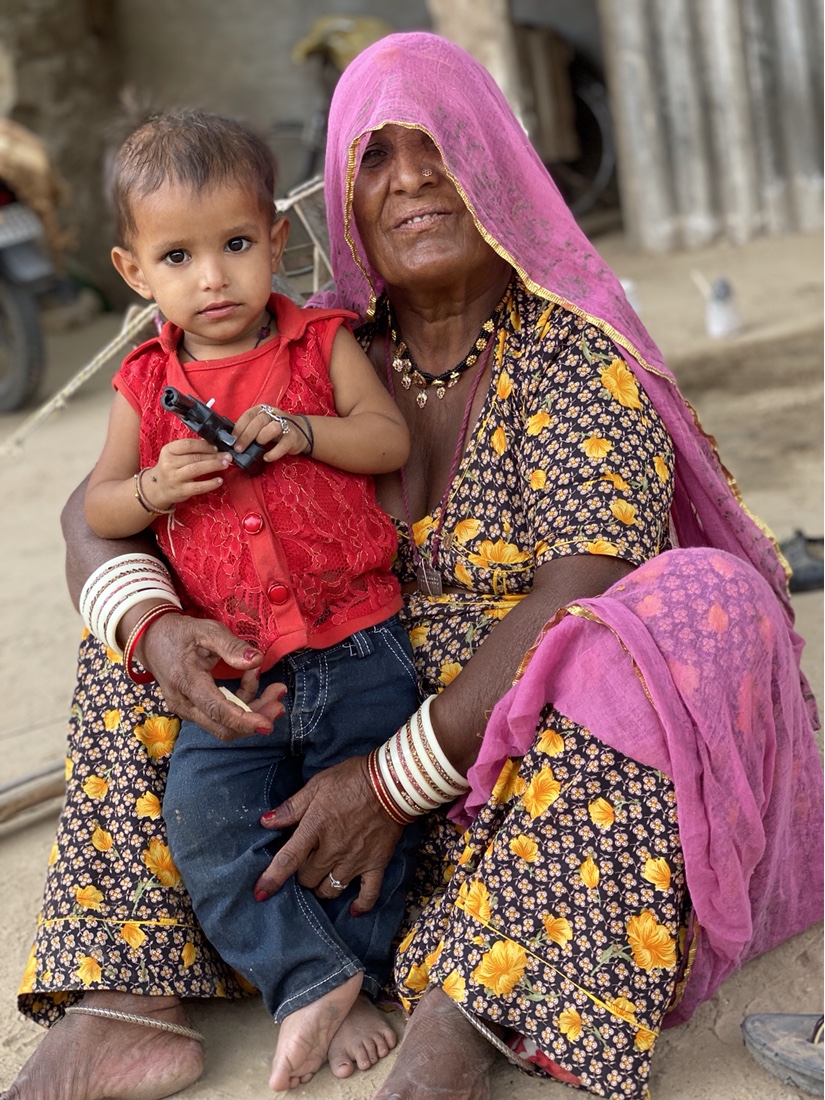 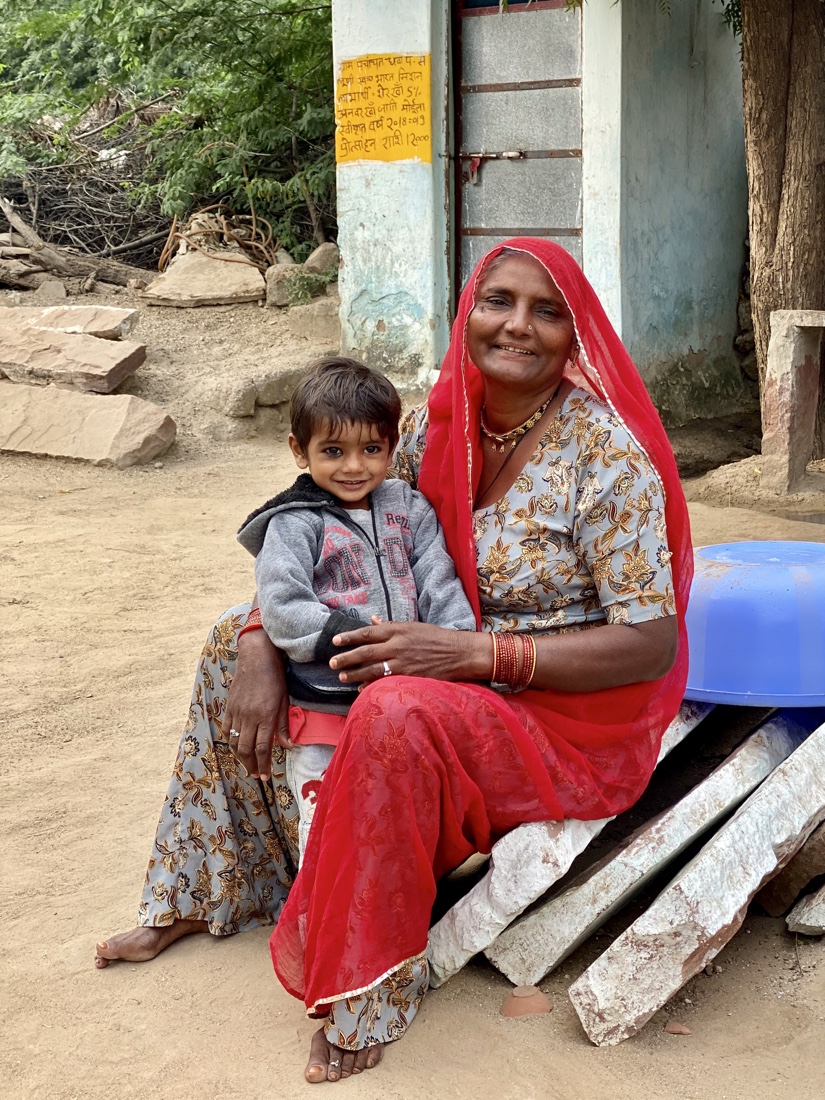 We tour have lunch with the local “Thakur” the equivalent of the village head, Ajai Singh and his wife, a very erudite couple. He shares with us the 200-year history of ownership of the house he now lives in, having restored it from rubble and recently converted it to a lovely 4-room guest house, from which visitors can walk into and almost become part of the village. Very neat. He walks us around the property, pointing out historical remnants. An extra bonus is that his lawyer daughter, Darshika, who works for a large Japanese company in New Delhi, is in for Diwali, so we get to visit with her as well. We tour have lunch with the local “Thakur” the equivalent of the village head, Ajai Singh and his wife, a very erudite couple. He shares with us the 200-year history of ownership of the house he now lives in, having restored it from rubble and recently converted it to a lovely 4-room guest house, from which visitors can walk into and almost become part of the village. Very neat. He walks us around the property, pointing out historical remnants. An extra bonus is that his lawyer daughter, Darshika, who works for a large Japanese company in New Delhi, is in for Diwali, so we get to visit with her as well.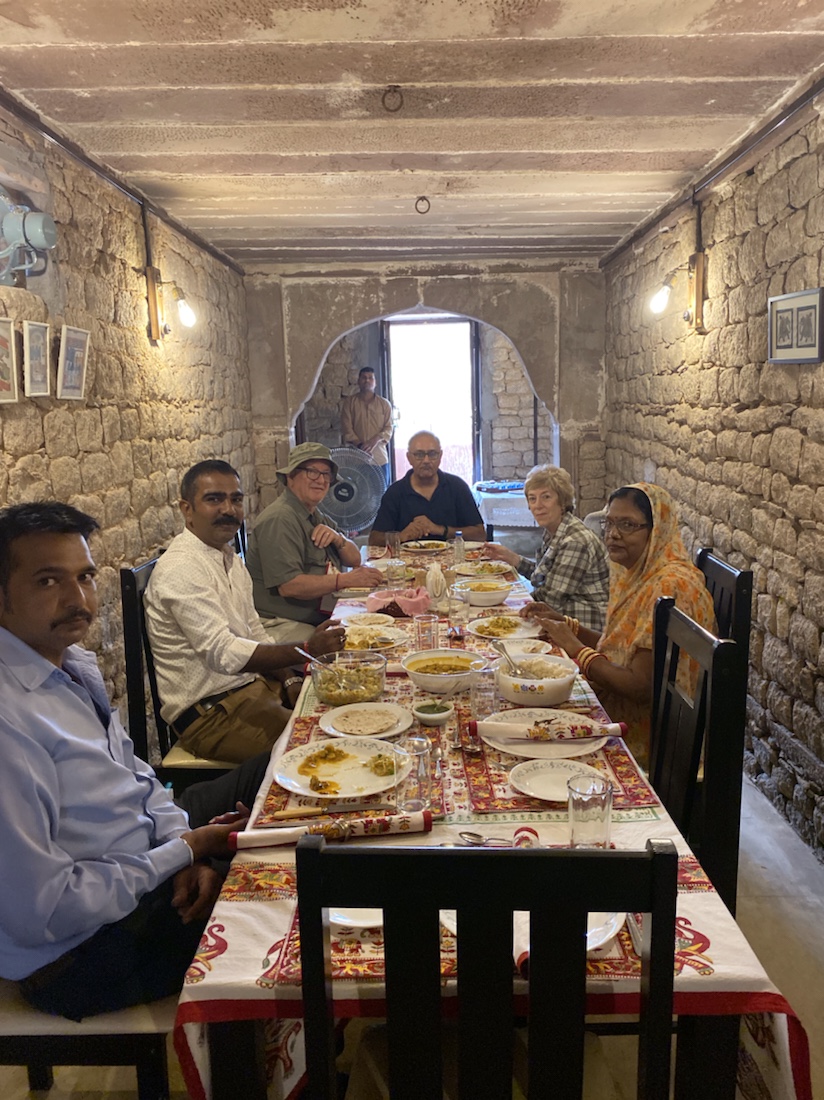 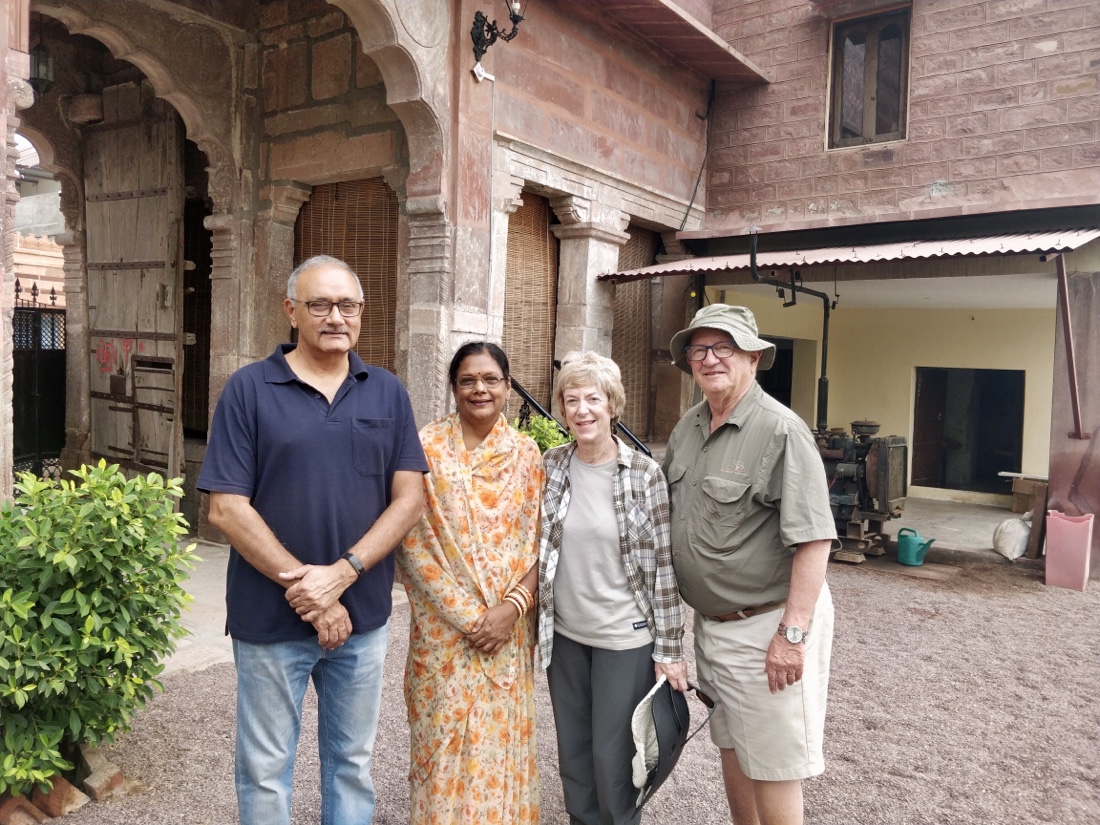 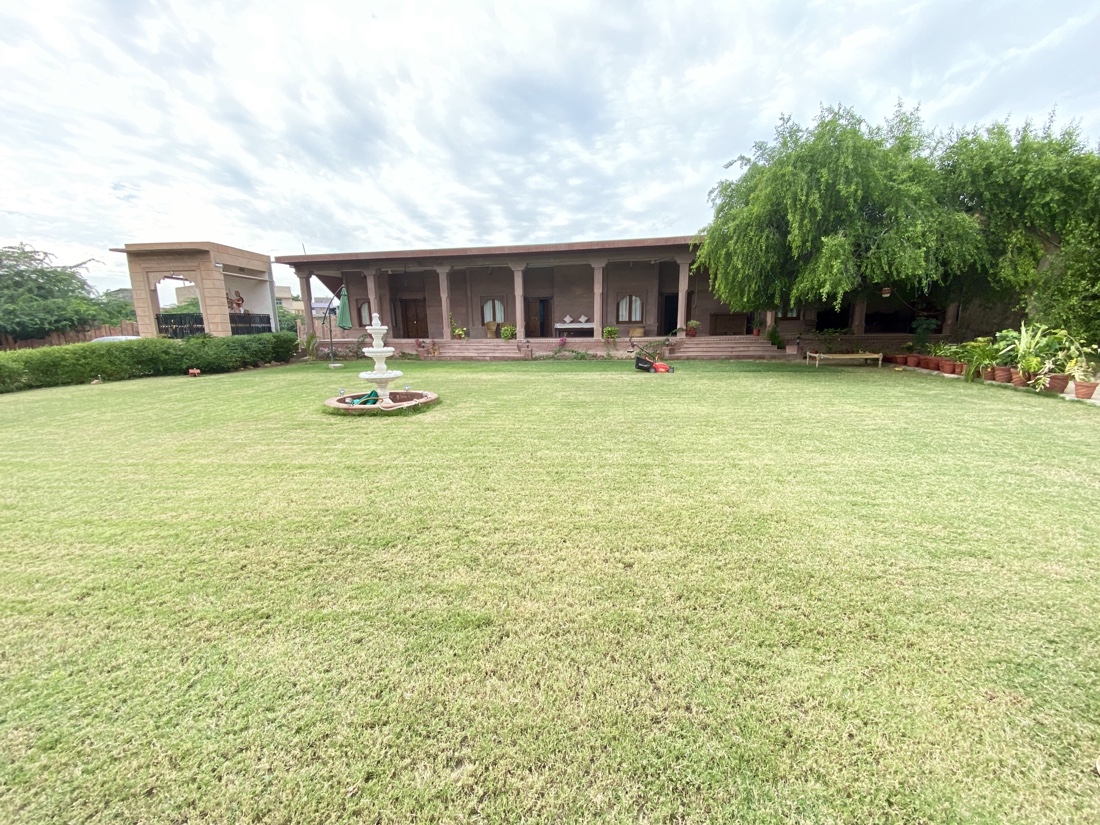
We drove back into Jodhpur and stopped at an enormous place that had textile and art of all kinds. Did a little damage, as we succumbed to the smooth presentation of an owner. Avoided any damage at a jewelry store, though.
Returned to the hotel, where I swam and used the hot tub and steam room Well, I mean, I deserved it, didn’t I, after a tough day? Had dinner in the hotel. While the dinner was fine, it wasn’t great. The setting, though, overlooking the lit palace gardens, with Diwali fireworks providing a profusion of color in the distance and flute music wafting up from below, was outstanding. Went back to our room, er, suite, and packed.
Forts, palaces, temples and markets are fine, but I’ll take a day wandering around a village over all of them.
(Headed to the desert, so may be no posts for a couple days. Try to deal with it.)
|
|











 So, if you’ve been to India, seen the Taj, but missed Bullet Baba, that’s a damn shame. We saw it only because our driver from Jawai to the Jodhpur airport, Manu, knew about it and asked whether we’d like to stop. Of course, we would. One of the things I love about India is that there are thousands of tales of Bullet Babas to be found, each of them ardently believed and deeply meaningful to the faithful.
So, if you’ve been to India, seen the Taj, but missed Bullet Baba, that’s a damn shame. We saw it only because our driver from Jawai to the Jodhpur airport, Manu, knew about it and asked whether we’d like to stop. Of course, we would. One of the things I love about India is that there are thousands of tales of Bullet Babas to be found, each of them ardently believed and deeply meaningful to the faithful.
 We go down to one of the four restaurants for dinner, then relax and retire.
We go down to one of the four restaurants for dinner, then relax and retire.

 And interesting, very friendly people.
And interesting, very friendly people. 


 Such a pleasure to be riding around in the Jeep.
Such a pleasure to be riding around in the Jeep. After I have breakfast (Carol is waiting for lunch to eat), we set off with our ranger, Ram, and an employee of our hotel who comes from the village we’ll be visiting, first to find and walk with a shepherd
After I have breakfast (Carol is waiting for lunch to eat), we set off with our ranger, Ram, and an employee of our hotel who comes from the village we’ll be visiting, first to find and walk with a shepherd  and, after we get the hang of shepherding, to give him a few pointers.
and, after we get the hang of shepherding, to give him a few pointers.  Some goats go to considerable length to reach their food.
Some goats go to considerable length to reach their food.

 climb up to see a temple, busy with Diwali visitors
climb up to see a temple, busy with Diwali visitors 
 and happen upon men playing a kind of dice game.
and happen upon men playing a kind of dice game.  We are not the only ones interested in taking photos of interesting-looking people; we are often the subject matter.
We are not the only ones interested in taking photos of interesting-looking people; we are often the subject matter. It’s gotten quite hot, so we are happy to return to the camp, where Carol has lunch and I go for a swim, before departing on our 4:30 game drive, once again searching for leopards among the craggy rocks. As we start out, it begins to drizzle, and Ram considers turning back to camp, but we continue.
It’s gotten quite hot, so we are happy to return to the camp, where Carol has lunch and I go for a swim, before departing on our 4:30 game drive, once again searching for leopards among the craggy rocks. As we start out, it begins to drizzle, and Ram considers turning back to camp, but we continue.

 After tonight’s sighting, in a stunningly sensible decision, Carol and I decide not to arise at 5:30 tomorrow for a final game drive, but to sleep in, and pack and have breakfast at leisure. Pretty mature, huh?
After tonight’s sighting, in a stunningly sensible decision, Carol and I decide not to arise at 5:30 tomorrow for a final game drive, but to sleep in, and pack and have breakfast at leisure. Pretty mature, huh? And a view of the front of our palace.
And a view of the front of our palace. Of all the many forts in Rajasthan, very few compare to majesty of the Mehrangarh Fort. The fort is divided into three sections – the public areas, the Maharajas palaces, and the zenana, or queens’ palaces. The zenana is decorated with exquisite sandstone filigree work. Here are views of and from the fort.
Of all the many forts in Rajasthan, very few compare to majesty of the Mehrangarh Fort. The fort is divided into three sections – the public areas, the Maharajas palaces, and the zenana, or queens’ palaces. The zenana is decorated with exquisite sandstone filigree work. Here are views of and from the fort.


 which among its varied exhibits has an excellent collection of royal palanquins and the howdah section which has perhaps the finest collection of old ornate elephant howdahs in the world.
which among its varied exhibits has an excellent collection of royal palanquins and the howdah section which has perhaps the finest collection of old ornate elephant howdahs in the world.  Carol and I are blown away by the incredible color, detail and artistry of the miniature paintings.
Carol and I are blown away by the incredible color, detail and artistry of the miniature paintings.



 Carol, of course, liked the park, though she admitted that it wasn’t exactly comfortable.
Carol, of course, liked the park, though she admitted that it wasn’t exactly comfortable. He offers us a taste and, after accepting, we begin to look like this.
He offers us a taste and, after accepting, we begin to look like this. Here are photos of the outside and inside of our tea maker’s house.
Here are photos of the outside and inside of our tea maker’s house.

 We also stop to see an excellent rug weaver nearby. Carol resists buying any, just because we have no conceivable place to use them.
We also stop to see an excellent rug weaver nearby. Carol resists buying any, just because we have no conceivable place to use them.  This decision seems to me to lack imagination, but, being the compliant husband that I am, I accede.
This decision seems to me to lack imagination, but, being the compliant husband that I am, I accede. And here are some folks on a motorcycle, stopped at a railroad crossing, where a crowd has gathered, because a few hours earlier, somebody had been struck and killed by a train.
And here are some folks on a motorcycle, stopped at a railroad crossing, where a crowd has gathered, because a few hours earlier, somebody had been struck and killed by a train. We stay at Hotel Jawai, in African style tents with wonderful views of the grasslands and the landscape. Here’s the backdrop for the camp.
We stay at Hotel Jawai, in African style tents with wonderful views of the grasslands and the landscape. Here’s the backdrop for the camp.


 We first visit the Bishnoi tribe who are regarded as the first environment conservationists of the world, and have been preserving the flora and fauna for the past 550 years as a sacred tenet of their religion. They live in a small “Dhani” or settlement of mud and stick huts, one of many that dot the desert region of Marwar. They are resourceful in storing things in the sticks of their huts for ready access.
We first visit the Bishnoi tribe who are regarded as the first environment conservationists of the world, and have been preserving the flora and fauna for the past 550 years as a sacred tenet of their religion. They live in a small “Dhani” or settlement of mud and stick huts, one of many that dot the desert region of Marwar. They are resourceful in storing things in the sticks of their huts for ready access.


 We also see the thriving cottage industry in a region where skills of the hands earned more than farming in this inhospitable land. We stop at small workshops doing pottery
We also see the thriving cottage industry in a region where skills of the hands earned more than farming in this inhospitable land. We stop at small workshops doing pottery 

 embroidered jootis (camel leather shoes),
embroidered jootis (camel leather shoes), 

 the famous pattu weaving
the famous pattu weaving 




 and embroidery
and embroidery 


 We tour have lunch with the local “Thakur” the equivalent of the village head, Ajai Singh and his wife, a very erudite couple. He shares with us the 200-year history of ownership of the house he now lives in, having restored it from rubble and recently converted it to a lovely 4-room guest house, from which visitors can walk into and almost become part of the village. Very neat. He walks us around the property, pointing out historical remnants. An extra bonus is that his lawyer daughter, Darshika, who works for a large Japanese company in New Delhi, is in for Diwali, so we get to visit with her as well.
We tour have lunch with the local “Thakur” the equivalent of the village head, Ajai Singh and his wife, a very erudite couple. He shares with us the 200-year history of ownership of the house he now lives in, having restored it from rubble and recently converted it to a lovely 4-room guest house, from which visitors can walk into and almost become part of the village. Very neat. He walks us around the property, pointing out historical remnants. An extra bonus is that his lawyer daughter, Darshika, who works for a large Japanese company in New Delhi, is in for Diwali, so we get to visit with her as well.


